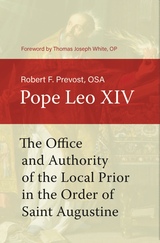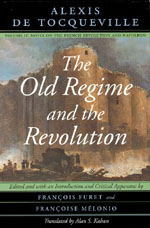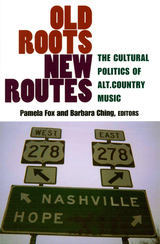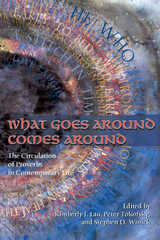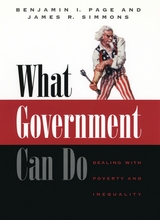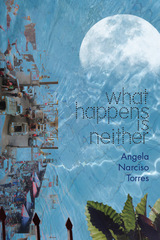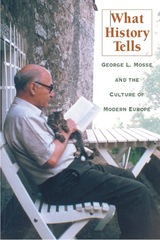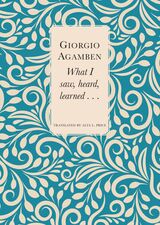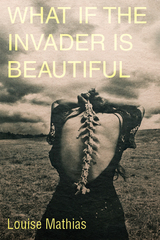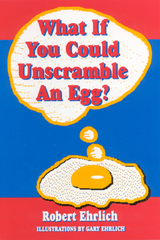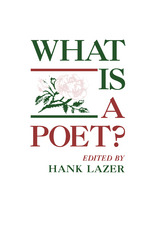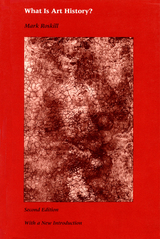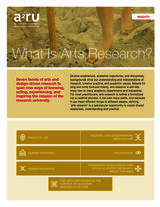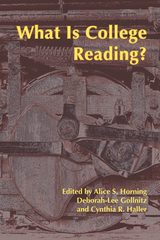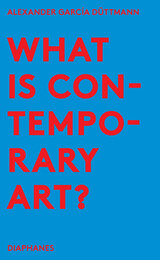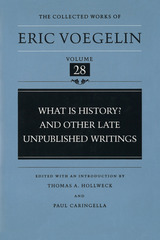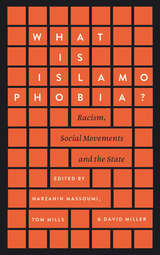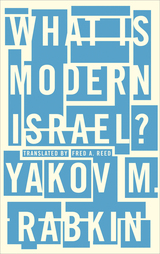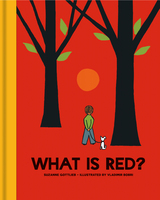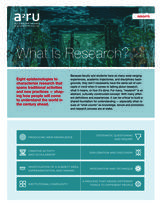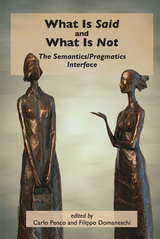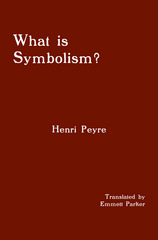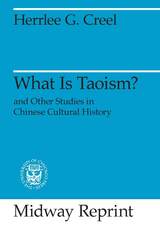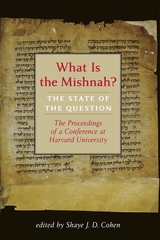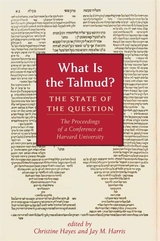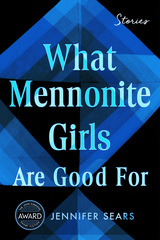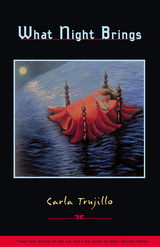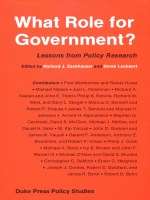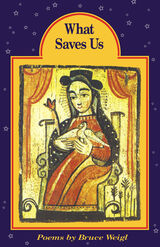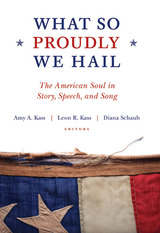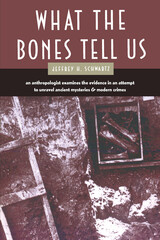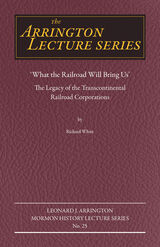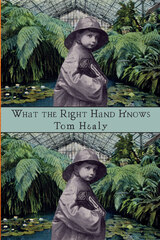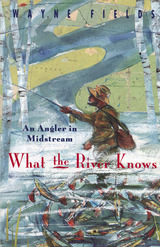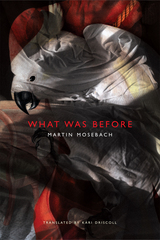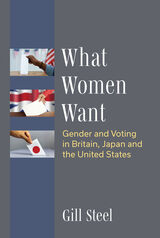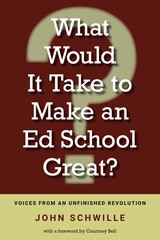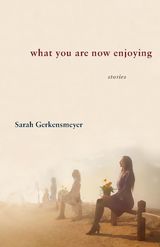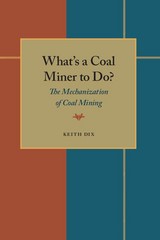What Goes Around Comes Around
edited by Kimberly J. Lau, Peter Tokofsky, and Stephen Winick
Utah State University Press, 2004 In this collection of essays prominent folklorists look at varied modern uses and contexts of proverbs and proverbial speech, some traditional and conventional, others new and unexpected. After the editors' introduction discussing the history and status of attempts to define proverbs, describing their contemporary circulation, and acknowledging the especially important work of paremiologist Wolfgang Meider, the contributions examine the continuing pervasiveness and idiomatic relevance of proverbs in modern culture.
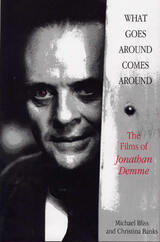 What Goes Around Comes Around: The Films of Jonathan Demme
Michael Bliss and Christina Banks
Southern Illinois University Press, 1996
This first book on the director of The Silence of the Lambs and Philadelphia is comprehensive, analyzing each of Jonathan Demme’s thirteen films.
Demme received the 1980 New York Film Critics Award as Best Director for Melvin and Howard. Subsequent Demme films such as Something Wild and the Talking Heads concert film Stop Making Sense, which won the National Society of Film Critics Award for Best Documentary, made Demme a cult favorite in the league of Roger Corman.
With 199l’s The Silence of the Lambs, Demme moved into a different league. The top-grossing film of the year, Silence won five Academy Awards, becoming the first film to sweep the Best Director, Actor, Actress, and Picture categories since 1975’s One Flew Over the Cuckoo’s Nest. Philadelphia also has been a top-grossing film, with Tom Hanks winning 1994’s Best Actor Oscar.
Michael Bliss and Christina Banks include a wealth of biographical and critical data; an exclusive interview with Demme; the only on-set report on the filming of The Silence of the Lambs; an interview with Craig McKay, Demme’s Emmy-winning film editor; a bibliography; and a Demme filmography. Many of the book’s movie still illustrations have never been published.
 What Good Are Bugs?: Insects in the Web of Life
Gilbert Waldbauer
Harvard University Press, 2003 We shriek about them, slap and spray them, and generally think of insects (when we think of them at all) as pests. Yet, if all insects, or even a critical few, were to disappear--if there were none to pollinate plants, serve as food for other animals, dispose of dead organisms, and perform other ecologically essential tasks--virtually all the ecosystems on earth, the webs of life, would unravel. This book, the first to catalogue ecologically important insects by their roles, gives us an enlightening look at how insects work in ecosystems--what they do, how they live, and how they make life as we know it possible.
In What Good Are Bugs? Gilbert Waldbauer combines anecdotes from entomological history with insights into the intimate workings of the natural world, describing the intriguing and sometimes amazing behavior of these tiny creatures. He weaves a colorful, richly textured picture of beneficial insect life on earth, from ants sowing their "hanging gardens" on Amazonian shrubs and trees to the sacred scarab of ancient Egypt burying balls of cattle dung full of undigested seeds, from the cactus-eating caterpillar (aptly called Cactoblastis) controlling the spread of the prickly pear to the prodigious honey bee and the "sanitary officers of the field"--the fly maggots, ants, beetles, and caterpillars that help decompose and recycle dung, carrion, and dead plants. As entertaining as it is informative, this charmingly illustrated volume captures the full sweep of insects' integral place in the web of life.
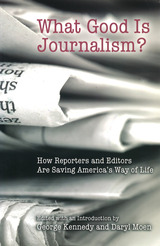 What Good Is Journalism?: How Reporters and Editors Are Saving America's Way of Life
George Kennedy and Daryl Moen
University of Missouri Press, 2007 To go by today’s critics of the news media—who have created a virtual cottage industry—American journalism has reached a nadir. Yet with all its well-documented faults, journalism is vital to the health of our democracy, the glue of information that holds this complex nation together. This book shows the most important roles that journalism plays in the world’s oldest democracy. Two seasoned educators and practitioners of journalism have assembled a team of writers who look beyond the critics to show that there is much to be praised about the state of American journalism today. Journalism tells us most of what we know about the world beyond our own experience by going where its audience cannot or will not. It keeps watch on the government and other powerful institutions, exposes wrongdoing and injustice, and shares the endless fascinations of everyday life. Through stories of real people, this book forcefully argues that American journalism is better than its critics admit and a force for good in the lives of both individuals and the nation. Like the exemplary journalism it describes, it offers dozens of instances that show how good journalistic practices enrich the daily lives of citizens and enable them to play their own roles in the democracy. These essays offer a multifaceted view of the press, tracing the development of free expression through American history and showing how the principles of journalism that we take for granted are playing a revolutionary role in emerging democracies. They report the results of a unique national survey—undertaken for this book—revealing how Americans really view and use the press, and cite the successes of good reporting, from hometown newspapers to NPR. They show how investigative journalism and computer-assisted reporting unearth important truths and even create new knowledge and suggest how citizens can demand the good journalism they need. What good is journalism? This book spells out the answer through a conversation about journalism and democracy that offers both an antidote to the recent storm of ideologically based criticism of “liberal media” and a demonstration of the true worth of an institution essential to the protection of freedom. It provides today’s readers—and tomorrow’s journalists—a fresh perspective on the press to remind us where we would be without it.
What Government Can Do: Dealing with Poverty and Inequality
Benjamin I. Page and James R. Simmons
University of Chicago Press, 2000 It is often said that the federal government cannot or should not attempt to address America's problems of poverty and inequality—because its bureaucracy is wasteful or its programs ineffective. But is this true? In this book, Benjamin I. Page and James R. Simmons examine a number of federal and local programs, detailing what government action already does for its citizens and assessing how efficient it is at solving the problems it seeks to address. Their conclusion, surprisingly, is the polar opposite of the prevailing rhetoric—What Government Can Do is an insightful and compelling argument that it both can and should do more.
What Had Happened Was
Therí Alyce Pickens
Duke University Press, 2025 In her debut poetry collection, What Had Happened Was, Therí Alyce Pickens investigates the complex structures of Black storytelling. Addressing topics ranging from Black life, popular culture, and history to individual encounters with emotion, love, and chronic disability, Pickens crafts and questions the stories we tell ourselves about who we are and who we want to be. Throughout, Pickens mines the formal structures and the play of Black English within the lives and afterlives of Harriet Tubman, Mary J. Blige, Lil' Kim, Breonna Taylor, and figments of our collective imagination. Her singular poetic voice effortlessly flows between what she knows and what she’s heard and between everyday Black conversation and her work in cultural criticism and disability studies. Traveling at the speed of thought, Pickens explores a praxis of storytelling governed by the places where truths and fables kiss.
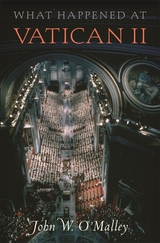 What Happened at Vatican II
John W. O'Malley
Harvard University Press, 2008 During four years in session, Vatican Council II held television audiences rapt with its elegant, magnificently choreographed public ceremonies, while its debates generated front-page news on a near-weekly basis. By virtually any assessment, it was the most important religious event of the twentieth century, with repercussions that reached far beyond the Catholic church. Remarkably enough, this is the first book, solidly based on official documentation, to give a brief, readable account of the council from the moment Pope John XXIII announced it on January 25, 1959, until its conclusion on December 8, 1965; and to locate the issues that emerge in this narrative in their contexts, large and small, historical and theological, thereby providing keys for grasping what the council hoped to accomplish.
What Happened at Vatican II captures the drama of the council, depicting the colorful characters involved and their clashes with one another. The book also offers a new set of interpretive categories for understanding the council’s dynamics—categories that move beyond the tired “progressive” and “conservative” labels. As we approach the fiftieth anniversary of the calling of the council, this work reveals in a new way the spirit of Vatican II. A reliable, even-handed introduction to the council, the book is a critical resource for understanding the Catholic church today, including the pontificate of Benedict XVI.
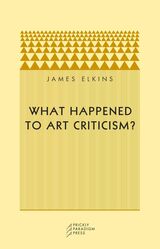 What Happened to Art Criticism?
James Elkins
Prickly Paradigm Press, 2003 Art criticism was once passionate, polemical, and judgmental; now critics are more often interested in ambiguity, neutrality, and nuanced description. And while art criticism is ubiquitous in newspapers, magazines, and exhibition brochures, it is also virtually absent from academic writing. How is it that even as criticism drifts away from academia, it becomes more academic? How is it that sifting through a countless array of colorful periodicals and catalogs makes criticism seem to slip even further from our grasp? In this pamphlet, James Elkins surveys the last fifty years of art criticism, proposing some interesting explanations for these startling changes.
"In What Happened to Art Criticism?, art historian James Elkins sounds the alarm about the perilous state of that craft, which he believes is 'In worldwide crisis . . . dissolving into the background clutter of ephemeral cultural criticism' even as more and more people are doing it. 'It's dying, but it's everywhere . . . massively produced, and massively ignored.' Those who pay attention to other sorts of criticism may recognize the problems Elkins describes: 'Local judgments are preferred to wider ones, and recently judgments themselves have even come to seem inappropriate. In their place critics proffer informal opinions or transitory thoughts, and they shy from strong commitments.' What he'd like to see more of: ambitious judgment, reflection about judgment itself, and 'criticism important enough to count as history, and vice versa.' Amen to that."—Jennifer Howard, Washington Post Book World
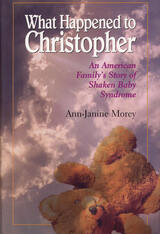 What Happened to Christopher: An American Family's Story of Shaken Baby Syndrome
Ann-Janine Morey. Foreword by M. Joan McDermott
Southern Illinois University Press, 1998 A tragedy and a trial placed Ann-Janine Morey in an ideal position to write this wrenching exploration of the havoc wreaked on a family by Shaken Baby Syndrome. As an alternate juror in a 1995 murder trial in Murphysboro, Illinois, she observed a case that has become too common: that of an adult caregiver shaking to death a baby. A seasoned researcher and published scholar, in this book Morey witnesses the court proceedings firsthand, comes to know the families of the toddler intimately, and augments her observations and interviews through research into Shaken Baby Syndrome. The result is an agonizingly human tale supported by the evidence of science, sociology, and criminology. Morey's What Happened to Christopher memorializes the short life of nineteen-month-old Christopher Attig (1992–1994). To reveal what Christopher meant to those closest to him, Morey conducts extensive interviews with the child's parents and grand-parents. She also interviews the officials involved in the case to set the scene from a legal and police angle. Gary Lynn Gould, who was convicted of and imprisoned for killing Christopher, did not answer Morey's requests for interviews. Morey characterizes her investigation as a "story of quiet horror because it takes place in a way and a setting that could be any town and many families." Nonetheless, Morey's narrative skill transforms Christopher into much more than an ordinary child, senselessly slain. He is Christopher, irreplaceable and unique. And by the time she reconstructs Christopher's final days and the aftermath of his murder, Morey has depicted the principals in the case so deftly and imbued them with such humanity that we experience their torment and their hope. Morey also provides a juror's insight into the trial. By showing what happened to Christopher Attig and by presenting the accumulated findings relative to Shaken Baby Syndrome, she seeks through education to help prevent future deaths like Christopher's.
What Happens in Literature
Edward W. Rosenheim Jr.
University of Chicago Press, 2000 How can we become good readers? In this classic handbook, Edward W. Rosenheim lays out the basics that can help us all become sharper, more proficient readers. Looking at specific poems, novels, and plays, this excellent critical guide raises questions and offers suggestions designed to make us think more and enjoy more fully what we are reading. Designed for students of literature as well as those who simply like to read, What Happens in Literature helps readers appreciate literary works as unique creations, born in a particular time and place, but powerful enough to speak across centuries.
What Happens Is Neither
Angela Narciso Torres
Four Way Books, 2021 A deeply-sensorial reflection on presence, absence, and the act of losing
“What Happens Is Neither / the end nor the beginning. / Yet we’re wired to look for signs,” offers the speaker of Angela Narciso Torres’s latest collection, which approaches motherhood, aging, and mourning through a series of careful meditations. In music, mantra, and prayer, Torres explores the spaces in and around grief—in varying proximity to it and from different vantage points. She writes both structurally formal poems that enfold the emotionality of loss and free verse that loosens the latch on memory and lets us into the sensory worlds of the speaker’s childhood and present. In poems set in two countries and homes, Torres considers what it means to leave a mark, vanish, and stay in one place. In a profound act of recollection and preservation, Torres shows us how to release part of ourselves but remain whole
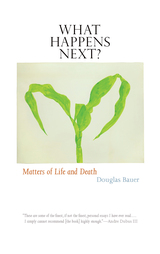 What Happens Next?: Matters of Life and Death
Douglas Bauer
University of Iowa Press, 2013 What is life about but the continuous posing of the questions: what happens next, and what do we make of it when it arrives? In these highly evocative personal essays, Douglas Bauer weaves together the stories of his own and his parents’ lives, the meals they ate, the work and rewards and regrets that defined them, and the inevitable betrayal by their bodies as they aged.
His collection features at its center a long and memory-rich piece seasoned with sensory descriptions of the midday dinners his mother cooked for her farmer husband and father-in-law every noon for many years. It’s this memoir in miniature that sets the table for the other stories that surround it—of love and bitterness, of hungers served and denied. Good food and marvelous meals would take on other revelatory meanings for Bauer as a young man, when he met, became lifelong friends with, and was tutored in the pleasures of an appetite for life by M. F. K. Fisher, the century’s finest writer in English on “the art of eating,” to borrow one of her titles.
The unavoidable companion of the sensual joys of food and friendship is the fragility and ultimately the mortality of the body. As a teenager, Bauer courted sports injuries to impress others, sometimes with his toughness and other times with his vulnerability. And as happens to all of us, eventually his body began to show the common signs of wear—cataracts, an irregular heartbeat, an arthritic knee. That these events might mark the arc of his life became clear when his mother, a few months shy of eighty-seven, slipped on some ice and injured herself.
In these clear-eyed, wry and graceful essays, Douglas Bauer presents with candor and humor the dual calendars of his own mortality and that of his aging parents, evoking the regrets and affirmations inherent in being human.
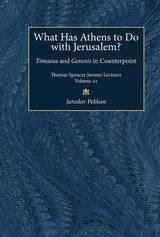 What Has Athens to Do with Jerusalem?: Timaeus and Genesis in Counterpoint
Jaroslav Pelikan
University of Michigan Press, 1997 The debate about evolution and creationism is striking evidence of the tensions between biblical and philosophical-scientific explanations of the origins of the universe. For most of the past twenty centuries, important historical context for the debate has been supplied by the relation (or "counterpoint") between two monumental texts: Plato's Timaeus and the Book of Genesis. In What Has Athens to Do with Jerusalem?, Jaroslav Pelikan examines the origins of this counterpoint. He reviews the central philosophical issues of origins as posed in classical Rome by Lucretius, and he then proceeds to an examination of Timaeus and Genesis, with Timaeus' Plato representing Athens and Genesis' Moses representing Jerusalem. He then follows the three most important case studies of the counterpoint--in the Jewish philosophical theology of Alexandria, in the Christian thought of Constantinople, and in the intellectual foundations of the Western Middles Ages represented by Catholic Rome, where Timaeus would be the only Platonic dialogue in general circulation. Whatever Plato may have intended originally in writing Timaeus, it has for most of the intervening period been read in the light of Genesis. Conversely, Genesis has been known, not in the original Hebrew, but in Greek and Latin translations that were seen to bear a distinct resemblance to one another and to the Latin version of Timaeus. Pelikan's study leads to original findings that deal with Christian doctrine in the period of the church fathers, including the Three Cappadocians (Basil of Caesarea, Gregory of Nazianzus, and Gregory of Nyssa) in the East, and in the West, Ambrose, Augustine, and Boethius. All of these vitally important authors addressed the problem of the "counterpoint," and neither they nor these primary texts can become fully intelligible without attention to the central issues being explored here. What Has Athens to Do with Jerusalem? will be of interest to historians, theologians, and philosophers and to anyone with interest in any of the religious traditions addressed herein.
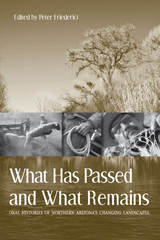 What Has Passed and What Remains: Oral Histories of Northern Arizona's Changing Landscapes
Edited by Peter Friederici
University of Arizona Press, 2010 Ferrell Secakuku remembers the ancient farming rites of his Hopi people but saw them replaced by a cash economy. Sheep rancher Joe Manterola recalls watching hard scrabble farms on what is now tree-studded grassland on Garland Prairie. Navajo Rose Gishie once saw freshly dug holes fill with clean, drinkable water where none rises today. All over northern Arizona, people have seen the landscapes change, and livelihoods with them. In this remarkable book they share their stories.
Thirteen narratives—from ranchers, foresters, scientists, Native American farmers, and others—tell how northern Arizona landscapes and livelihoods reflect rapid social and environmental change. The twentieth century saw huge changes as Arizona’s human population swelled and vacation-home developments arose in the backcountry. Riparian areas dried up, cattle ranching declined, and some wildlife species vanished while others thrived. The people whose words are preserved here have watched it all happen.
The book is a product of Northern Arizona University’s Ecological Oral Histories project, which has been collecting remembrances of long-time area residents who have observed changes to the land from the 1930s to the present day. It carves a wide swath, from the Arizona Strip to the Mogollon Rim, from valleys near Prescott to the New Mexico line. It takes readers to the Bar Heart Ranch north of Williams and to the Doy Reidhead Ranch southeast of Holbrook, to the forests of Flagstaff and the mesas of Indian country.
Enhanced with more than fifty illustrations, this book brings environmental change down to earth by allowing us to see it through the eyes of those whose lives it has directly touched. What Has Passed and What Remains is a window on the past that carries important lessons for the future.
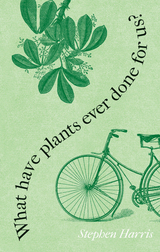 What Have Plants Ever Done for Us?: Western Civilization in Fifty Plants
Stephen Harris
Bodleian Library Publishing, 2015 Plants are an indispensable part of our everyday lives. From the coffee bean that gets roasted for our morning brew to the grasses that feed the animals we eat to the rubber tree that provides the raw materials used in the tires of our cars, we depend on plants for nearly every aspect of our lives.
With What Have Plants Ever Done for Us?, Stephen Harris takes readers step by chronological step through the role of plants in the rise of the Western world, with sojourns through the history of trade, travel, politics, chemistry, and medicine. Plants are our most important food source. Some, such as barley, have been staples since the earliest times. Others, like the oil palm, are relative newcomers to the Western world. Over time, the ways we use some plants has also dramatically changed: Beets, a familiar sight on the dinner plate, were once thought to be an effective treatment for leprosy and now show significant promise as a sustainable biofuel. What, one wonders, might the future thus hold for the mandrake or woad? Plants have also held potent cures to some of our most prevalent diseases. An extract from the bark of the yew tree, for instance, is commonly used in the treatment of cancer.
Wide-ranging and thoroughly engaging, What Have Plants Ever Done for Us? will help readers cultivate a deeper appreciation for our branched and rooted friends who ask little in return for their vast contributions save for a little care and water.
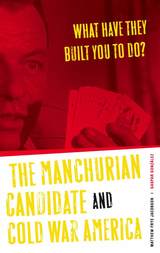 What Have They Built You to Do?: The Manchurian Candidate and Cold War America
Matthew Frye Jacobson
University of Minnesota Press, 2006 Considered by many to be the best political thriller ever made, The Manchurian Candidate is as entertaining, troubling, and relevant today as it was in 1962. Starring Frank Sinatra, Laurence Harvey, and Angela Lansbury, and directed with probing insight by John Frankenheimer, the film was widely acclaimed as a masterpiece. Largely out of circulation for the next two decades, it acquired a well-deserved cult following until it was rereleased during the last year of the Reagan presidency, when its pointed satire of political and media manipulation seemed more timely than ever. In What Have They Built You to Do?—a key line of dialogue from the original film—Matthew Frye Jacobson and Gaspar González undertake an ambitious reexamination of The Manchurian Candidate, the 1959 novel by Richard Condon on which it was based, and—critically analyzed here for the first time—the 2004 remake directed by Jonathan Demme. Based on close readings of the film and broad investigations into the eras in which it was made and rediscovered, the authors decode the many layers of meaning within and surrounding the film, from the contradictions of the Cold War it both embodies and parodies—McCarthyism and Kennedy liberalism, individualism and conformity—to its construction of Asian villains, overbearing women, and male heroes in a society anxious about race, gender, and sexuality. Through their multifaceted analysis of The Manchurian Candidate (in all its incarnations), Jacobson and González raise provocative questions about power and anxiety in American politics and society from the Cold War to today.Matthew Frye Jacobson teaches American studies at Yale University. His books include Roots Too: White Ethnic Revival in Post–Civil Rights America. Gaspar González is an independent scholar and journalist in Miami. He has taught American studies at Yale University and film studies at the University of Miami.
What History Tells: George L. Mosse and the Culture of Modern Europe
Edited by Stanley G. Payne, David J. Sorkin, and John S. Tortorice
University of Wisconsin Press, 2004 What History Tells presents an impressive collection of critical papers from the September 2001 conference "An Historian’s Legacy: George L. Mosse and Recent Research on Fascism, Society, and Culture." This book examines his historiographical legacy first within the context of his own life and the internal development of his work, and secondly by tracing the many ways in which Mosse influenced the subsequent study of contemporary history, European cultural history and modern Jewish history.
The contributors include Walter Laqueur, David Sabean, Johann Sommerville, Emilio Gentile, Roger Griffin, Saul Friedländer, Jay Winter, Rudy Koshar, Robert Nye, Janna Bourke, Shulamit Volkov, and Steven E. Aschheim.
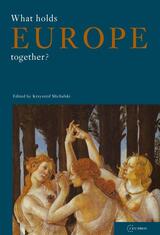 What Holds Europe Together?
Krzysztof Michalski
Central European University Press, 2006 The book addresses contemporary developments in European identity politics as part of a larger historical trajectory of a common European identity based on the idea of 'solidarity.' The authors explain the special sense in which Europeans perceive their obligations to their less fortunate compatriots, to the new East European members, and to the world at large. An understanding of this notion of 'solidarity' is critical to understanding the specific European commitment to social justice and equality. The specificity of this term helps to distinguish between what the Germans call "social state" from the Anglo-Saxon, and particularly American, political and social system focused on capitalism and economic liberalism. This collection is the result of the work of an extremely distinguished group of scholars and politicians, invited by the previous President of the European Union, Romano Prodi, to reflect on some of the most important subjects affecting the future of Europe.
 What I Found Out About Her: Stories of Dreaming Americans
Peter LaSalle
University of Notre Dame Press, 2014 What I Found Out About Her: Stories of Dreaming Americans, winner of the 2014 Richard Sullivan Prize in Short Fiction, reaffirms Peter LaSalle's reputation as one of the most startlingly original writers working in the short fiction genre today. In this collection of eleven stories, LaSalle explores how everyday life for many—an FBI agent, a study-abroad student, a drug dealer's chic girlfriend, a trio of Broadway playwrights, among others—can often take on something much larger than that, almost the texture of a haunting dream. Marked by stylistic daring and a rare lyricism in language, this is intense, thoroughly moving fiction that probes the contemporary American psyche, portraying it in all its frequently painful sadness and also its brave and unflagging hope.
"I've always believed that as a short story writer Peter LaSalle has been in the same class as Donald Barthelme and Joyce Carol Oates in the avant-garde of American fiction writers, and now, reading his new collection, What I Found Out About Her, I am more than confirmed in that belief: indeed, his sophisticated and highly controlled formal experimentation, which is the sparkling core of his style, now flows with such masterly ease that he can be said to be in a class of his own, at the forefront of American creators of original prose." —Zulfikar Ghose, author of The Triple Mirror of the Self
"Peter LaSalle’s stories, set in wonderfully various settings—Buenos Aires, New York, Paris, Chicago—are rich in their delineation of our private lives and loves, and in those moments in which, by ourselves or with others, we live most deeply. These haunting tales are shrewdly original, disarmingly complex, and—always, always, since LaSalle is one of our finest storytellers—as beautifully crafted as they are memorable.” —Jay Neugeboren, author of You Are My Heart and Other Stories
What I Saw, Heard, Learned . . .
Giorgio Agamben
Seagull Books, 2023 An engaging collection of late-life reflections and quick thoughts, a book unlike any other Agamben book.
What can the senses of an attentive philosopher see, hear, and learn that can, in turn, teach us about living better lives? Perhaps it’s less a matter of asking what and more a matter of asking how. These latest reflections from Italy’s foremost philosopher form a sort of travelogue that chronicles Giorgio Agamben’s profound interior journey. Here, with unprecedented immediacy, Agamben shares his final remarks, late-life observations, and reflections about his life that flashed before his eyes. What did he see in that brief flash? What did he stay faithful to? What remains of all those places, friends, and teachers?
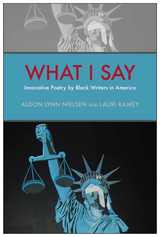 What I Say: Innovative Poetry by Black Writers in America
Aldon Lynn Nielsen
University of Alabama Press, 2015 What I Say: Innovative Poetry by Black Writers in America is the second book in a landmark two-volume anthology that explodes narrow definitions of African American poetry by examining experimental poems often excluded from previous scholarship. The first volume, Every Goodbye Ain’t Gone, covers the period from the end of World War II to the mid-1970s. In What I Say, editors Aldon Lynn Nielsen and Lauri Ramey have assembled a comprehensive and dynamic collection that brings this pivotal work up to the present day.
The elder poets in this collection, such as Nathaniel Mackey, C. S. Giscombe, Will Alexander, and Ron Allen, came of age during and were powerfully influenced by the Black Arts Movement, and What I Say grounds the collection in its black modernist roots. In tracing the fascinating and unexpected paths of experimentation these poets explored, however, Nielsen and Ramey reveal the tight delineations of African American poetry that omitted noncanonical forms. This invigorating panoply of work, when restored, brings into focus the creatively elastic frontiers and multifaceted expressions of contemporary black poetry.
Several of the poets discussed in What I Say forged relationships with members of the L=A=N=G=U=A=G=E poetry movement and participated in the broader community of innovative poetry that emerged in the late 1970s and early 1980s and continues to exert a powerful influence today.
Each volume can stand on its own, and reading them in tandem will provide a clear vision of how innovative African American poetries have evolved across the twentieth century and into the twenty-first. What I Say is infinitely teachable, compelling, and rewarding. It will appeal to a broad readership of poets, poetics teachers, poetics scholars, students of African American literature in nonnarrative forms, Afro-futurism, and what lies between the modern and the contemporary in global and localized writing practices.
What if the Invader Is Beautiful?
Louise Mathias
Four Way Books, 2024 What if the Invader is Beautiful explores the ineffable yet primal connections between outer and inner landscapes — the impact that the natural world has on the psychological terrain of our interior lives. Through compressed, musical, and often deeply mysterious language, the poems enact the extreme outer limits of emotional experience. Often set in equally extreme natural settings, the poems ride the knife edge between beauty and terror — exploring concepts of the sublime, the spiritual power of the elements, the redemptive beauty of flora and fauna, and the psychological freedom of wide-open spaces — and illuminate how deepening our connection to these elements is ultimately what will save us from our human afflictions of separation, isolation, and fear.
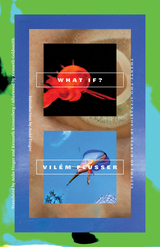 What If?: Twenty-Two Scenarios in Search of Images
Vilém Flusser
University of Minnesota Press, 2022 An imagination of possibilities, of miscalculations, of futures off-kilter
“Probability is a chimera, its head is true, its tail a suggestion. Futurologists attempt to compel the head to eat the tail (ouroboros). Here, though, we will try to wag the tail.” —Vilém Flusser Two years after his Vampyroteuthis Infernalis, the philosopher Vilém Flusser engaged in another thought experiment: a collection of twenty-two “scenarios for the future” to be produced as computer-generated media, or technical images, that would break the imaginative logjam in conceiving the social, political, and economic future of the universe. What If? is not just an “impossible journey” to which Flusser invites us in the first scenario; it functions also as a distorting mirror held up to humanity. Flusser’s disarming scenarios of an Anthropocene fraught with nightmares offer new visions that range from the scientific to the fantastic to the playful and whimsical. Each essay reflects our present sense of understanding the world, considering the exploitation of nature and the dangers of global warming, overpopulation, and blind reliance on the promises of scientific knowledge and invention. What If? offers insight into the radical futures of a slipstream Anthropocene that have much to do with speculative fiction, with Flusser’s concept of design as “crafty” or slippery, and with art and the immense creative potential of failure versus reasonable, “good” computing or calculability. As such, the book is both a warning and a nudge to imagine what we may yet become and be.
What If You Could Unscramble An Egg?
Ehrlich, Robert
Rutgers University Press, 1995 What if there were three sexes? What if men could have babies? What if the earth didn’t have a moon? What if all the air in the room went into one corner? What if you fell into a black hole? What if you could unscramble an egg? Eavesdrop on these free-wheeling conversations and stretch your imagination in 120 different directions! In these flippant “what if” dialogues about everything from sex, aliens, dogs, and dinosaurs to space, matter, and time, Robert Ehrlich blurs the boundaries between science fact and science fiction. Come travel through these zany alternative universes––and understand our own a bit better!
 what I'm on
Luis Humberto Valadez
University of Arizona Press, 2009 Luis Valadez is a performance poet and his poems shout to be read aloud. It’s then that their language dazzles most brightly. It’s then that the emotions bottled up on the page explode beyond words. And there is plenty of emotion in these poems. Frankly autobiographical, they recount the experiences of a Mexican American boy growing up in a tough town near Chicago. Just as in life, the feelings in these poems are often jumbled, sometimes spilling out in a tumble, sometimes coolly recollected. Sometimes the words jump and twitch as if they’d been threatened or attacked. Sometimes they just sit there knowingly on the page, weighted down by the stark reality of it all.
José García
put a thirty-five to me
my mother was in the other room
He would have done us both
if not for the lust of my fear
This new Mexican American/Chicano voice is all at once arresting, bracing, shocking, and refreshing. This is not the poetry you learned in school. It owes as much to hip hop as it does to the canon. But Valadez has paid his academic dues, and he certainly knows how to craft a poem. It’s just that he does it his way.
i anagram and look and subject to deformation and reconfiguring . . .
it ain’t events or blocks that ahm jettisoning through this process
it be layers of meaning, identity, narrative, and ego that gets peeled off
i can only increase my own understanding
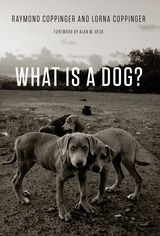 What Is a Dog?
Raymond Coppinger and Lorna Coppinger
University of Chicago Press, 2016 Of the world’s dogs, less than two hundred million are pets, living with humans who provide food, shelter, squeaky toys, and fashionable sweaters. But roaming the planet are four times as many dogs who are their own masters—neighborhood dogs, dump dogs, mountain dogs. They are dogs, not companions, and these dogs, like pigeons or squirrels, are highly adapted scavengers who have evolved to fit particular niches in the vicinity of humans. In What Is a Dog? experts on dog behavior Raymond and Lorna Coppinger present an eye-opening analysis of the evolution and adaptations of these unleashed dogs and what they can reveal about the species as a whole.
Exploring the natural history of these animals, the Coppingers explain how the village dogs of Vietnam, India, Africa, and Mexico are strikingly similar. These feral dogs, argue the Coppingers, are in fact the truly archetypal dogs, nearly uniform in size and shape and incredibly self-sufficient. Drawing on nearly five decades of research, they show how dogs actually domesticated themselves in order to become such efficient scavengers of human refuse. The Coppingers also examine the behavioral characteristics that enable dogs to live successfully and to reproduce, unconstrained by humans, in environments that we ordinarily do not think of as dog friendly.
Providing a fascinating exploration of what it actually means—genetically and behaviorally—to be a dog, What Is a Dog? will undoubtedly change the way any beagle or bulldog owner will reflect on their four-legged friend.
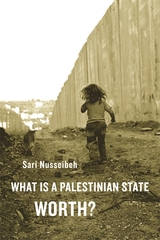 What Is a Palestinian State Worth?
Sari Nusseibeh
Harvard University Press, 2011 “In a display of rationality uncommon to discussions of the Israeli-Palestinian conflict, Nusseibeh takes an impartial vantage point, trying to sort out a mess largely generated by overblown and hyperactive political identities.”—Boston Review
“[This] philosophical and balanced book is unfailingly sensitive and empathetic to both sides.”—Publishers Weekly
Can a devout Jew be a devout Jew and drop the belief in the rebuilding of the Temple? Can a devout Muslim be a devout Muslim and drop the belief in the sacredness of the Rock? Can one right (the right of return) be given up for another (the right to live in peace)? Can one claim Palestinian identity and still retain Israeli citizenship? What is a Palestinian state worth? For over sixty years, the Israeli-Palestinian conflict has been subjected to many solutions and offered many answers by diverse parties. Yet, answers are only as good as the questions that beget them. It is with this simple, but powerful idea, the idea of asking the basic questions anew, that the renowned Palestinian philosopher and activist Sari Nusseibeh begins his book.
What Is a Palestinian State Worth? poses questions about the history, meaning, future, and resolution of the Israel/Palestine conflict. Deeply informed by political philosophy and based on decades of personal involvement with politics and social activism, Nusseibeh’s moderate voice—global in its outlook, yet truly grounded in his native city of Jerusalem—points us toward a future which, as George Lamming once put it, is colonized by our acts in this moment, but which must always remain open.
 What Is a Person?: AN ETHICAL EXPLORATION
James W. Walters
University of Illinois Press, 1997 At a time when technology can sustain marginal life, it is ever more
important to understand what constitutes a person. What are the medical,
ethical, moral, mental, legal, and philosophical criteria that determine
protectable human life?
Following immediately on the publication of his highly praised book Choosing
Who's to Live, James Walters addresses with depth and wisdom another
ambitious and complicated matter: determining the nature of personhood.
By providing a much-needed religious/philosophical context for the discussion--examining
contemporary thinking on just what constitutes valuable life--Walters
broadens his inquiry beyond the human to include other animals and deals
with the phenomenon of anencephalic infants, those who are born without
higher brains.
Searching for a measurable and humane standard of personhood, Walters
looks at the current definition of it and declares it inadequate--offering
instead the idea of proximate personhood, with criteria for helping to
determine which individuals possess a unique claim to life.
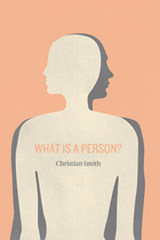 What Is a Person?: Rethinking Humanity, Social Life, and the Moral Good from the Person Up
Christian Smith
University of Chicago Press, 2010 What is a person? This fundamental question is a perennial concern of philosophers and theologians. But, Christian Smith here argues, it also lies at the center of the social scientist’s quest to interpret and explain social life. In this ambitious book, Smith presents a new model for social theory that does justice to the best of our humanistic visions of people, life, and society.
Finding much current thinking on personhood to be confusing or misleading, Smith finds inspiration in critical realism and personalism. Drawing on these ideas, he constructs a theory of personhood that forges a middle path between the extremes of positivist science and relativism. Smith then builds on the work of Pierre Bourdieu, Anthony Giddens, and William Sewell to demonstrate the importance of personhood to our understanding of social structures. From there he broadens his scope to consider how we can know what is good in personal and social life and what sociology can tell us about human rights and dignity.
Innovative, critical, and constructive, What Is a Person? offers an inspiring vision of a social science committed to pursuing causal explanations, interpretive understanding, and general knowledge in the service of truth and the moral good.
What Is A Poet?
Hank Lazer
University of Alabama Press, 1987 This book discusses the extent of distrust and the extent of the misunderstandings that exist in the poetry world.
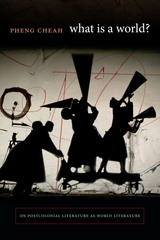 What Is a World?: On Postcolonial Literature as World Literature
Pheng Cheah
Duke University Press, 2016 In What Is a World? Pheng Cheah, a leading theorist of cosmopolitanism, offers the first critical consideration of world literature’s cosmopolitan vocation. Addressing the failure of recent theories of world literature to inquire about the meaning of world, Cheah articulates a normative theory of literature’s world-making power by creatively synthesizing four philosophical accounts of the world as a temporal process: idealism, Marxist materialism, phenomenology, and deconstruction. Literature opens worlds, he provocatively suggests, because it is a force of receptivity. Cheah compellingly argues for postcolonial literature’s exemplarity as world literature through readings of narrative fiction by Michelle Cliff, Amitav Ghosh, Nuruddin Farah, Ninotchka Rosca, and Timothy Mo that show how these texts open up new possibilities for remaking the world by negotiating with the inhuman force that gives time and deploying alternative temporalities to resist capitalist globalization.
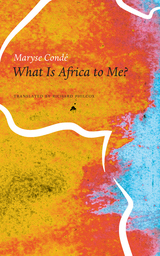 What Is Africa to Me?: Fragments of a True-to-Life Autobiography
Maryse Condé
Seagull Books, 2016 Maryse Condé is one of the best-known and most beloved French Caribbean literary voices. The author of more than twenty novels, she was shortlisted for the Man Booker International Prize in 2015 and has long been recognized as a giant of black feminist literature. While Condé has previously published an autobiography of her childhood, What Is Africa to Me? tells for the first time the story of her early adult years in Africa—years formative not only for her, but also for African colonies appealing for their own independence.
What Is Africa to Me? traces the late 1950s to 1968, chronicling Condé’s life in Sékou Touré’s Guinea to her time in Kwame N’Krumah’s Ghana, where she rubbed shoulders with Malcolm X, Che Guevara, Julius Nyerere, and Maya Angelou. Accusations of subversive activity resulted in Condé’s deportation from Ghana. Settling down in Sénégal, Condé ended her African years with close friends in Dakar, including filmmakers, activists, and Haitian exiles, before putting down more permanent roots in Paris.
Condé’s story is more than one of political upheaval, however; it is also the story of a mother raising four children as she battles steep obstacles, of a Guadeloupean seeking her identity in Africa, and of a young woman searching for her freedom and vocation as a writer. What Is Africa to Me? is a searing portrait of a literary genius—it should not be missed.
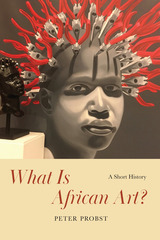 What Is African Art?: A Short History
Peter Probst
University of Chicago Press, 2022 A history of the evolving field of African art.
This book examines the invention and development of African art as an art historical category. It starts with a simple question: What do we mean when we talk about African art? By confronting the historically shifting answers to this question, Peter Probst identifies “African art” as a conceptual vessel that manifests wider societal transformations.
What Is African Art? covers three key stages in the field’s history. Starting with the late nineteenth through the mid-twentieth centuries, the book first discusses the colonial formation of the field by focusing on the role of museums, collectors, and photography in disseminating visual cultures as relations of power. It then explores the remaking of the field at the dawn of African independence with the shift toward contemporary art and the rise of Black Atlantic studies in the 1970s and 1980s. Finally, it examines the post- and decolonial reconfiguration of the field driven by questions of representation, repair, and restitution.
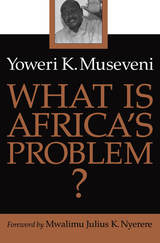 What Is Africa’s Problem
Yoweri K. Museveni
University of Minnesota Press, 2000 The president of Uganda addresses key questions about Africa’s future. Recent seismic shifts in Congo and Rwanda have exposed the continued volatility of the state of affairs in central Africa. As African states have shaken off their postcolonial despots, new leaders with sweeping ideas about a pan-African alliance have emerged-and yet the internecine struggles go on. What is Africa’s problem? As one of the leaders expressing a broad and forceful vision for Africa’s future, Uganda’s Yoweri K. Museveni is perhaps better placed than anyone in the world to address the very question his book poses. In 1986, after more than a decade of armed struggle, a rebellion led by Museveni toppled the dictatorship of Idi Amin, and Museveni, at 42, became president of Uganda, a country at that time in near total disarray. Since then, Uganda has made remarkable strides in political, civic, and economic arenas, and Museveni has assumed the role of "the éminence grise of the new leadership in central Africa" (Philip Gourevitch, New Yorker). As such, he has proven a powerful force for change, not just in Uganda but across the turbulent span of African states.This collection of Museveni’s writings and speeches lays out the possibilities for social change in Africa. Working with a broad historical understanding and an intimate knowledge of the problems at hand, Museveni describes how movements can be formed to foster democracy, how class consciousness can transcend tribal differences in the development of democratic institutions, and how the politics of identity operate in postcolonial Africa. Museveni’s own contributions to the overthrow of Zaire’s Mobutu Sese Seko and to the political transformation of Uganda suggest the kind of change that may sweep Africa in decades to come. What Is Africa’s Problem? gives a firsthand look at what those changes might be, how they might come about, and what they might mean.
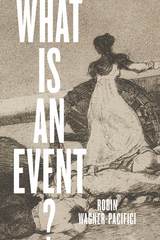 What Is an Event?
Robin Wagner-Pacifici
University of Chicago Press, 2017 We live in a world of breaking news, where at almost any moment our everyday routine can be interrupted by a faraway event. Events are central to the way that individuals and societies experience life. Even life’s inevitable moments—birth, death, love, and war—are almost always a surprise. Inspired by the cataclysmic events of September 11, Robin Wagner-Pacifici presents here a tour de force, an analysis of how events erupt and take off from the ground of ongoing, everyday life, and how they then move across time and landscape.
What Is an Event? ranges across several disciplines, systematically analyzing the ways that events emerge, take shape, gain momentum, flow, and even get bogged down. As an exploration of how events are constructed out of ruptures, it provides a mechanism for understanding eventful forms and flows, from the micro-level of individual life events to the macro-level of historical revolutions, contemporary terrorist attacks, and financial crises. Wagner-Pacifici takes a close look at a number of cases, both real and imagined, through the reports, personal narratives, paintings, iconic images, political posters, sculptures, and novels they generate and through which they live on. What is ultimately at stake for individuals and societies in events, Wagner-Pacifici argues, are identities, loyalties, social relationships, and our very experiences of time and space. What Is an Event? provides a way for us all—as social and political beings living through events, and as analysts reflecting upon them—to better understand what is at stake in the formations and flows of the events that mark and shape our lives.
 What Is Ancient Philosophy?
Pierre Hadot
Harvard University Press, 2002 A magisterial mappa mundi of the terrain that Pierre Hadot has so productively worked for decades, this ambitious work revises our view of ancient philosophy—and in doing so, proposes that we change the way we see philosophy itself. Hadot takes ancient philosophy out of its customary realm of names, dates, and arid abstractions and plants it squarely in the thick of life. Through a meticulous historical reading, he shows how the various schools, trends, and ideas of ancient Greek and Roman philosophy all tended toward one goal: to provide a means for achieving happiness in this life, by transforming the individual’s mode of perceiving and being in the world.
Most pressing for Hadot is the question of how the ancients conceived of philosophy. He argues in great detail, systematically covering the ideas of the earliest Greek thinkers, Hellenistic philosophy, and late antiquity, that ancient philosophers were concerned not just to develop philosophical theories, but to practice philosophy as a way of life—a way of life to be suggested, illuminated, and justified by their philosophical “discourse.” For the ancients, philosophical theory and the philosophical way of life were inseparably linked.
What Is Ancient Philosophy? also explains why this connection broke down, most conspicuously in the case of academic, professional philosophers, especially under the influence of Christianity. Finally, Hadot turns to the question of whether and how this connection might be reestablished. Even as it brings ancient thoughts and thinkers to life, this invigorating work provides direction for those who wish to improve their lives by means of genuine philosophical thought.
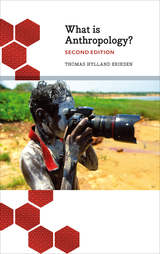 What Is Anthropology?: Second Edition
Thomas Hylland Eriksen
Pluto Press, 2017 When it was first published, What Is Anthropology? immediately ignited the discipline, proving how anthropology can be a revolutionary way of thinking about the modern human world. In this fully updated second edition, Thomas Hylland Eriksen brings together examples from current events as well as within anthropological research in order to explain how to see the world from below and from within—emphasizing the importance of adopting an insider's perspective.
The first section of the book presents the history of anthropology, and the second discusses core issues in greater detail, covering economics, morals, human nature, ecology, cultural relativism, and much more. Throughout, he reveals how seemingly enormous cultural differences actually conceal the deep unity of humanity. Perfect not only for students, but also for those who have never encountered anthropology before, What is Anthropology? presents the discipline in an exciting and innovative way.
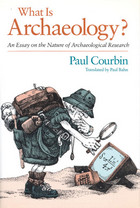 What Is Archaeology?: An Essay on the Nature of Archaeological Research
Paul Courbin
University of Chicago Press, 1988 Paul Courbin puts forward a penetrating and eloquent critique of the New Archeology, a movement of primarily American and British archaeologists that began in the 1960s and continues today. The New Archeologists dropped the "ae" spelling, symbolizing their intent to put the field on a modern and scientific footing. They questioned the bases, the objectives, and consequently the methods of traditional archaeology.
Courbin examines this movement, its latent philosophy, its methods and their application, its theories, and its results. He declares that the record shows a devastating failure. The New Archeologists, he contends, may have developed scientific hypotheses, but in most cases they failed to carry out what is necessary to test their theories, thus contradicting the very goals they had set for the discipline.
Reevaluating the field as a whole, Courbin asks, What is archaeology? He distinguishes it from such related fields as history and anthropology, emphatically arguing that the primary task of archaeology is what the archaeologist alone can accomplish: the establishment of facts—stratigraphies, time sequences, and identification tools, bones, potsherds, and so on. When archaeological findings lead to historical or anthropological conclusions, as they very often do, archaeologists must be aware that this involves a specific change in their work; they are no longer archaeologists proper. The archaeologist's work, Courbin stresses, is not a humble auxiliary of anthropology or history, but the foundation upon which historians and anthropologists of ancient civilizations will build and without which their theories cannot but collapse. What Is Archaeology? was originally published in French in 1982.
What Is Art History?
Mark Roskill
University of Massachusetts Press, 1989 An introduction to the way art history works. A classic in its field, What Is Art History? now appears in a second edition with a new introduction by the author.
What is Arts Research?
Gabriel Harp
A2RU Intervals, 2018 Seven facets of arts and design-driven research to span new ways of knowing, acting, experiencing, and inspiring the mission of the research university.
Diverse experiences, academic trajectories, and disciplinary backgrounds drive our understanding and interpretations of research, creative practice, and academic values. Despite its long and richly textured history, arts research is still relatively new to many academic departments and disciplines. For most practitioners, arts research is neither a formalized nor a codified process; it can take many paths. And because it can mean different things to different people, defining ‘arts research’ is a spectacular opportunity to create shared awareness, understanding and practice.
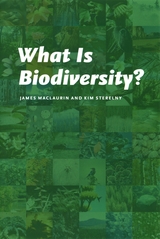 What Is Biodiversity?
James Maclaurin and Kim Sterelny
University of Chicago Press, 2008 In the life sciences, there is wide-ranging debate about biodiversity. While nearly everyone is in favor of biodiversity and its conservation, methods for its assessment vary enormously. So what exactly is biodiversity? Most theoretical work on the subject assumes it has something to do with species richness—with the number of species in a particular region—but in reality, it is much more than that. Arguing that we cannot make rational decisions about what it is to be protected without knowing what biodiversity is, James Maclaurin and Kim Sterelny offer in What Is Biodiversity? a theoretical and conceptual exploration of the biological world and how diversity is valued.
Here, Maclaurin and Sterelny explore not only the origins of the concept of biodiversity, but also how that concept has been shaped by ecology and more recently by conservation biology. They explain the different types of biodiversity important in evolutionary theory, developmental biology, ecology, morphology and taxonomy and conclude that biological heritage is rich in not just one biodiversity but many. Maclaurin and Sterelny also explore the case for the conservation of these biodiversities using option value theory, a tool borrowed from economics.
An erudite, provocative, timely, and creative attempt to answer a fundamental question, What Is Biodiversity? will become a foundational text in the life sciences and studies thereof.
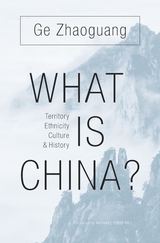 What Is China?: Territory, Ethnicity, Culture, and History
Ge Zhaoguang
Harvard University Press, 2018 Ge Zhaoguang, an eminent historian of traditional China and a public intellectual, takes on fundamental questions that shape the domestic and international politics of the world’s most populous country and its second largest economy. What Is China? offers an insider’s account that addresses sensitive problems of Chinese identity and shows how modern scholarship about China—whether conducted in China, East Asia, or the West—has attempted to make sense of the country’s shifting territorial boundaries and its diversity of ethnic groups and cultures.
Ge considers, for example, the ancient concept of tianxia, or All-Under-Heaven, which assigned supremacy to the imperial court and lesser status to officials, citizens, tributary states, and tribal peoples. Does China’s government still operate with a belief in divine rule of All-Under-Heaven, or has it taken a different view of other actors, inside and outside its current borders? Responding both to Western theories of the nation-state and to Chinese intellectuals eager to promote “national learning,” Ge offers an insightful and erudite account of how China sees its place in the world. As he wrestles with complex historical and cultural forces guiding the inner workings of an often misunderstood nation, Ge also teases out many nuances of China’s encounter with the contemporary world, using China’s past to explain aspects of its present and to provide insight into various paths the nation might follow as the twenty-first century unfolds.
What Is College Reading?
Alice S. Horning
University Press of Colorado, 2017 Arguing that literacy instruction is the work of all teachers, K-12 and beyond, this collection offers replicable strategies to help educators think about how and when students learn the skills of reading, synthesizing information, and drawing inferences across multiple texts. What Is College Reading? will be of interest and practical use to any educator facing the need to offer more for students as they exit their high school career and begin the journey of post-secondary education. The contributors describe work in both disciplinary and cross-institutional settings, providing a wide range of instructional approaches and strategies.
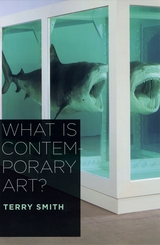 What Is Contemporary Art?
Terry Smith
University of Chicago Press, 2009 Who gets to say what counts as contemporary art? Artists, critics, curators, gallerists, auctioneers, collectors, or the public? Revealing how all of these groups have shaped today’s multifaceted definition, Terry Smith brilliantly shows that an historical approach offers the best answer to the question: What is Contemporary Art? Smith argues that the most recognizable kind is characterized by a return to mainstream modernism in the work of such artists as Richard Serra and Gerhard Richter, as well as the retro-sensationalism of figures like Damien Hirst and Takashi Murakami. At the same time, Smith reveals, postcolonial artists are engaged in a different kind of practice: one that builds on local concerns and tackles questions of identity, history, and globalization. A younger generation embodies yet a third approach to contemporaneity by investigating time, place, mediation, and ethics through small-scale, closely connective art making. Inviting readers into these diverse yet overlapping art worlds, Smith offers a behind-the-scenes introduction to the institutions, the personalities, the biennials, and of course the works that together are defining the contemporary. The resulting map of where art is now illuminates not only where it has been but also where it is going.
What is Contemporary Art?
Alexander García Düttmann
Diaphanes, 2019 Art today is often practiced in perfect conformity with the neoliberal zeitgeist, often even denying its own radical potential. What is Contemporary Art? lucidly examines the relationship between art and politics in our time. Addressing the heart of the political-aesthetic debate, Alexander Garcia Düttmann shows how the radicality of contemporary art actually serves to strengthen today’s political ideologies, ultimately frustrating rather than propelling real social change as a result.
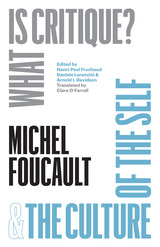 "What Is Critique?" and "The Culture of the Self"
Michel Foucault
University of Chicago Press, 2024 Newly published lectures by Foucault on critique, Enlightenment, and the care of the self.
On May 27, 1978, Michel Foucault gave a lecture to the French Society of Philosophy where he redefined his entire philosophical project in light of Immanuel Kant’s 1784 text “What Is Enlightenment?” Foucault strikingly characterizes critique as the political and moral attitude consisting in the “art of not being governed like this,” one that performs the function of destabilizing power relations and creating the space for a new formation of the self within the “politics of truth.”
This volume presents the first critical edition of this crucial lecture alongside a previously unpublished lecture about the culture of the self and three public debates with Foucault at the University of California, Berkeley, in April 1983. There, for the first time, Foucault establishes a direct connection between his reflections on the Enlightenment and his analyses of Greco-Roman antiquity. However, far from suggesting a return to the ancient culture of the self, Foucault invites his audience to build a “new ethics” that bypasses the traditional references to religion, law, and science.
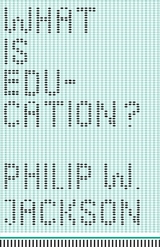 What Is Education?
Philip W. Jackson
University of Chicago Press, 2011 One day in 1938, John Dewey addressed a room of professional educators and urged them to take up the task of “finding out just what education is.” Reading this lecture in the late 1940s, Philip W. Jackson took Dewey’s charge to heart and spent the next sixty years contemplating his words. The stimulating result of a lifetime of thinking about educating, What Is Education? is a profound philosophical exploration of how we transmit knowledge in human society and how we think about accomplishing that vital task. Most contemporary approaches to education follow a strictly empirical track, aiming to discover pragmatic solutions for teachers and school administrators. Jackson argues that we need to learn not just how to improve on current practices but also how to think about what education means—in short, we need to answer Dewey by constantly rethinking education from the ground up. Guiding us through the many facets of Dewey’s comments, Jackson also calls on Hegel, Kant, and Paul Tillich to shed light on how a society does, can, and should transmit truth and knowledge to successive generations. Teasing out the implications in these thinkers’ works ultimately leads Jackson to the conclusion that education is at root a moral enterprise. At a time when schools increasingly serve as a battleground for ideological contests, What Is Education? is a stirring call to refocus our minds on what is for Jackson the fundamental goal of education: making students as well as teachers—and therefore everyone—better people.
 What is European?: On Overcoming Colonial and Romantic Modes of Thought
Dag Nikolaus Hasse
Amsterdam University Press, 2025 It is common to define Europe by its democratic, scientific, religious, and cultural traditions. But in What is European?, Dag Nikolaus Hasse argues that the search for Europe's essence has taken a troubling turn. He shows that many traditional ideas about Europe are culturally one-sided and historically and geographically distorted, and calls for a decolonisation and deromanticisation of the discourse on Europe.
The book promotes an inclusive vision of Europe that reflects its long history of multiethnic cities, offers a cultural home to a wider range of people across the continent, and extends attention and respect to other continents, thus laying a more respectful foundation for shaping the future together.
At the same time, Hasse demonstrates that overcoming colonial ways of thinking does not and should not result in anti-Europeanism. Criticising European arrogance may well go hand in hand with feeling culturally at home in other traditions of Europe. For this, it does not matter whether one is a resident of the European continent or not. There is no privileged access to European culture or to the culture of any other continent.
 What Is Free Speech?: The History of a Dangerous Idea
Fara Dabhoiwala
Harvard University Press, 2025 “A brilliant history of a weaponized mantra.” —The Guardian
A leading intellectual historian shows how free speech, once viewed as both hazardous and unnatural, was reinvented as an unalloyed good, with enormous consequences for our society today.
Every premodern society, from Sumeria to China to seventeenth–century Europe, knew that bad words could destroy lives, undermine social order, and create political unrest. Given the obvious dangers of outspokenness, regulating speech and print was universally accepted as a necessary and proper activity of government. Only in the early 1700s did this old way begin to break down. In a brief span of time, the freedom to use words as one pleased was reimagined as an ideal to be held and defended in common.
Fara Dabhoiwala explores the surprising paths free speech has taken across the globe since its invention three hundred years ago. Though free speech has become a central democratic principle, its origins and evolution have less to do with the high-minded pursuit of liberty and truth than with the self-interest of the wealthy, the greedy, and the powerful. Free speech, as we know it, is a product of the pursuit of profit, of technological disruption, of racial and imperial hypocrisy, and of the contradictions involved in maintaining openness while suppressing falsehood. For centuries, its shape has everywhere been influenced by international, not just national, events; nowhere has it ever been equally available to women, the colonized, or those stigmatized as racially inferior.
Rejecting platitudes about the First Amendment and its international equivalents, and leaving no ideological position undisturbed, What Is Free Speech? is the unsettling history of an ideal as cherished as it is misunderstood.
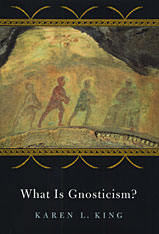 What Is Gnosticism?
Karen L. King
Harvard University Press, 2003 A distinctive Christian heresy? A competitor of burgeoning Christianity? A pre-Christian folk religion traceable to "Oriental syncretism"? How do we account for the disparate ideas, writings, and practices that have been placed under the Gnostic rubric? To do so, Karen King says, we must first disentangle modern historiography from the Christian discourse of orthodoxy and heresy that has pervaded--and distorted--the story.
Exciting discoveries of previously unknown ancient writings--especially the forty-six texts found at Nag Hammadi in 1945--are challenging historians of religion to rethink not only what we mean by Gnosticism but also the standard account of Christian origins. The Gospel of Mary and The Secret Book of John, for example, illustrate the variety of early Christianities and are witness to the struggle of Christians to craft an identity in the midst of the culturally pluralistic Roman Empire. King shows how historians have been misled by ancient Christian polemicists who attacked Gnostic beliefs as a "dark double" against which the new faith could define itself. Having identified past distortions, she is able to offer a new and clarifying definition of Gnosticism. Her book is thus both a thorough and innovative introduction to the twentieth-century study of Gnosticism and a revealing exploration of the concept of heresy as a tool in forming religious identity.
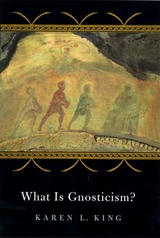 What Is Gnosticism?
Karen L. King
Harvard University Press A distinctive Christian heresy? A competitor of burgeoning Christianity? A pre-Christian folk religion traceable to "Oriental syncretism"? How do we account for the disparate ideas, writings, and practices that have been placed under the Gnostic rubric? To do so, Karen King says, we must first disentangle modern historiography from the Christian discourse of orthodoxy and heresy that has pervaded--and distorted--the story.
Exciting discoveries of previously unknown ancient writings--especially the forty-six texts found at Nag Hammadi in 1945--are challenging historians of religion to rethink not only what we mean by Gnosticism but also the standard account of Christian origins. The Gospel of Mary and The Secret Book of John, for example, illustrate the variety of early Christianities and are witness to the struggle of Christians to craft an identity in the midst of the culturally pluralistic Roman Empire. King shows how historians have been misled by ancient Christian polemicists who attacked Gnostic beliefs as a "dark double" against which the new faith could define itself. Having identified past distortions, she is able to offer a new and clarifying definition of Gnosticism. Her book is thus both a thorough and innovative introduction to the twentieth-century study of Gnosticism and a revealing exploration of the concept of heresy as a tool in forming religious identity.
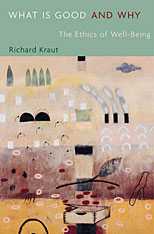 What Is Good and Why: The Ethics of Well-Being
Richard Kraut
Harvard University Press, 2007 What is good? How can we know, and how important is it? In this book Richard Kraut, one of our most respected analytical philosophers, reorients these questions around the notion of what causes human beings to flourish--that is, what is good for us. Observing that we can sensibly talk about what is good for plants and animals no less than what is good for people, Kraut advocates a general principle that applies to the entire world of living things: what is good for complex organisms consists in the maturation and exercise of their natural powers.
Drawing on the insights of ancient Greek philosophy, Kraut develops this thought into a good-centered moral philosophy, an "ethics of well-being" that requires all of our efforts to do some good. Even what is good of a kind--good poems no less than good people--must be good for someone. Pleasure plays a key role in this idea of flourishing life, but Kraut opposes the current philosophical orthodoxy of well-being, which views a person's welfare as a construct of rational desires or plans, actual or ideal.
The practical upshot of Kraut's theory is that many common human pursuits--for riches, fame, domination--are in themselves worthless, while some of the familiar virtues--justice, honesty, and autonomy--are good for every human being.
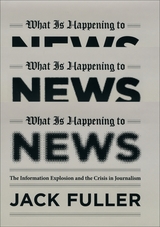 What Is Happening to News: The Information Explosion and the Crisis in Journalism
Jack Fuller
University of Chicago Press, 2010 Across America, newspapers that have defined their cities for over a century are rapidly failing, their circulations plummeting even as opinion-soaked web outlets like the Huffington Post thrive. Meanwhile, nightly news programs shock viewers with stories of horrific crime and celebrity scandal, while the smug sarcasm and shouting of pundits like Glenn Beck and Keith Olbermann dominate cable television. Is it any wonder that young people are turning away from the news entirely, trusting comedians like Jon Stewart as their primary source of information on current events?
In the face of all the problems plaguing serious news, What Is Happening to News explores the crucial question of how journalism lost its way—and who is responsible for the ragged retreat from its great traditions. Veteran editor and newspaperman Jack Fuller locates the surprising sources of change where no one has thought to look before: in the collision between a revolutionary new information age and a human brain that is still wired for the threats faced by our prehistoric ancestors. Drawing on the dramatic recent discoveries of neuroscience, Fuller explains why the information overload of contemporary life makes us dramatically more receptive to sensational news, while rendering the staid, objective voice of standard journalism ineffective. Throw in a growing distrust of experts and authority, ably capitalized on by blogs and other interactive media, and the result is a toxic mix that threatens to prove fatal to journalism as we know it.
For every reader troubled by what has become of news—and worried about what the future may hold—What Is Happening to News not only offers unprecedented insight into the causes of change but also clear guidance, strongly rooted in the precepts of ethical journalism, on how journalists can adapt to this new environment while still providing the information necessary to a functioning democracy.
What Is Islamophobia?: Racism, Social Movements and the State
Edited by Narzanin Massoumi, Tom Mills and David Miller
Pluto Press, 2017 Since Israel began its construction in 2002, the Wall has sparked intense debate, being condemned as illegal by the International Court of Justice.
Israel claims it is a security measure to protect Israeli citizens from terrorist attacks. Opponents point to the serious impact on the rights of Palestinians, depriving them of their land, mobility and access to health and educational services.
This book explores the Palestinian experience of the Wall in their international context. What are the real intentions behind the Israeli security argument? Is it a means of securing territory permanently through an illegal annexation of East Jerusalem? The West Bank Wall is a cutting account of the impact of the wall and how it affects prospects of a future peace in the Middle East.
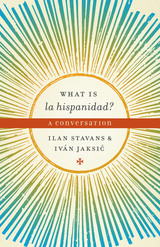 What is la hispanidad?: A conversation
By Ilan Stavans and Iván Jaksić
University of Texas Press, 2011 Natives of the Iberian Peninsula and the twenty countries of Latin America, as well as their kinsfolk who've immigrated to the United States and around the world, share a common quality or identity characterized as la hispanidad. Or do they? In this lively, provocative book, two distinguished intellectuals, a cultural critic and a historian, engage in a series of probing conversations in which they try to discern the nature of la hispanidad and debate whether any such shared identity binds the world's nearly half billion people who are "Hispanic." Their conversations range from La Reconquista and Spanish monarchs Ferdinand and Isabella, who united the Spanish nation while expelling its remaining Moors and Jews, to the fervor for el fútbol (soccer) that has swept much of Latin America today. Along the way, they discuss a series of intriguing topics, including the complicated relationship between Latin America and the United States, Spanish language and the uses of Spanglish, complexities of race and ethnicity, nineteenth-century struggles for nationhood and twentieth-century identity politics, and popular culture from literary novels to telenovelas. Woven throughout are the authors' own enlightening experiences of crossing borders and cultures in Mexico and Chile and the United States. Sure to provoke animated conversations among its readers, What is la hispanidad? makes a convincing case that "our hispanidad is rooted in a changing tradition, flexible enough to persist beyond boundaries and circumstances. Let us not fix it with a definition, but allow it instead to travel, always."
 "What is Literature?" and Other Essays
Jean-Paul Sartre
Harvard University Press, 1988 "What is Literature?" remains the most significant critical landmark of French literature since World War II. Neither abstract nor abstruse, it is a brilliant, provocative performance by a writer more inspired than cautious."What is Literature?" challenges anyone who writes as if literature could be extricated from history or society. But Sartre does more than indict. He offers a definitive statement about the phenomenology of reading, and he goes on to provide a dashing example of how to write a history of literature that takes ideology and institutions into account. This new edition of "What is Literature?" also collects three other crucial essays of Sartre's for the first time in a volume of his. The essays presenting Sartre's monthly, Les Temps modernes, and on the peculiarly French manner of nationalizing literature do much to create a context for Sartre's treatise. "Black Orpheus" has been for many years a key text for the study of black and third-world literatures.
 What Is Mental Illness?
Richard J. McNally
Harvard University Press, 2012 According to a major health survey, nearly half of all Americans have been mentally ill at some point in their lives—more than a quarter in the last year. Can this be true? What exactly does it mean, anyway? What’s a disorder, and what’s just a struggle with real life?
This lucid and incisive book cuts through both professional jargon and polemical hot air, to describe the intense political and intellectual struggles over what counts as a “real” disorder, and what goes into the “DSM,” the psychiatric bible. Is schizophrenia a disorder? Absolutely. Is homosexuality? It was—till gay rights activists drove it out of the DSM a generation ago. What about new and controversial diagnoses? Is “social anxiety disorder” a way of saying that it’s sick to be shy, or “female sexual arousal disorder” that it’s sick to be tired?
An advisor to the DSM, but also a fierce critic of exaggerated overuse, McNally defends the careful approach of describing disorders by patterns of symptoms that can be seen, and illustrates how often the system medicalizes everyday emotional life.
Neuroscience, genetics, and evolutionary psychology may illuminate the biological bases of mental illness, but at this point, McNally argues, no science can draw a bright line between disorder and distress. In a pragmatic and humane conclusion, he offers questions for patients and professionals alike to help understand, and cope with, the sorrows and psychopathologies of everyday life.
What is Modern Israel?
Yakov M. Rabkin
Pluto Press, 2016 Few countries provoke as much passion and controversy as Israel. What is Modern Israel? convincingly demonstrates that its founding ideology - Zionism - is anything but a simple reaction to antisemitism. Dispelling the notion that every Jew is a Zionist and therefore a natural advocate for the state of Israel, Yakov Rabkin points to the Protestant roots of Zionism, in order to explain the particular support Israel musters in the United States.
Drawing on many overlooked pages of history, including English, French, Hebrew, Yiddish and Russian sources, Yakov Rabkin shows that Zionism was conceived as a sharp break with Judaism and Jewish continuity. Israel’s past and present must be seen in the context of European ethnic nationalism, colonial expansion and geopolitical interests, rather than as an incarnation of Biblical prophecies or a culmination of Jewish history.
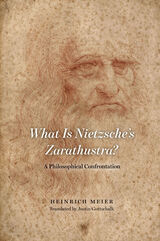 What is Nietzsche's Zarathustra?: A Philosophical Confrontation
Heinrich Meier
University of Chicago Press, 2021 A masterful, nuanced, and novel examination of Nietzsche’s Zarathustra. Thus Spoke Zarathustra is Nietzsche’s most famous and most puzzling work, one in which he makes the greatest use of poetry to explore the questions posed by philosophy. But in order to understand the movement of this drama, we must first understand the character of its protagonist: we must ask, What Is Nietzsche’s Zarathustra?
Heinrich Meier attempts to penetrate the core of the drama, following as a guiding thread the question of whether Zarathustra is a philosopher or a prophet, or, if he is meant to be both, whether Zarathustra is able to unite philosopher and prophet in himself. Via a close reading that uncovers the book’s hidden structure, Meier develops a highly stimulating and original interpretation of this much-discussed but still ill-understood masterwork of German poetic prose. In the process, he carefully overturns long-established canons in the academic discourse of Nietzsche interpretation. The result is a fresh and surprising grasp of Nietzsche’s well-known teachings of the overman, the will to power, and the eternal return.
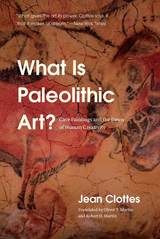 What Is Paleolithic Art?: Cave Paintings and the Dawn of Human Creativity
Jean Clottes
University of Chicago Press, 2016 Was it a trick of the light that drew our Stone Age ancestors into caves to paint in charcoal and red hematite, to watch the heads of lions, likenesses of bison, horses, and aurochs in the reliefs of the walls, as they flickered by firelight? Or was it something deeper—a creative impulse, a spiritual dawn, a shamanistic conception of the world efflorescing in the dark, dank spaces beneath the surface of the earth where the spirits were literally at hand?
In this book, Jean Clottes, one of the most renowned figures in the study of cave paintings, pursues an answer to this “why” of Paleolithic art. While other books focus on particular sites and surveys, Clottes’s work is a contemplative journey across the world, a personal reflection on how we have viewed these paintings in the past, what we learn from looking at them across geographies, and what these paintings may have meant—what function they may have served—for their artists. Steeped in Clottes’s shamanistic theories of cave painting, What Is Paleolithic Art? travels from well-known Ice Age sites like Chauvet, Altamira, and Lascaux to visits with contemporary aboriginal artists, evoking a continuum between the cave paintings of our prehistoric past and the living rock art of today. Clottes’s work lifts us from the darkness of our Paleolithic origins to reveal, by firelight, how we think, why we create, why we believe, and who we are.
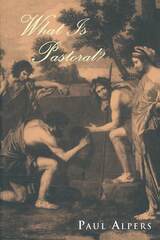 What Is Pastoral?
Paul Alpers
University of Chicago Press, 1997 One of the enduring traditions of Western literary history, pastoral is often mischaracterized as a catchall for literature about rural themes and nature in general. In What Is Pastoral?, distinguished literary historian Paul Alpers argues that pastoral is based upon a fundamental fiction—that the lives of shepherds or other socially humble figures represent the lives of human beings in general.
Ranging from Virgil's Eclogues to Sarah Orne Jewett's The Country of the Pointed Firs, from Shakespeare and Cervantes to Hardy and Frost, this work brings the story of the pastoral tradition, previously limited to classical and Renaissance literature, into the twentieth century. Pastoral reemerges in this account not as a vehicle of nostalgia for some Golden Age, nor of escape to idyllic landscapes, but as a mode bearing witness to the possibilities and problems of human community and shared experience in the real world.
A rich and engrossing book, What Is Pastoral? will soon take its place as the definitive study of pastoral literature.
"Alpers succeeds brilliantly. . . . [He] offers . . . a wealth of new insight into the origins, development, and flowering of the pastoral."—Ann-Maria Contarino, Renaissance Quarterly
 What Is Performance Studies?
Diana Taylor and Marcos Steuernagel, editors
Duke University Press This multimedia digital book asks thirty leading scholars from seven different countries throughout the Americas the same question: What is performance studies? Available online, this project features video interviews accompanied by short essays. The interviews are transcribed, translated, and subtitled into English, Spanish, and Portuguese, offering a truly trilingual perspective on performance studies that engages with it from a variety of national, linguistic, and disciplinary locations. Diana Taylor and Marcos Steuernagel's written introduction provides a history and overview of the project, while four brief essays by Steuernagel, Taylor, Marcela A. Fuentes, and Tavia Nyong'o offer critical entry points to the interviews from different yet complementary perspectives. What Is Performance Studies? expands the genealogy of the field while opening new paths for thinking through, in, and with performance studies in the Americas. Contributors: Patrick Anderson, Daphne A. Brooks, Barbara Browning, Sue-Ellen Case, Catherine M. Cole, Anabelle Contreras Castro, Tracy C. Davis, Diamela Eltit, Soledad Falabella Luco, Holly Hughes, Barbara Kirshenblatt-Gimblett, Jill Lane, André Lepecki, Laura Levin, Zeca Ligiéro, Beth Lopes, Jesús Martín Barbero, Leda Martins, José Esteban Muñoz, Tavia Nyong’o, Ann Pellegrini, Antonio Prieto Stambaugh, Rossana Reguillo Cruz, Joseph Roach, Richard Schechner, Rebecca Schneider, Javier Serna, Marcos Steuernagel, Diana Taylor, Kay Turner, W. B. Worthen. Published in collaboration with the Hemispheric Institute of Performance and Politics at New York University
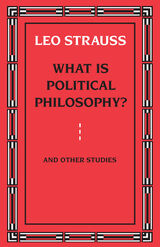 What is Political Philosophy? And Other Studies
Leo Strauss
University of Chicago Press, 1988 "All political action has . . . in itself a directedness towards knowledge of the good: of the good life, or of the good society. For the good society is the complete political good. If this directedness becomes explicit, if men make it their explicit goal to acquire knowledge of the good life and of the good society, political philosophy emerges. . . . The theme of political philosophy is mankind's great objectives, freedom and government or empire—objectives which are capable of lifting all men beyond their poor selves. Political philosophy is that branch of philosophy which is closest to political life, to non-philosophic life, to human life."—From "What Is Political Philosophy?"
What Is Political Philosophy?—a collection of ten essays and lectures and sixteen book reviews written between 1943 and 1957—contains some of Leo Strauss's most famous writings and some of his most explicit statements of the themes that made him famous. The title essay records Strauss's sole extended articulation of the meaning of political philosophy itself. Other essays discuss the relation of political philosophy to history, give an account of the political philosophy of the non-Christian Middle Ages and of classic European modernity, and present his theory of esoteric writing.
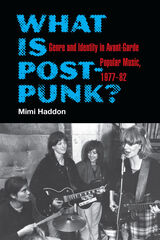 What Is Post-Punk?: Genre and Identity in Avant-Garde Popular Music, 1977-82
Mimi Haddon
University of Michigan Press, 2020 Popular music in the US and UK during the late 1970s and early 1980s was wildly eclectic and experimental. “Post-punk,” as it was retroactively labeled, could include electro-pop melodies, distorted guitars, avant-garde industrial sounds, and reggae beats, and thus is not an easily definable musical category. What Is Post-Punk? combines a close reading of the late-1970s music press discourse with musical analyses and theories of identity to unpack post-punk’s status as a genre. Mimi Haddon traces the discursive foundations of post-punk across publications such as Sounds, ZigZag, Melody Maker, the Village Voice, and NME, and presents case studies of bands including Wire, PiL, Joy Division, the Raincoats, and Pere Ubu. By positioning post-punk in relation to genres such as punk, new wave, dub, and disco, Haddon explores the boundaries of post-punk, and reveals it as a community of tastes and predilections rather than a stylistically unified whole. Haddon diversifies the discourse around post-punk, exploring both its gender and racial dynamics and its proto-industrial aesthetics to restore the historical complexity surrounding the genre’s terms and origins.
What Is Red?
Suzanne Gottlieb
Bodleian Library Publishing, 2016 Children will discover a world of colors as they set out on an adventure with a cheerful boy named Jonny. From the moment he wakes bright-eyed to the yellow sunlight streaming through his bedroom window, the colors of the day dance merrily around him. He sees green grass and purple flowers and pauses to dip his toes in a bubbling blue brook. Best of all, when the time comes to harvest, he digs in the brown earth and discovers an enormous orange pumpkin! But, before he knows it, the blue sky has turned black, and it’s time for Jonny to sleep before waking to the wonders of a new day.
A joyous celebration of colors that will encourage young readers’ curiosity about the world around them, What Is Red? is packed with illustrations in bright, primary colors. Originally published in 1961, the book is one of the most recent additions to the Bodleian Library’s children’s book imprint.
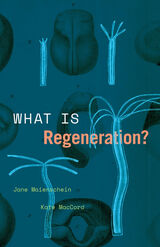 What Is Regeneration?
Jane Maienschein and Kate MacCord
University of Chicago Press, 2022 Two historians and philosophers of science offer an essential primer on the meaning and limits of regeneration.
In punishment for his stealing fire, the Greek gods chained Prometheus to a rock, where every day an eagle plucked out his liver, and every night the liver regenerated. While Prometheus may be a figure of myth, scholars today ask whether ancient Greeks knew that the human liver does, in fact, have a special capacity to regenerate. Some organs and tissues can regenerate, while others cannot, and some organisms can regenerate more fully and more easily than others. Cut an earthworm in half, and two wiggly worms may confront you. Cut off the head of a hydra, and it may grow a new head. Cut off a human arm, and the human will be missing an arm. Why the differences? What are the limits of regeneration, and how, when, and why does it occur?
In this book, historians and philosophers of science Jane Maienschein and Kate MacCord explore biological regeneration, delving into a topic of increasing interest in light of regenerative medicine, new tools in developmental and neurobiology, and the urgent need to understand and repair damage to ecosystems brought on by climate change. Looking across scales, from germ, nerve, and stem cells to individual organisms and complex systems, this short and accessible introduction poses a range of deep and provocative questions: What conditions allow some damaged microbiomes to regenerate where others do not? Why are forests following a fire said to regenerate sometimes but not always? And in the face of climate change in the era called the Anthropocene, can the planet regenerate to become healthy again, or will the global ecosystem collapse?
What is Research?
Gabriel Harp
A2RU Intervals, 2018 Eight epistemologies to characterize research that spans traditional activities and new practices — shaping how people will come to understand the world in the century ahead.
Because faculty and students have so many wide-ranging experiences, academic trajectories, and disciplinary backgrounds, they don’t necessarily have the same set of concepts in mind when it comes to talking about research, what it means, or how it’s done. For many, “research” is an abstract, culturally constructed concept. With many different definitions and experiences, it can be critical to build a shared foundation for understanding — especially when issues of “what counts” as knowledge, tenure and promotion, and research process are at stake.
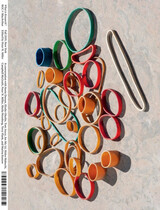 What Is Research?
Edited by Peter Miller
Bard Graduate Center, 2021 Research underlies nearly every aspect of our culture, with expansive investment poured into it and its significance acknowledged by governments, industries, and academic institutions around the world. Yet the idea, practice, and social life of research have not been a subject of study. Of the 164 million items in the catalog of the Library of Congress, only forty-three fall into the category of “Research—History.” To begin the task of understanding research as a concept and practice, Bard Graduate Center gathered a group of artists, scientists, and humanists—all recipients of MacArthur “genius” grants—for three evenings of discussion moderated by Peter N. Miller, who is also a MacArthur Fellow.
What is Research? includes conversations with theater director Annie Dorsen, biomedical researcher Elodie Ghedin, sculptor Tom Joyce, physicist Hideo Mabuchi, poet Campbell McGrath, photographer and filmmaker An-My Lê, neuroscientist Sheila Nirenberg, geochemist Terry Plank, and historian Marina Rustow, all of whom grapple with questions about the nature of research from their varied perspectives.
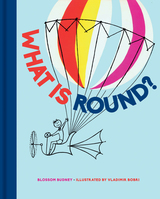 What Is Round?
Blossom Budney
Bodleian Library Publishing, 2017 The sun is round and hot and glowing. An orange is round on the tree where it’s growing.
Many things in the natural world are round—the sun, the moon, a bird’s nest with three bright baby birds. So are the turning wheels of a train and a hot air balloon high in the sky. So are cakes, pies, cookies, and many other delicious things to eat!
Page by brightly colored page, What is Round? invites young readers to pick out the shape in the world around them, from the smallest raindrop to a big spectacular carousel. Many of the objects can be found in our own homes, like the clock that tells the time or the colorful decorations on a Christmas tree. Others, like the portholes of a passing ship, require a watchful eye. Striking and vibrant illustrations by Vladimir Bobri accompany the playful rhymes of Blossom Budney in this lively look at this shape that can be found in the most unexpected places.
Originally published in 1954, What is Round? will make a wonderful addition to any child’s library, and it’s the perfect story to read aloud.
What Is Said and What Is Not: The Semantics/Pragmatics Interface
Edited by Carlo Penco and Filippo Domaneschi
CSLI, 2013 This volume contains essays that explore explicit and implicit communication through linguistic research. Taking as a framework Paul Grice’s theories on “what is said,” the contributors explore a number of areas, including: the boundary between semantics and pragmatics; the concept of implicit communication; the idea of the logical form of our assertions; the notion of conventional meaning; the phenomenon of deixis, which refers to when an utterance require context in order to be understood fully; the treatment of definite descriptions; and the different kinds of pragmatic processes.
What is Symbolism?
By Henri Peyre, translated by Emmett Parker
University of Alabama Press, 1980 "This splendid work is highly recommended." —Choice Peyre's beautiful introduction to the Symbolist movement, which emerged in the late 19th century. A literary and artistic movement that sought to express the ineffable and the mysterious aspects of human experience, Symbolism originated in France and spread across Europe, influencing various forms of art, including poetry, painting, and music. Prominent figures in the Symbolist movement include poets like Charles Baudelaire, Stéphane Mallarmé, and Paul Verlaine, as well as artists like Gustave Moreau and Odilon Redon. The Symbolist movement had a profound impact on later artistic and literary movements, such as Modernism and Surrealism, shaping the way artists and writers approached the exploration of the human psyche and the mysteries of existence.
What Is Taoism?: and Other Studies in Chinese Cultural History
Herrlee Glessner Creel
University of Chicago Press, 1982 What Is Taoism? traces, in nontechnical language, the history of the development of this often baffling doctrine. Creel shows that there has not been one "Taoism," but at least three, in some respects incompatible and often antagonistic. In eight closely related papers, Creel explicates the widely used concepts he originally introduced of "contemplative Taoism," "purposive Taoism," and "Hsien Taoism." He also discusses Shen Pu-hai, a political philosopher of the fourth century B.C.; the curious interplay between Confucianism, Taoism, and "Legalism" in the second century B.C.; and the role of the horse in Chinese history.
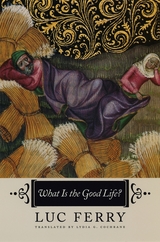 What Is the Good Life?
Luc Ferry
University of Chicago Press, 2005 Has inquiry into the meaning of life become outmoded in a universe where the other-worldiness of religion no longer speaks to us as it once did, or, as Nietzsche proposed, where we are now the creators of our own value? Has the ancient question of the "good life" disappeared, another victim of the technological world? For Luc Ferry, the answer to both questions is a resounding no.
In What Is the Good Life? Ferry argues that the question of the meaning of life, on which much philosophical debate throughout the centuries has rested, has not vanished, but at the very least the question is posed differently today. Ferry points out the pressures in our secularized world that tend to reduce the idea of a successful life or "good life" to one of wealth, career satisfaction, and prestige. Without deserting the secular presuppositions of our world, he shows that we can give ourselves a richer sense of life's possibilities. The "good life" consists of harmonizing life's different forces in a way that enables one to achieve a sense of personal satisfaction in the realization of one's creative abilities.
What Is the Mishnah?: The State of the Question
Shaye J. D. Cohen
Harvard University Press, 2023 The Mishnah is the foundational document of rabbinic Judaism—all of rabbinic law, from ancient to modern times, is based on the Talmud, and the Talmud, in turn, is based on the Mishnah. But the Mishnah is also an elusive document; its sources and setting are obscure, as are its genre and purpose.
In January 2021 the Harvard Center for Jewish Studies and the Julis-Rabinowitz Program on Jewish and Israeli Law of the Harvard Law School co-sponsored a conference devoted to the simple yet complicated question: “What is the Mishnah?” Leading scholars from the United States, Europe, and Israel assessed the state of the art in Mishnah studies; and the papers delivered at that conference form the basis of this collection. Learned yet accessible, What Is the Mishnah? gives readers a clear sense of current and future direction of Mishnah studies.
What Is the Talmud?: The State of the Question
Christine Hayes and Jay M. Harris
Harvard University Press The Babylonian Talmud, or Bavli, stands as one of the central pillars of Jewish intellectual, cultural, and religious life. But what, precisely, is this monumental and heterogenous compilation? How was it formed, redacted, and transmitted? Who composed it and for what purpose? How was it shaped by its broader cultures and historical period? How was it received and re-conceived by subsequent generations, and what has the Talmud become in our day?
What Is the Talmud? collects essays that provide a comprehensive exploration of the Talmud’s origins, compilation, and redaction; its diverse genres and discursive practices; its historical and cultural setting; its preservation and study across generations; and its enduring influence on Jewish life and culture today.
What Is the Talmud?: The State of the Question
Christine Hayes and Jay M. Harris
Harvard University Press The Babylonian Talmud, or Bavli, stands as one of the central pillars of Jewish intellectual, cultural, and religious life. But what, precisely, is this monumental and heterogenous compilation? How was it formed, redacted, and transmitted? Who composed it and for what purpose? How was it shaped by its broader cultures and historical period? How was it received and re-conceived by subsequent generations, and what has the Talmud become in our day?
What Is the Talmud? collects essays that provide a comprehensive exploration of the Talmud’s origins, compilation, and redaction; its diverse genres and discursive practices; its historical and cultural setting; its preservation and study across generations; and its enduring influence on Jewish life and culture today.
What Is the Talmud?: The State of the Question
Christine Hayes and Jay M. Harris
Harvard University Press The Babylonian Talmud, or Bavli, stands as one of the central pillars of Jewish intellectual, cultural, and religious life. But what, precisely, is this monumental and heterogenous compilation? How was it formed, redacted, and transmitted? Who composed it and for what purpose? How was it shaped by its broader cultures and historical period? How was it received and re-conceived by subsequent generations, and what has the Talmud become in our day?
What Is the Talmud? collects essays that provide a comprehensive exploration of the Talmud’s origins, compilation, and redaction; its diverse genres and discursive practices; its historical and cultural setting; its preservation and study across generations; and its enduring influence on Jewish life and culture today.
 What is to Be Done About Law and Order?: Crisis in the Nineties
John Lea and Jock Young
Pluto Press, 1993 The authors look at the connection between democracy and efficiency as they investigate the meaning of law and order. The authors argue that only through a democratically accountable police service can we hope to build up relationships within the inner city.
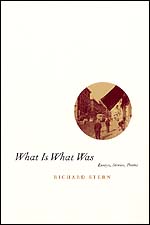 What Is What Was
Richard Stern
University of Chicago Press, 2002 What Is What Was, Richard Stern's fifth "orderly miscellany," is the first to meaningfully combine his fiction and nonfiction. Stories, such as the already well-known "My Ex, the Moral Philosopher," appear among portraits (of the sort Hugh Kenner praised as "almost the invention of a new genre"): Auden, Pound, Ellison, Terkel, W. C. Fields, Bertrand Russell, Walter Benjamin (in both essay and story), Jung and Freud, Hannah Arendt and Martin Heidegger.
In the book's seven sections are analyses of the Wimbledon tennis tournament as an Anglification machine, of Silicon Valley at its shaky peak, of James and Dante as travel writers, a Lucretian look at today's cosmology, American fiction in detail and depth, a "thought experiment" for Clarence Thomas, a salvation scheme for Ross Perot, a semi-confession of the writer.
The book contains but isn't philosophy, criticism, opinion, reportage, or autobiography (although the author says it is as much of this as he plans to write). There is a recurrent theme, the ways in which actuality is made and remade in description, argument and narration, fictional and nonfictional, but above all, What Is What Was is a provocative entertainment by a writer who, as Philip Roth once said, "knows as much as anyone writing American prose about family mischief, intellectual shenanigans, love blunders—and about writing American prose."
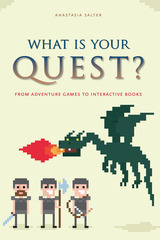 What Is Your Quest?: From Adventure Games to Interactive Books
Anastasia Salter
University of Iowa Press, 2014 What Is Your Quest? examines the future of electronic literature in a world where tablets and e-readers are becoming as common as printed books and where fans are blurring the distinction between reader and author. The construction of new ways of storytelling is already underway: it is happening on the edges of the mainstream gaming industry and in the spaces between media, on the foundations set by classic games. Along these margins, convergent storytelling allows for playful reading and reading becomes a strategy of play.
One of the earliest models for this new way of telling stories was the adventure game, the kind of game centered on quests in which the characters must overcome obstacles and puzzles. After they fell out of fashion in the 1990s, fans made strenuous efforts to keep them alive and to create new games in the genre. Such activities highlight both the convergence of game and story and the collapsing distinction between reader and author. Continually defying the forces of obsolescence, fans return abandoned games to a playable state and treat stories as ever-evolving narratives. Similarly, players of massive multiplayer games become co-creators of the game experience, building characters and creating social networks that recombine a reading and gaming community.
The interactions between storytellers and readers, between programmers and creators, and among fans turned world-builders are essential to the development of innovative ways of telling stories. And at the same time that fan activities foster the convergence of digital gaming and storytelling, new and increasingly accessible tools and models for interactive narrative empower a broadening range of storytellers. It is precisely this interactivity among a range of users surrounding these new platforms that is radically reshaping both e-books and games and those who read and play with them.
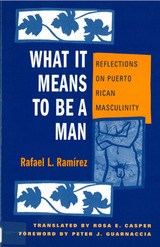 What It Means To Be A Man: Reflections on Puerto Rican Masculinity
Rafael L. Ramirez
Rutgers University Press, 1999 Rafael L. Ramírez presents an insightful examination of Puerto Rican culture and the ways in which Puerto Rican masculinity is constructed.
What It Means to Be a Man begins with a discussion of machismo set in the context of the social construction of masculinity. Ramírez presents his interpretation of what it means to be a Puerto Rican man, discussing the attributes and demands of masculinity, and pointing out the ways in which strength, competition, and sexuality are joined with power and pleasure. He examines the erotic relationships between men as part of the expressions of masculinity, and analyzes how the homosexual experience reproduces the dominant masculine ideology. Finally, Ramírez draws on the literature of the recent men's movements, offering Puerto Rican men the possibility of constructing a new masculinity, liberated from power games, to provide them with a chance to not only be better understood by others, but also to better understand themselves and their place in society.
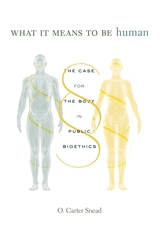 What It Means to Be Human: The Case for the Body in Public Bioethics
O. Carter Snead
Harvard University Press, 2020 A Wall Street Journal Top Ten Book of the Year
A First Things Books for Christmas Selection
Winner of the Expanded Reason Award
“This important work of moral philosophy argues that we are, first and foremost, embodied beings, and that public policy must recognize the limits and gifts that this entails.”
—Wall Street Journal
The natural limits of the human body make us vulnerable and dependent on others. Yet law and policy concerning biomedical research and the practice of medicine frequently disregard these stubborn facts. What It Means to Be Human makes the case for a new paradigm, one that better reflects the gifts and challenges of being human.
O. Carter Snead proposes a framework for public bioethics rooted in a vision of human identity and flourishing that supports those who are profoundly vulnerable and dependent—children, the disabled, and the elderly. He addresses three complex public matters: abortion, assisted reproductive technology, and end-of-life decisions. Avoiding typical dichotomies of conservative-liberal and secular-religious, Snead recasts debates within his framework of embodiment and dependence. He concludes that if the law is built on premises that reflect our lived experience, it will provide support for the vulnerable.
“This remarkable and insightful account of contemporary public bioethics and its individualist assumptions is indispensable reading for anyone with bioethical concerns.”
—Alasdair MacIntyre, author of After Virtue
“A brilliantly insightful book about how American law has enshrined individual autonomy as the highest moral good…Highly thought-provoking.”
—Francis Fukuyama, author of Identity
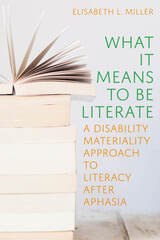 What It Means to Be Literate: A Disability Materiality Approach to Literacy after Aphasia
Elisabeth Miller
University of Pittsburgh Press, 2022 Disability and literacy are often understood as incompatible. Disability is taken to be a sign of illiteracy, and illiteracy to be a sign of disability. These oppositions generate damaging consequences for disabled students (and those labeled as such) who are denied full literacy education and for nonliterate adults who are perceived as lacking intelligence, knowledge, and ability. What It Means to Be Literate turns attention to disabled writers themselves, exposing how the cultural oppositions between disability and literacy affect how people understand themselves as literate and even as fully human. Drawing on interviews with individuals who have experienced strokes and brain injuries causing the language disability aphasia, Elisabeth L. Miller argues for the importance of taking a disability materiality approach to literacy that accounts for the embodied, material experiences of disabled people writing and reading. This approach reveals how aphasic writers’ literate practices may reinscribe, challenge, or even exceed scripts around the body in literacy (how brains, hands, eyes, mouths, voice boxes, and more operate to make reading and writing happen) as well as what and how spaces, activities, tools, and materials matter in literate practice. Miller pushes for a deeper understanding of how individuals’ specific bodies always matter for literate practice and identity, enabling researchers to better account for, and counter, ableist literate norms.
 What John Knows: Storytelling in the Fourth Gospel
Douglas Estes
SBL Press, 2025 The Gospel of John is a story that claims to speak about the past; however, in order to say something about the past, storytellers must know something of that past. In this follow-up to How John Works: Storytelling in the Fourth Gospel, a team of international scholars moves beyond genre, style, and character to examine the types of knowledge the Fourth Evangelist drew upon to write his gospel. Contributors Paul N. Anderson, Richard Bauckham, Jo-Ann A. Brant, Andrew J. Byers, Douglas Estes, Edward H. Gerber, Stan Harstine, Wendy E. S. North, George L. Parsenios, Christopher A. Porter, Tyler Smith, and Catrin H. Williams focus on a range of topics, including memory, tradition, spirit, rhetoric, imagination, and more. Together the twelve essays build a narrative epistemology that establishes what a writer must know in order to craft a narrative about the past. This collection is sure to become an essential textbook for students of the gospels in general and John in particular.
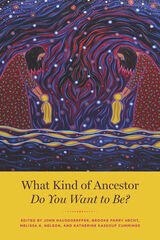 What Kind of Ancestor Do You Want to Be?
Edited by John Hausdoerffer, Brooke Parry Hecht, Melissa K. Nelson, and Katherine Kassouf Cummings
University of Chicago Press, 2021 As we face an ever-more-fragmented world, What Kind of Ancestor Do You Want to Be? demands a return to the force of lineage—to spiritual, social, and ecological connections across time. It sparks a myriad of ageless-yet-urgent questions: How will I be remembered? What traditions do I want to continue? What cycles do I want to break? What new systems do I want to initiate for those yet-to-be-born? How do we endure? Published in association with the Center for Humans and Nature and interweaving essays, interviews, and poetry, this book brings together a thoughtful community of Indigenous and other voices—including Linda Hogan, Wendell Berry, Winona LaDuke, Vandana Shiva, Robin Kimmerer, and Wes Jackson—to explore what we want to give to our descendants. It is an offering to teachers who have come before and to those who will follow, a tool for healing our relationships with ourselves, with each other, and with our most powerful ancestors—the lands and waters that give and sustain all life.
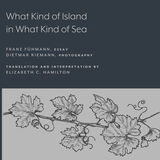 What Kind of Island in What Kind of Sea?
Franz Fühmann
Lever Press, 2021 The dignity of cognitively disabled people and the ethics of representing their lives are at the heart of an extraordinary yet little-known book first published in the former German Democratic Republic. Was für eine Insel in was für einem Meer, or What Kind of Island in What Kind of Sea (Rostock, Hinstorff, 1986) depicts residents of a church-run institution for people with cognitive disabilities in astonishing black-and-white photographs by Dietmar Riemann and in a probing, poignant essay by esteemed German writer Franz Fühmann. This important text, which moved from a medical model to a historical and cultural view of disability as an aspect of human identity and experience, is translated into English for the first time by Elizabeth Hamilton and includes reflections on the book and its impact. As fuller, global histories of disability are now being written, What Kind of Island in What Kind of Sea opens an essential window onto a formerly shuttered world, demonstrating the power of the arts to hone our capacity to perceive and appreciate human difference.
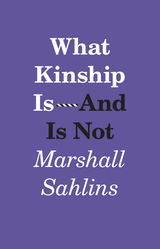 What Kinship Is-And Is Not
Marshall Sahlins
University of Chicago Press, 2013 In this pithy two-part essay, Marshall Sahlins reinvigorates the debates on what constitutes kinship, building on some of the best scholarship in the field to produce an original outlook on the deepest bond humans can have. Covering thinkers from Aristotle and Lévy- Bruhl to Émile Durkheim and David Schneider, and communities from the Maori and the English to the Korowai of New Guinea, he draws on a breadth of theory and a range of ethnographic examples to form an acute definition of kinship, what he calls the “mutuality of being.” Kinfolk are persons who are parts of one another to the extent that what happens to one is felt by the other. Meaningfully and emotionally, relatives live each other’s lives and die each other’s deaths. In the second part of his essay, Sahlins shows that mutuality of being is a symbolic notion of belonging, not a biological connection by “blood.” Quite apart from relations of birth, people may become kin in ways ranging from sharing the same name or the same food to helping each other survive the perils of the high seas. In a groundbreaking argument, he demonstrates that even where kinship is reckoned from births, it is because the wider kindred or the clan ancestors are already involved in procreation, so that the notion of birth is meaningfully dependent on kinship rather than kinship on birth. By formulating this reversal, Sahlins identifies what kinship truly is: not nature, but culture.
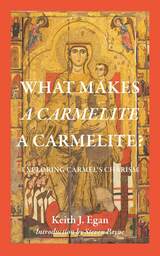 What Makes a Carmelite a Carmelite: Exploring Carmel's Charism
Keith J. Egan
Catholic University of America Press, 2022 Vatican II initiated lively conversations about the identity of religious orders and congregations when the council pointed out that these religious communities are divine gifts in and to the church. Keith Egan examines the nature of these charisms including, not only the original or founders’ charism, but how charisms evolve over the centuries. Special theological attention to these charisms show that they are not something but, in fact, are the dynamic presence of the Holy Spirit.
This volume offers a case study the original charism of the Carmelites. The first Carmelites originated when various hermits were displaced by the armies of Saladin. These dislodged hermits sought refuge on Mount Carmel in a ravine facing the Mediterranean Sea. There, these hermits, now Carmelites, sought from Saint Albert, Patriarch of Jerusalem, a description of their life of solitude. Albert’s Formula of Life describes the original Carmelite charism as a life of prayer and contemplation. This Formula eventually became a Rule that made possible a transformation of hermits into friars. Egan is at work on a sequel that examines this radical transformation.
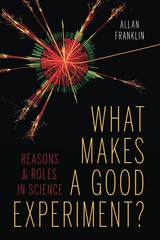 What Makes a Good Experiment?: Reasons and Roles in Science
Allan Franklin
University of Pittsburgh Press, 2015 What makes a good experiment? Although experimental evidence plays an essential role in science, as Franklin argues, there is no algorithm or simple set of criteria for ranking or evaluating good experiments, and therefore no definitive answer to the question. Experiments can, in fact, be good in any number of ways: conceptually good, methodologically good, technically good, and pedagogically important. And perfection is not a requirement: even experiments with incorrect results can be good, though they must, he argues, be methodologically good, providing good reasons for belief in their results. Franklin revisits the same important question he posed in his 1981 article in the British Journal for the Philosophy of Science, when it was generally believed that the only significant role of experiment in science was to test theories. But experiments can actually play a lot of different roles in science—they can, for example, investigate a subject for which a theory does not exist, help to articulate an existing theory, call for a new theory, or correct incorrect or misinterpreted results. This book provides details of good experiments, with examples from physics and biology, illustrating the various ways they can be good and the different roles they can play.
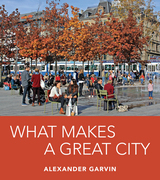 What Makes a Great City
Alexander Garvin
Island Press, 2016 One of Planetizen's Top Planning Books for 2017 • San Francisco Chronicle's 2016 Holiday Books Gift Guide Pick
What makes a great city? Not a good city or a functional city but a great city. A city that people admire, learn from, and replicate. City planner and architect Alexander Garvin set out to answer this question by observing cities, largely in North America and Europe, with special attention to Paris, London, New York, and Vienna.
For Garvin, greatness is not just about the most beautiful, convenient, or well-managed city; it isn’t even about any “city.” It is about what people who shape cities can do to make a city great. A great city is not an exquisite, completed artifact. It is a dynamic, constantly changing place that residents and their leaders can reshape to satisfy their demands. While this book does discuss the history, demographic composition, politics, economy, topography, history, layout, architecture, and planning of great cities, it is not about these aspects alone. Most importantly, it is about the interplay between people and public realm, and how they have interacted throughout history to create great cities.
To open the book, Garvin explains that a great public realm attracts and retains the people who make a city great. He describes exactly what the term public realm means, its most important characteristics, as well as providing examples of when and how these characteristics work, or don’t. An entire chapter is devoted to a discussion of how particular components of the public realm (squares in London, parks in Minneapolis, and streets in Madrid) shape people’s daily lives. He concludes with a look at how twenty-first century initiatives in Paris, Houston, Atlanta, Brooklyn, and Toronto are making an already fine public realm even better—initiatives that demonstrate what other cities can do to improve.
What Makes a Great City will help readers understand that any city can be changed for the better and inspire entrepreneurs, public officials, and city residents to do it themselves.
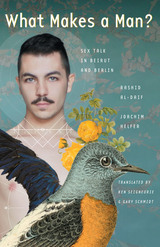 What Makes a Man?: Sex Talk in Beirut and Berlin
Rashid al-Daif and Joachim Helfer. Translated by Ken Seigneurie and Gary Schmidt
University of Texas Press, 2015 In 2003, Lebanese writer Rashid al-Daif spent several weeks in Germany as part of the “West-East Divan” program, a cultural exchange effort meant to improve mutual awareness of German and Middle Eastern cultures. He was paired with German author Joachim Helfer, who then returned the visit to al-Daif in Lebanon. Following their time together, al-Daif published in Arabic a literary reportage of his encounter with Helfer in which he focuses on the German writer’s homosexuality. His frank observations have been variously read as trenchant, naïve, or offensive. In response, Helfer provided an equally frank point-by-point riposte to al-Daif’s text. Together these writers offer a rare exploration of attitudes toward sex, love, and gender across cultural lines. By stretching the limits of both fiction and essay, they highlight the importance of literary sensitivity in understanding the Other. Rashid al-Daif’s “novelized biography” and Joachim Helfer’s commentary appear for the first time in English translation in What Makes a Man? Sex Talk in Beirut and Berlin. Also included in this volume are essays by specialists in Arabic and German literature that shed light on the discourse around sex between these two authors from different cultural contexts.
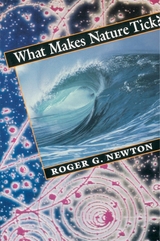 What Makes Nature Tick?
Roger G. Newton
Harvard University Press, 1993 For many of us, the physical sciences are as obscure as the phenomena they explain. We see the wonders of nature but miss the symmetry beneath, framed as it is in ever stranger symbols and concepts. Roger Newton's accessible account of how physicists understand the world allows the expert and novice alike to explore both the mysteries of the universe and the beauty of the science that gives shape to the unseeable.
In What Makes Nature Tick? we find engaging discussions of solitons and superconductors, quarks and strings, phase space, tachyons, time, chaos, and indeterminacy, as well as the investigations that have led to their elucidation. But Roger Newton does not limit this volume to late-breaking discoveries and startling facts. He presents physics as an expanding intellectual structure, a network of very human ideas that stretches back three hundred years from our present frontier of knowledge. Where does our unidirectional sense of time come from? What makes a particle elementary? How can forces be transmitted through empty space? In addition to providing these answers, and a host of others at the very heart of physics, Newton shows us how physicists formulate the questions--a process in which intuition, imagination, and aesthetics have a powerful influence.
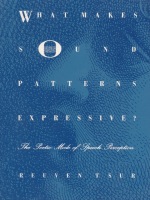 What Makes Sound Patterns Expressive?: The Poetic Mode of Speech Perception
Reuven Tsur
Duke University Press, 1992 Poets, academics, and those who simply speak a language are subject to mysterious intuitions about the perceptual qualities and emotional symbolism of the sounds of speech. Such intuitions are Reuven Tsur’s point of departure in this investigation into the expressive effect of sound patterns, addressing questions of great concern for literary theorists and critics as well as for linguists and psychologists.
Research in recent decades has established two distinct types of aural perception: a nonspeech mode, in which the acoustic signals are received in the manner of musical sounds or natural noises; and a speech mode, in which acoustic signals are excluded from awareness and only an abstract phonetic category is perceived. Here, Tsur proposes a third type of speech perception, a poetic mode in which some part of the acoustic signal becomes accessible, however faintly, to consciousness.
Using Roman Jakobson’s model of childhood acquisition of the phonological system, Tsur shows how the nonreferential babbling sounds made by infants form a basis for aesthetic valuation of language. He tests the intersubjective and intercultural validity of various spatial and tactile metaphors for certain sounds. Illustrating his insights with reference to particular literary texts, Tsur considers the relative merits of cognitive and psychoanalytic approaches to the emotional symbolism of speech sounds.
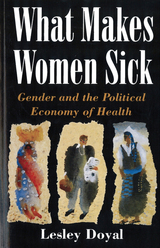 What Makes Women Sick: Gender and the Political Economy of Health
Lesley Doyal
Rutgers University Press, 1995 What makes women sick? To an Ecuadorean woman, it’s nervios from constant worry about her children’s illnesses. To a woman working in a New Mexico electronics factory, it’s the solvents that leave her with a form of dementia. To a Ugandan woman, it’s HIV from her husband's sleeping with the widow of an AIDS patient. To a Bangladeshi woman, it’s a fatal infection following an IUD insertion. What they all share is a recognition that their sickness is somehow caused by situations they face every day at home and at work.
In this clearly written and compelling book, Lesley Doyal investigates the effects of social, economic, and cultural conditions on women’s health. The “fault line” of gender that continues to divide all societies has, Doyal demonstrates, profound and pervasive consequences for the health of women throughout the world. Her broad synthesis highlights variations between men and women in patterns of health and illness, and it identifies inequalities in medical care that separate groups of women from each other. Doyal’s wide-ranging arguments, her wealth of data, her use of women’s voices from many cultures—and her examples of women mobilizing to find their own solutions—make this book required reading for everyone concerned with women’s health.
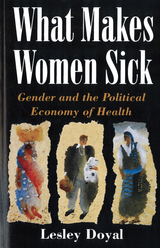 What Makes Women Sick: Gender and the Political Economy of Health
Lesley Doyal
Rutgers University Press, 1995 What makes women sick? To an Ecuadorean woman, it’s nervios from constant worry about her children’s illnesses. To a woman working in a New Mexico electronics factory, it’s the solvents that leave her with a form of dementia. To a Ugandan woman, it’s HIV from her husband's sleeping with the widow of an AIDS patient. To a Bangladeshi woman, it’s a fatal infection following an IUD insertion. What they all share is a recognition that their sickness is somehow caused by situations they face every day at home and at work.
In this clearly written and compelling book, Lesley Doyal investigates the effects of social, economic, and cultural conditions on women’s health. The “fault line” of gender that continues to divide all societies has, Doyal demonstrates, profound and pervasive consequences for the health of women throughout the world. Her broad synthesis highlights variations between men and women in patterns of health and illness, and it identifies inequalities in medical care that separate groups of women from each other. Doyal’s wide-ranging arguments, her wealth of data, her use of women’s voices from many cultures—and her examples of women mobilizing to find their own solutions—make this book required reading for everyone concerned with women’s health.
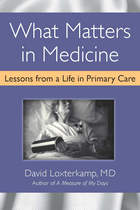 What Matters in Medicine: Lessons from a Life in Primary Care
David Loxterkamp, MD
University of Michigan Press, 2013 Primary care has come into the limelight with the passage of the Patient Protection and Affordable Care Act, the unchecked and unsustainable rise in American health care expenditures, and the crest of Baby Boomers who are now Medicare-eligible and entering the most health care–intensive period of their lives. Yet how much is really known about primary care? What Matters in Medicine: Lessons from a Life in Primary Care is a look at the past, present, and future of general practice, which is not only the predecessor to the modern primary care movement, but its foundation. Through memoir and conversation, Dr. David Loxterkamp reflects on the heroes and role models who drew him to family medicine and on his many years in family practice in a rural Maine community, and provides a prescription for change in the way that doctors and patients approach their shared contract for good health and a happy life. This book will be useful to those on both sides of primary care, doctors and patients alike.
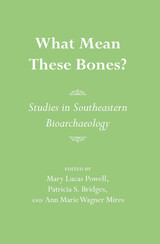 What Mean These Bones?: Studies in Southeastern Bioarchaeology
Edited by Mary Lucas Powell, Patricia S. Bridges, and Ann Marie Wagner Mires
University of Alabama Press, 1991 A Dan Josselyn Memorial Publication
Until recently, archaeological projects that included analysis of human remains had often lacked active collaboration between archaeologists and physical anthropologists from the planning stages onward. During the 1980s, a conjunctive approach developed; known as "bioarchaeology," it draws on the methodological and theoretical strengths of the two subdisciplines to bridge a perceived communications gap and promote a more comprehensive understanding of prehistoric and historic cultures.
This volume addresses questions of human adaptation in a variety of cultural contexts, with a breadth not found in studies utilizing solely biological or artifactual data. These nine case studies from eight Southeastern states cover more than 4,000 years of human habitation, from Archaic hunter-gatherers in Louisiana and Alabama to Colonial planters and slaves in South Carolina. Several studies focus upon variations in health between or within late prehistoric agricultural societies. For example, the discovery that reliance upon maize as a dietary staple did not result invariably in poor health, as claimed by earlier studies, either for entire populations or, in ranked societies, for the non-elite majority, has fostered a new appreciation for the managerial wisdom of the Mississippian peoples, as well as for their agricultural skills.
 What Men Want: Mothers, Fathers, and Manhood
John Munder Ross
Harvard University Press, 1994 Which is truly the weaker sex? Which has a harder time with its sexual and aggressive drives? The complicated business of being male is finally given its due in this book by John Munder Ross, a premier researcher and writer on the subject of masculinity. Distilling twenty years of study, he explores the male condition from infancy to manhood, exposing its complexity and fragility in the face of conflicting familial, social, and sexual impulses.
The author's psychoanalytic focus is anchored in clinical experience. But his interdisciplinary background leads him to draw on mythology, anthropology, sociology, history, and literature in formulating and illustrating his ideas about male identity and development. A boy's early identification with his mother, the evolution of his fatherly ambitions, the aggression and generational rivalry in father-son relationships, the developmental role of romantic, erotic passion: as Ross pursues these themes, he documents the ongoing changes in views of male psychology.
His book, then, is both a general intellectual history of the psychoanalytic study of male development and a lucid account of what that study has to tell us. Throughout, Ross emphasizes the feminine underside of a man's nature and the destructive potential inherent in asserting his virility, internal tensions that result in the complicated and often shaky sense of manhood so clearly described in this book. Compelling and insightful, What Men Want illuminates the concepts that figure most prominently in our understanding of the modern male condition: fatherhood, aggression, and heterosexual love. More than any other work to date, it solves the mystery of what it means to be male.
What Mennonite Girls Are Good For
Jennifer Sears
University of Iowa Press, 2025 In these eleven stories, a Mennonite minister’s daughter moves from a youthful, exuberant understanding of her family’s faith toward religious doubt. Stumbling comically at times, Ruthie navigates life with and without the rules in which she’s been raised. Always physical, often sexual, Ruthie’s search for personal truth leads her from missionary outposts in Paraguay and Brazil to Mennonite towns in northern Indiana and central Kansas, a vandalized Native American site, women’s healthcare clinics, and lingerie shops on the secular, melancholy East Coast. Ultimately, these stories consider how faith and identity intertwine, the cost of abandoning one’s cultural heritage, and the complicated longing for return.
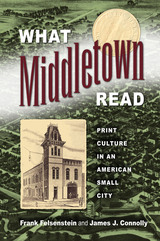 What Middletown Read: Print Culture in an American Small City
Frank Felsenstein
University of Massachusetts Press, 2015 The discovery of a large cache of circulation records from the Muncie, Indiana, Public Library in 2003 offers unprecedented detail about American reading behavior at the turn of the twentieth century. Frank Felsenstein and James J. Connolly have mined these records to produce an in-depth account of print culture in Muncie, the city featured in the famed "Middletown" studies conducted by Robert and Helen Lynd almost a century ago. Using the data assembled and made public through the What Middletown Read Database (www.bsu.edu/libraries/wmr), a celebrated new resource the authors helped launch, Felsenstein and Connolly analyze the borrowing choices and reading culture of social groups and individuals.
What Middletown Read is much more than a statistical study. Felsenstein and Connolly dig into diaries, meeting minutes, newspaper reports, and local histories to trace the library's development in relation to the city's cosmopolitan aspirations, to profile individual readers, and to explore such topics as the relationship between children's reading and their schooling and what books were discussed by local women's clubs. The authors situate borrowing patterns and reading behavior within the contexts of a rapidly growing, culturally ambitious small city, an evolving public library, an expanding market for print, and the broad social changes that accompanied industrialization in the United States. The result is a rich, revealing portrait of the place of reading in an emblematic American community.
 What Money Can’t Buy: Family Income and Children’s Life Chances
Susan E. Mayer
Harvard University Press, 1997 Children from poor families generally do a lot worse than children from affluent families. They are more likely to develop behavior problems, to score lower on standardized tests, and to become adults in need of public assistance.
Susan Mayer asks whether income directly affects children's life chances, as many experts believe, or if the factors that cause parents to have low incomes also impede their children's life chances. She explores the question of causation with remarkable ingenuity. First, she compares the value of income from different sources to determine, for instance, if a dollar from welfare is as valuable as a dollar from wages. She then investigates whether parents' income after an event, such as teenage childbearing, can predict that event. If it can, this suggests that income is a proxy for unmeasured characteristics that affect both income and the event. Next she compares children living in states that pay high welfare benefits with children living in states with low benefits. Finally, she examines whether national income trends have the expected impact on children. Regardless of the research technique, the author finds that the effect of income on children's outcomes is smaller than many experts have thought.
Mayer then shows that the things families purchase as their income increases, such as cars and restaurant meals, seldom help children succeed. On the other hand, many of the things that do benefit children, such as books and educational outings, cost so little that their consumption depends on taste rather than income. Money alone, Mayer concludes, does not buy either the material or the psychological well-being that children require to succeed.
What Night Brings
Carla Trujillo
Northwestern University Press, 2003 What Night Brings focuses on a Chicano working-class family living in California during the 1960s. Marci—smart, feisty and funny—tells the story with the wisdom of someone twice her age as she determines to defy her family and God in order to find her identity, sexuality and freedom.
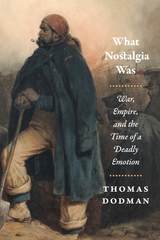 What Nostalgia Was: War, Empire, and the Time of a Deadly Emotion
Thomas Dodman
University of Chicago Press, 2017 Nostalgia today is seen as essentially benign, a wistful longing for the past. This wasn't always the case, however: from the late seventeenth century through the end of the nineteenth, nostalgia denoted a form of homesickness so extreme that it could sometimes be deadly.
What Nostalgia Was unearths that history. Thomas Dodman begins his story in Basel, where a nineteen-year-old medical student invented the new diagnosis, modeled on prevailing notions of melancholy. From there, Dodman traces its spread through the European republic of letters and into Napoleon's armies, as French soldiers far from home were diagnosed and treated for the disease. Nostalgia then gradually transformed from a medical term to a more expansive cultural concept, one that encompassed Romantic notions of the aesthetic pleasure of suffering. But the decisive shift toward its contemporary meaning occurred in the colonies, where Frenchmen worried about racial and cultural mixing came to view moderate homesickness as salutary. An afterword reflects on how the history of nostalgia can help us understand the transformations of the modern world, rounding out a surprising, fascinating tour through the history of a durable idea.
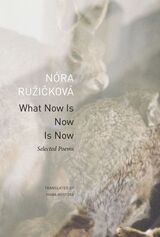 What Now Is Now Is Now: Selected Poems
Nóra Ružicková
Seagull Books, 2025 A selection of poems that blend raw imagery with experimental forms, offering a vivid exploration of the body, language and shifting identities.
Nóra Ružičková’s poetry merges bodily experience with linguistic experimentation, evolving from self-reflection to an exploration of the complexities of gender and Central European identity. Her work deftly weaves personal narratives with political and social commentary, forging poems that are both intellectually provocative and deeply embodied.
This selection spans nearly 25 years, tracing her work from a late-millennium debut to her latest, most socially engaged collection, which explores novelty within the grand narratives of modern history and critiques humanity's obsession with progress. Through her poems, she challenges the boundaries of language, blending physicality with abstraction through a combination of potent imagery and philosophical reflection. Her poetry treats the body as a space where meaning is simultaneously created and dismantled, probing themes of identity, existence and the instability of interpretation. By experimenting with materiality, bodily experience and the ever-changing mediascape, Ružičková captures the complexities of contemporary human life and dissolves the divide between language and physical reality. In its concluding section, the selection confronts pivotal historical moments and humanity’s relentless pursuit of progress, making for a powerful, thought-provoking engagement with the present.
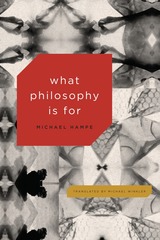 What Philosophy Is For
Michael Hampe
University of Chicago Press, 2018 What is the state of philosophy today, and what might it be tomorrow? With What Philosophy Is For, Michael Hampe answers these questions by exploring the relationships among philosophy, education, science, and narrative, developing a Socratic critique of philosophical doctrines.
Philosophers generally develop systematic theories that lay out the basic structures of human experience, in order to teach the rest of humanity how to rightly understand our place in the world. This “scientific” approach to philosophy, Hampe argues, is too one-sided. In this magnum opus of an essay, Hampe aims to rescue philosophy from its current narrow claims of doctrine and to remind us what it is really for—to productively disillusion us into clearer thinking. Hampe takes us through twenty-five hundred years of intellectual history, starting with Socrates. That archetype of the philosophical teacher did not develop strict doctrines and rules, but rather criticized and refuted doctrines. With the Socratic method, we see the power of narration at work. Narrative and analytical disillusionment, Hampe argues, are the most helpful long-term enterprises of thought, the ones most worth preserving and developing again.
What Philosophy Is For is simultaneously an introduction, a critique, and a call to action. Hampe shows how and why philosophy became what it is today, and, crucially, shows what it could be once more, if it would only turn its back on its pretensions to dogma: a privileged space for reflecting on the human condition.
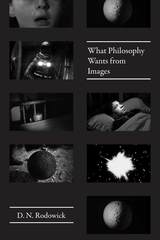 What Philosophy Wants from Images
D. N. Rodowick
University of Chicago Press, 2017 In recent decades, contemporary art has displayed an ever increasing and complicated fascination with the cinema—or, perhaps more accurately, as D. N. Rodowick shows, a certain memory of cinema. Contemporary works of film, video, and moving image installation mine a vast and virtual archive of cultural experience through elliptical and discontinuous fragments of remembered images, even as the lived experience of film and photography recedes into the past, supplanted by the digital.
Rodowick here explores work by artists such as Ken Jacobs, Ernie Gehr, Victor Burgin, Harun Farocki, and others—artists who are creating forms that express a new historical consciousness of images. These forms acknowledge a complex relationship to the disappearing past even as they point toward new media that will challenge viewers’ confidence in what the images they see are or are becoming. What philosophy wants from images, Rodowick shows, is to renew itself conceptually through deep engagement with new forms of aesthetic experience.
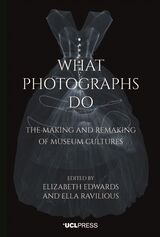 What Photographs Do: The Making and Remaking of Museum Cultures
Edited by Elizabeth Edwards and Ella Ravilious
University College London, 2022 A collective case study of photographic culture through the lens of the Victoria and Albert Museum.
A massive quantity of museums’ photographic holdings resides not on gallery walls or archives, but outside of their formal collections, including reference photos and ephemera that are integral to the workings of museums. What Photographs Do explores how museums are defined through their photographic practices. Studied through the prism of the Victoria and Albert Museum in London, this collection asks complex and ambiguous questions about how accumulations of photographs create the values, hierarchies, histories, and knowledge systems of a museum ecosystem. Chapters are comprised of short, auto-ethnographic interventions from museum practitioners, from studio photographers and image managers to conservators and non-photographic curators, who address the significance of both historical and contemporary practices of photography in their work, providing an extensive and unique range of accounts of what photographs do in museums while also expanding the critical discourse of both photography and museums.
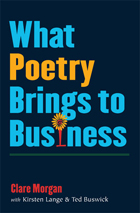 What Poetry Brings to Business
Morgan Clare, Kristen Lange, Ted Buswick
University of Michigan Press, 2010 "Creativity is a means of controlling chaos, finding order. Business and poetry draw their waters out of the same well."
---John Barr, President, Poetry Foundation "At last there is a book that explores the deep but unexpected connections between business and poetry. Clare Morgan and her colleagues demonstrate how the creative energy, emotional power, and communicative complexity of poetry relate directly to the practical needs for innovation and problem solving that face business managers. There has never been a book on developing managerial potential quite like this one."
---Dana Gioia, former chairman of the National Endowment for the Arts and a former corporate executive at General Foods What does poetry bring to business? According to Clare Morgan and her coauthors, it brings complexity and flexibility of thinking, along with the ability to empathize with and better understand the thoughts and feelings of others. Through her own experiences and many examples, Morgan demonstrates that the skills necessary to talk and think about poetry can be of significant benefit to leaders and strategists, to executives who are facing infinite complexity and who are armed with finite resources in a changing world. What Poetry Brings to Business presents ways in which reading and thinking about poetry offer businesspeople new strategies for reflection on their companies, their daily tasks, and their work environments. The goal is both to increase and broaden readers' understanding of poems and how they convey meaning, and also to help readers develop analytical and cognitive skills that will be beneficial in a business context. The unique combinations and connections made in this book will open new avenues of thinking about poetry and business alike. Clare Morgan is Director of the graduate creative writing programme at the University of Oxford. She has run workshops and given presentations on this topic in the United States, the United Kingdom, continental Europe, and Japan. Dr. Morgan is a fiction writer and critic, and a Fellow of the Royal Society of Arts. Kirsten Lange and Ted Buswick are employed by The Boston Consulting Group, an international management consulting firm, she as Managing Director of the Munich office, he as head of Oral History and Archiving.
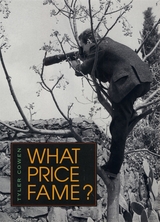 What Price Fame?
Tyler Cowen
Harvard University Press, 2000 In a world where more people know who Princess Di was than who their own senators are, where Graceland draws more visitors per year than the White House, and where Michael Jordan is an industry unto himself, fame and celebrity are central currencies. In this intriguing book, Tyler Cowen explores and elucidates the economics of fame.
Fame motivates the talented and draws like-minded fans together. But it also may put profitability ahead of quality, visibility above subtlety, and privacy out of reach. The separation of fame and merit is one of the central dilemmas Cowen considers in his account of the modern market economy. He shows how fame is produced, outlines the principles that govern who becomes famous and why, and discusses whether fame-seeking behavior harmonizes individual and social interests or corrupts social discourse and degrades culture.
Most pertinently, Cowen considers the implications of modern fame for creativity, privacy, and morality. Where critics from Plato to Allan Bloom have decried the quest for fame, Cowen takes a more pragmatic, optimistic view. He identifies the benefits of a fame-intensive society and makes a persuasive case that however bad fame may turn out to be for the famous, it is generally good for society and culture.
 What Price Mental Health?: The Ethics and Politics of Setting Priorities
Philip J. Boyle and Daniel Callahan, Editors
Georgetown University Press Regardless of the fate of national health care reform, public policy makers will have to make difficult and tragic choices about which health services are more or less important. This volume, the first comprehensive examination of setting mental health services priorities, systematically explores the history, ethics, and politics of setting priorities for public mental health services. Because mental health services have traditionally been given lower priority and less generous benefits than general health services, they form a striking case study for priority setting. Written by mental health care practitioners and scholars, What Price Mental Health? explores the social factors that most influence attempts to set priorities; offers case studies at the state level; illustrates priorities at the federal level and in the private sector; and identifies the ethical criteria that must be applied in any attempt to set priorities. This volume is conceptionally rich for those familiar with mental health care research, but written in a style understandable to the general reader. Policy makers will find the book useful in the on-going debates about mental health care. Psychologists, public health professionals, researchers and students of psychology, public policy and public health will find this study an absorbing and informative addition to the mental health field.
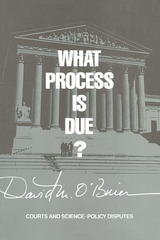 What Process is Due?: Courts and Science-Policy Disputes
David M. O'Brien
Russell Sage Foundation, 1987 Are judges competent to decide complex scientific disputes over toxic chemicals and hazardous wastes? Have courts gone too far in awarding damages to victims? Does the judiciary unreasonably constrain free market forces and usurp power from democratically elected branches of government? What constitutes judicial "due process" in the regulation of health-safety and environmental risks? David O'Brien addresses these and other key questions in a comprehensive survey of the role of courts in resolving science-policy disputes. He theorizes that such disputes, with their burden of scientific uncertainty and intense value conflict, become judicialized in the United States because they pose an uncomfortable trilemma for policy makers: how to accommodate competing demands for scientific certainty, political compromise, and procedural fairness in the regulation of risks. When policy negotiations break down, courts are called on not to settle scientific controversies per se, but in their traditional role as independent tribunals for settling value conflicts and imposing norms in a pluralistic society. This interpretation is enhanced by a unique set of case studies, including DES and asbestos litigation and the ban on Tris (a carcinogenic flame-retardent). O'Brien's analytical framework and his detailed examples illuminate the extent, the implications, and the underlying causes of the judicialization of risk regulation.
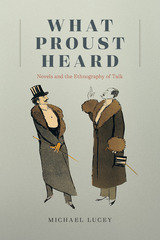 What Proust Heard: Novels and the Ethnography of Talk
Michael Lucey
University of Chicago Press, 2022 Michael Lucey offers a linguistic anthropological analysis of Proust’s In Search of Lost Time.
What happens when we talk? This deceptively simple question is central to Marcel Proust’s monumental novel In Search of Lost Time. Both Proust’s narrator and the novel that houses him devote considerable energy to investigating not just what people are saying or doing when they talk, but also what happens socioculturally through their use of language. Proust, in other words, is interested in what linguistic anthropologists call language-in-use.
Michael Lucey elucidates Proust’s approach to language-in-use in a number of ways: principally in relation to linguistic anthropology, but also in relation to speech act theory, and to Pierre Bourdieu’s sociology. The book also includes an interlude after each of its chapters that contextualizes Proust’s social-scientific practice of novel writing in relation to that of a number of other novelists, earlier and later, and from several different traditions, including Honoré de Balzac, George Eliot, Virginia Woolf, Nathalie Sarraute, and Rachel Cusk. Lucey is thus able to show how, in the hands of quite different novelists, various aspects of the novel form become instruments of linguistic anthropological analysis. The result introduces a different way of understanding language to literary and cultural critics and explores the consequences of this new understanding for the practice of literary criticism more generally.
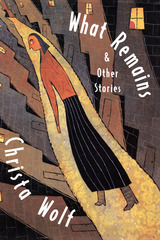 What Remains and Other Stories
Christa Wolf
University of Chicago Press, 1995 What Remains collects Christa Wolf's short fiction, from early work in the sixties to the widely debated title story, first published in Germany in 1990. Addressing a wide range of topics, from sexual politics to the nature of memory, these powerful and often very personal stories offer a fascinating introduction to Wolf's work.
What Remains and Other Stories . . . is clear and farsighted. The eight heartfelt stories in the book show why she has been respected as a serious author since her 1968 novel, The Quest for Christa T. . . . Wolf uses her own experiences and observations to create universal themes about the controls upon human freedom.—Herbert Mitgang, New York Times
Christa Wolf has set herself nothing less than the task of exploring what it is to be a conscious human being alive in a moment of history.—Mary Gordon, New York Times Book Review
The simultaneous publication of these two volumes offers readers here a generous sampling of the short fiction, speeches and essays that Wolf has produced over the last three decades.—Mark Harman, Boston Globe
 What Remains: Bringing America’s Missing Home from the Vietnam War
Sarah E. Wagner
Harvard University Press, 2019 Winner of the 2020 Victor Turner Prize in Ethnographic Writing
Nearly 1,600 Americans are still unaccounted for and presumed dead from the Vietnam War. These are the stories of those who mourn and continue to search for them.
For many families the Vietnam War remains unsettled. Nearly 1,600 Americans—and more than 300,000 Vietnamese—involved in the conflict are still unaccounted for. In What Remains, Sarah E. Wagner tells the stories of America’s missing service members and the families and communities that continue to search for them. From the scientists who work to identify the dead using bits of bone unearthed in Vietnamese jungles to the relatives who press government officials to find the remains of their loved ones, Wagner introduces us to the men and women who seek to bring the missing back home. Through their experiences she examines the ongoing toll of America’s most fraught war.
Every generation has known the uncertainties of war. Collective memorials, such as the Tomb of the Unknowns in Arlington National Cemetery, testify to the many service members who never return, their fates still unresolved. But advances in forensic science have provided new and powerful tools to identify the remains of the missing, often from the merest trace—a tooth or other fragment. These new techniques have enabled military experts to recover, repatriate, identify, and return the remains of lost service members. So promising are these scientific developments that they have raised the expectations of military families hoping to locate their missing. As Wagner shows, the possibility of such homecomings compels Americans to wrestle anew with their memories, as with the weight of their loved ones’ sacrifices, and to reevaluate what it means to wage war and die on behalf of the nation.
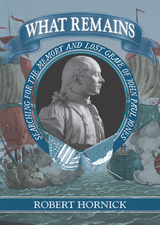 What Remains: Searching for the Memory and Lost Grave of John Paul Jones
Robert Hornick
University of Massachusetts Press, 2017 John Paul Jones is now considered a Revolutionary War hero and the father of the American Navy, his defiant words "I have not yet begun to fight!" the epitome of courage under fire. It has not always been so. When the Revolutionary War ended, Jones's celebrity vanished. His death in Paris a decade later went unnoticed; he was buried in a foreign grave and forgotten by his fellow Americans.
In What Remains, Robert Hornick explores why Jones was forgotten, the subsequent recovery of his memory and remains, and the much delayed commemoration of his achievement. The book chronicles the efforts of the men and women who, in the nineteenth and early twentieth centuries, reconstructed Jones's legacy, searched for and finally found his lost grave, and returned both his physical remains and his memory to a place of honor. It also recounts the extraordinary moment when Theodore Roosevelt utilized Jones's commemoration to proclaim America a global power. What Remains offers a fascinating story of opportunists and evangelists: of politicians who needed Jones to advance their agendas, but also of fellow warriors committed to recovering one of their own from obscurity and shame.
What Role for Government?: Lessons from Policy Research
Richard J. Zeckhauser and Derek Leebaert, eds.
Duke University Press, 1983 The vital debates on government today are concerned with its social role, its participation in the economy, and its redistributive responsibilities. These functions, not defined in the Constitution, reflect the evolution of society and its values and the powerful but jerky hand of the political process.
What Saves Us
Bruce Weigl
Northwestern University Press, 1994 Winner, 2006 Lannan Foundation Award for Poetry
In these wrenching, elegant poems, Bruce Weigl writes out of uncompromising memory and vision. His subject is both the transport and anguish of being open to the lived and living moment. From bars and bedrooms, in Ohio and Nicaragua and Vietnam, his voice rises through the noise of history and habit to reach us with impeccable grace and remarkable invention.
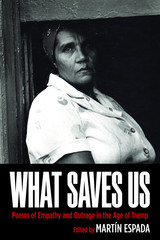 What Saves Us: Poems of Empathy and Outrage in the Age of Trump
Edited by Martín Espada
Northwestern University Press, 2019 This is an anthology of poems in the Age of Trump—and much more than Trump. These are poems that either embody or express a sense of empathy or outrage, both prior to and following his election, since it is empathy the president lacks and outrage he provokes.
There is an extraordinary diversity of voices here. The ninety-three poets featured include Elizabeth Alexander, Julia Alvarez, Richard Blanco, Carolyn Forché, Aracelis Girmay, Donald Hall, Juan Felipe Herrera, Yusef Komunyakaa, Naomi Shihab Nye, Marge Piercy, Robert Pinsky, Danez Smith, Patricia Smith, Brian Turner, Ocean Vuong, Bruce Weigl, and Eleanor Wilner. They speak of persecuted and scapegoated immigrants. They bear witness to violence: police brutality against African Americans, mass shootings in a school or synagogue, the rage inflicted on women everywhere. They testify to poverty: the waitress surviving on leftovers at the restaurant, the battles of a teacher in a shelter for homeless mothers, the emergency-room doctor listening to the heartbeats of his patients. There are voices of labor, in the factory and the fields. There are prophetic voices, imploring us to imagine the world we will leave behind in ruins lest we speak and act.
However, this is not merely a collection of grievances. The poets build bridges. One poet steps up to translate in Arabic at the airport; another walks through the city and sees her immigrant past in the immigrant present; another declaims a musical manifesto after the hurricane that devastated his island; another evokes a demonstration in the street, shouting in an ecstasy of defiance. The poets take back the language, resisting the demagogic corruption of words themselves. They assert our common humanity in the face of dehumanization.
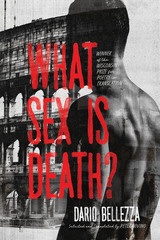 What Sex Is Death?
Dario Bellezza, Selected and Translated by Peter Covino
University of Wisconsin Press, 2025 Dario Bellezza—Italy’s first openly gay, major prize winning poet-novelist-playwright—was a bold, daring writer who energetically explored love, sexual transformation, and death. Bellezza embraced a variety of forms, from unabashed love-lyric to political narrative, and the fervor of his voice makes a compelling argument for his lasting importance as one of the most remarkable poets of the late twentieth century. Yet, until now, his work has never been available in English. Award-winning translator Peter Covino offers a wide-ranging selection of representative poetry from Bellezza’s career. Influenced by Rimbaud, the Beats, and the growing European gay rights movements, his poetry remains innovative and timely. Ranging from stray cats in the graveyards of Rome, to the literal and metaphoric fallout from the Chernobyl disaster, to the joys and disappointments of random hookups, Bellezza’s dazzling visions will sparkle in readers’ eyes like sunspots long after they complete this magnificent volume.
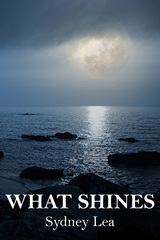 What Shines
Sydney Lea
Four Way Books Retrospective of a long life and already inimitable career in poetry, Sydney Lea’s What Shines asserts and asks in equal measure. In older age, Lea affirms the luster of fruit long labored for: a resilient and happy marriage; the rewards of parenthood and, later, grandchildren; a profound intimacy with northern New England — the environment, the seasons, the people, home, time. But he also transmits the escalating urgency of answering the fundamental question: at this late hour, what light do we have to see by? What light will outlast us? In “1949,” Lea revisits old photographs: one of his parents “both grinning straight at the Kodak, / an elm, not yet blighted to death, at their backs,” another of his mother standing beside a bucket of sunfish. “With what I’ve known, you’d think there’d be chapter on chapter,” he says, everything habitual, familiar. Still he stumbles upon revelation, the visceral novelty of experience, and Lea’s brilliant shock glimmers in the golden hour. “I shouldn’t be,” he disclaims, “and yet somehow I’m stunned: / Even the fish in that yellowed photo are young.” Despite the accelerating onset of autumn, consolations line the path “at the edge / of our late-shorn meadow,” where there lie blackberries that “should have vanished by now.” And so what if a handful will not disarm winter? “Though tiny and poor, it's sweet, / the fruit, even more so / than when I found more.” If we receive this allotment of days once and only once, Lea’s consummate collection urges us to remember the spirit of the lyric itself: although we couldn’t keep it all forever, when we had it, my God, so much of it was sweet.
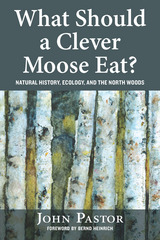 What Should a Clever Moose Eat?: Natural History, Ecology, and the North Woods
John Pastor
Island Press, 2015 How long should a leaf live? When should blueberries ripen? And what should a clever moose eat? Questions like these may seem simple or downright strange—yet they form the backbone of natural history, a discipline that fostered some of our most important scientific theories, from natural selection to glaciation. Through careful, patient observations of the organisms that live in an area, their distributions, and how they interact with other species, we gain a more complete picture of the world around us, and our place in it.
In What Should a Clever Moose Eat?, John Pastor explores the natural history of the North Woods, an immense and complex forest that stretches from the western shore of Lake Superior to the far coast of Newfoundland. The North Woods is one of the most ecologically and geologically interesting places on the planet, with a host of natural history questions arising from each spruce or sugar maple. From the geological history of the region to the shapes of leaves and the relationship between aspens, caterpillars, and predators, Pastor delves into a captivating range of topics as diverse as the North Woods themselves. Through his meticulous observations of the natural world, scientists and nonscientists alike learn to ask natural history questions and form their own theories, gaining a greater understanding of and love for the North Woods—and other natural places precious to them.
In the tradition of Charles Darwin and Henry David Thoreau, John Pastor is a joyful observer of nature who makes sharp connections and moves deftly from observation to theory. Take a walk in John Pastor's North Woods—you'll come away with a new appreciation for details, for the game trails, beaver ponds, and patterns of growth around you, and won't look at the natural world in the same way again.
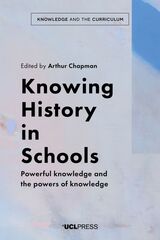 What Should Schools Teach?: Disciplines, Subjects and the Pursuit of Truth
Edited by Alka Sehgal Cuthbert and Alex Standish
University College London, 2021 A robust rationale on what schools should teach and how.
The design of school curricula involves deep thought about the nature of knowledge and its value to learners and society. Such a serious responsibility raises a number of questions: What is knowledge for? What knowledge is important for children to learn? How do we decide what knowledge matters in each school subject? The blurring of distinctions between pedagogy and curriculum, as well as that between experience and knowledge, has resulted in a confusing message for teachers about the part that each plays in the education of children. This book aims to dispel confusion through a robust rationale for what schools should teach, offering key understanding to teachers of the relationship between knowledge and their own pedagogy. This second edition includes new chapters on chemistry, drama, music, and religious education, as well as an updated chapter on biology. A revised introduction reflects on the emerging discourse around decolonizing the curriculum and on the relationship between the knowledge that children encounter at school and in their homes.
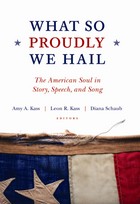 What So Proudly We Hail: The American Soul in Story, Speech, and Song
Amy A. Kass
Intercollegiate Studies Institute, 2011
A book for educating citizens
This wonderfully rich anthology uses the soul-shaping power of story, speech, and song to help Americans realize more deeply—and appreciate more fully—who they are as citizens of the United States.
At once inspiring and thought-provoking, What So Proudly We Hail features dozens of selections on American identity, character, and civic life by our country’s greatest writers and leaders—from Mark Twain to John Updike, from George Washington to Theodore Roosevelt, from Willa Cather to Flannery O’Connor, from Benjamin Franklin to Martin Luther King Jr., from Francis Scott Key to Irving Berlin.
Developing robust American citizens involves educating the heart as well as the mind. It is not enough to understand our nation’s lofty principles or know our history; thoughtful and engaged citizens require cultivated moral imaginations and fitting sentiments and attitudes—matters both displayed in and nurtured by our great works of imaginative literature and rhetoric.
Featuring the editors’ insightful and instructive commentary, What So Proudly We Hail illuminates our national identity, the American creed, the American character, and the virtues and aspirations of active citizenship. This marvelous book will not only be a fixture on bedside tables; it will also spark conversations in homes, schools, colleges, and reading groups everywhere.
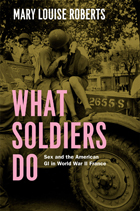 What Soldiers Do: Sex and the American GI in World War II France
Mary Louise Roberts
University of Chicago Press, 2013 How do you convince men to charge across heavily mined beaches into deadly machine-gun fire? Do you appeal to their bonds with their fellow soldiers, their patriotism, their desire to end tyranny and mass murder? Certainly—but if you’re the US Army in 1944, you also try another tack: you dangle the lure of beautiful French women, waiting just on the other side of the wire, ready to reward their liberators in oh so many ways.
That’s not the picture of the Greatest Generation that we’ve been given, but it’s the one Mary Louise Roberts paints to devastating effect in What Soldiers Do. Drawing on an incredible range of sources, including news reports, propaganda and training materials, official planning documents, wartime diaries, and memoirs, Roberts tells the fascinating and troubling story of how the US military command systematically spread—and then exploited—the myth of French women as sexually experienced and available. The resulting chaos—ranging from flagrant public sex with prostitutes to outright rape and rampant venereal disease—horrified the war-weary and demoralized French population. The sexual predation, and the blithe response of the American military leadership, also caused serious friction between the two nations just as they were attempting to settle questions of long-term control over the liberated territories and the restoration of French sovereignty.
While never denying the achievement of D-Day, or the bravery of the soldiers who took part, What Soldiers Do reminds us that history is always more useful—and more interesting—when it is most honest, and when it goes beyond the burnished beauty of nostalgia to grapple with the real lives and real mistakes of the people who lived it.
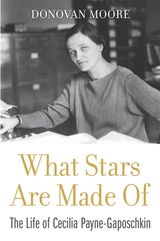 What Stars Are Made Of: The Life of Cecilia Payne-Gaposchkin
Donovan Moore
Harvard University Press, 2020 A New Scientist Book of the Year
A Physics Today Book of the Year
A Science News Book of the Year
The history of science is replete with women getting little notice for their groundbreaking discoveries. Cecilia Payne-Gaposchkin, a tireless innovator who correctly theorized the substance of stars, was one of them.
It was not easy being a woman of ambition in early twentieth-century England, much less one who wished to be a scientist. Cecilia Payne-Gaposchkin overcame prodigious obstacles to become a woman of many firsts: the first to receive a PhD in astronomy from Radcliffe College, the first promoted to full professor at Harvard, the first to head a department there. And, in what has been called “the most brilliant PhD thesis ever written in astronomy,” she was the first to describe what stars are made of.
Payne-Gaposchkin lived in a society that did not know what to make of a determined schoolgirl who wanted to know everything. She was derided in college and refused a degree. As a graduate student, she faced formidable skepticism. Revolutionary ideas rarely enjoy instantaneous acceptance, but the learned men of the astronomical community found hers especially hard to take seriously. Though welcomed at the Harvard College Observatory, she worked for years without recognition or status. Still, she accomplished what every scientist yearns for: discovery. She revealed the atomic composition of stars—only to be told that her conclusions were wrong by the very man who would later show her to be correct.
In What Stars Are Made Of, Donovan Moore brings this remarkable woman to life through extensive archival research, family interviews, and photographs. Moore retraces Payne-Gaposchkin’s steps with visits to cramped observatories and nighttime bicycle rides through the streets of Cambridge, England. The result is a story of devotion and tenacity that speaks powerfully to our own time.
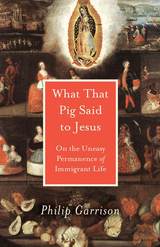 What That Pig Said to Jesus: On the Uneasy Permanence of Immigrant Life
Philip Garrison
University of Utah Press, 2017 Philip Garrison says his book of essays is “in praise of mixed feelings,” particularly the mixed feelings he and his neighbors have toward the places they came from. His neighborhood is the Columbia Plateau, one of many North American nodes of immigration. Following a meandering, though purposeful trail, Garrison catches hillbillies and newer Mexican arrivals in ambiguous, wary encounters on a set four hundred years in the making, built on a foundation of Native American displacement. Garrison is the product of the earlier surge of new arrivals: from the 1930s to the 1970s, those he calls hillbillies left such mid-nation states as Arkansas, Missouri, Oklahoma, Kansas, and the Dakotas for the West. The more recent wave, from 1990 to 2010, came mostly from the central plateau of Mexico. These are folks with whom Garrison communes in multiple ways. Anecdotes from sources as varied as pioneer diaries, railroad promotions, family Bibles, Wikipedia, and local gossip “portray the region's immigration as a kind of identity makeover, one that takes the form first of breakdown, then of reassembly, and finally of renewal.” Garrison’s mix of slangy memoir and anthropological field notes shines light on the human condition in today’s West.
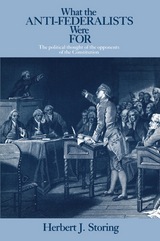 What the Anti-Federalists Were For: The Political Thought of the Opponents of the Constitution
Herbert J. Storing
University of Chicago Press, 1981 The Anti-Federalists, in Herbert J. Storing's view, are somewhat paradoxically entitled to be counted among the Founding Fathers and to share in the honor and study devoted to the founding. "If the foundations of the American polity was laid by the Federalists," he writes, "the Anti-Federalist reservations echo through American history; and it is in the dialogue, not merely in the Federalist victory, that the country's principles are to be discovered." It was largely through their efforts, he reminds us, that the Constitution was so quickly amended to include a bill of rights.
Storing here offers a brilliant introduction to the thought and principles of the Anti-Federalists as they were understood by themselves and by other men and women of their time. His comprehensive exposition restores to our understanding the Anti-Federalist share in the founding its effect on some of the enduring themes and tensions of American political life. The concern with big government and infringement of personal liberty one finds in the writings of these neglected Founders strikes a remarkably timely note.
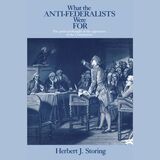 What the Anti-Federalists Were For: The Political Thought of the Opponents of the Constitution
Herbert J. Storing
University of Chicago Press, 1981 This is an auto-narrated audiobook version of this book.
The Anti-Federalists, in Herbert J. Storing's view, are somewhat paradoxically entitled to be counted among the Founding Fathers and to share in the honor and study devoted to the founding. "If the foundations of the American polity was laid by the Federalists," he writes, "the Anti-Federalist reservations echo through American history; and it is in the dialogue, not merely in the Federalist victory, that the country's principles are to be discovered." It was largely through their efforts, he reminds us, that the Constitution was so quickly amended to include a bill of rights.
Storing here offers a brilliant introduction to the thought and principles of the Anti-Federalists as they were understood by themselves and by other men and women of their time. His comprehensive exposition restores to our understanding the Anti-Federalist share in the founding its effect on some of the enduring themes and tensions of American political life. The concern with big government and infringement of personal liberty one finds in the writings of these neglected Founders strikes a remarkably timely note.
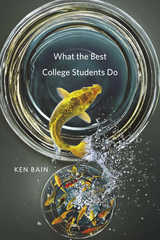 What the Best College Students Do
Ken Bain
Harvard University Press, 2012 The author of the best-selling What the Best College Teachers Do is back with more humane, doable, and inspiring help, this time for students who want to get the most out of college—and every other educational enterprise, too.
The first thing they should do? Think beyond the transcript. The creative, successful people profiled in this book—college graduates who went on to change the world we live in—aimed higher than straight A’s. They used their four years to cultivate habits of thought that would enable them to grow and adapt throughout their lives.
Combining academic research on learning and motivation with insights drawn from interviews with people who have won Nobel Prizes, Emmys, fame, or the admiration of people in their field, Ken Bain identifies the key attitudes that distinguished the best college students from their peers. These individuals started out with the belief that intelligence and ability are expandable, not fixed. This led them to make connections across disciplines, to develop a “meta-cognitive” understanding of their own ways of thinking, and to find ways to negotiate ill-structured problems rather than simply looking for right answers. Intrinsically motivated by their own sense of purpose, they were not demoralized by failure nor overly impressed with conventional notions of success. These movers and shakers didn’t achieve success by making success their goal. For them, it was a byproduct of following their intellectual curiosity, solving useful problems, and taking risks in order to learn and grow.
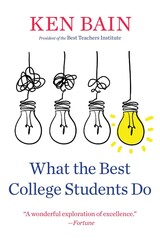 What the Best College Students Do
Ken Bain
Harvard University Press “The ‘best’ students are curious risk-takers who make connections across disciplines. By following those instincts—rather than simply chasing ‘success’—the best students achieved it…A wonderful exploration of excellence.”—Fortune
“Skillfully weaves together some of the best research about effective learning strategies with moving stories about remarkable life-long learners. Some of them had great teachers. But most of them succeed because of what they did for themselves.”—Thomas Luxon, Dartmouth College
“We are always telling students to ‘find their passion.’ Now we have a book that looks at how that happens…Ken Bain can really tell a story…it is very rare for a book based upon research to be such a compelling read.”—José Antonio Bowen, Southern Methodist University
Combining academic research on learning and motivation with insights drawn from interviews with people who have won Nobel Prizes, Emmys, or otherwise led lives of meaning and accomplishment, Ken Bain identifies the key attitudes that distinguish the best college students from their peers. Most start out with a belief that intelligence and ability are expandable, not fixed. This leads them to make connections across disciplines and to find ways of reconceiving problems rather than simply looking for the right answer. Intrinsically motivated by their own sense of purpose, they are not overly impressed with conventional notions of success. The best students study in small bites, focus more on concept than procedure, and work collaboratively, getting friends to test them on their knowledge. They don’t achieve success by making success their goal—when it comes, it is a byproduct of following their intellectual curiosity, solving useful problems, and taking risks to learn and grow.
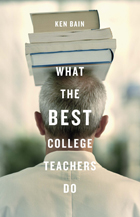 What the Best College Teachers Do
Ken Bain
Harvard University Press, 2004 What makes a great teacher great? Who are the professors students remember long after graduation? This book, the conclusion of a fifteen-year study of nearly one hundred college teachers in a wide variety of fields and universities, offers valuable answers for all educators.
The short answer is—it’s not what teachers do, it’s what they understand. Lesson plans and lecture notes matter less than the special way teachers comprehend the subject and value human learning. Whether historians or physicists, in El Paso or St. Paul, the best teachers know their subjects inside and out—but they also know how to engage and challenge students and to provoke impassioned responses. Most of all, they believe two things fervently: that teaching matters and that students can learn.
In stories both humorous and touching, Ken Bain describes examples of ingenuity and compassion, of students’ discoveries of new ideas and the depth of their own potential. What the Best College Teachers Do is a treasure trove of insight and inspiration for first-year teachers and seasoned educators.
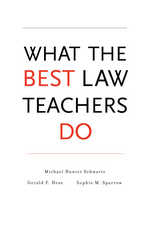 What the Best Law Teachers Do
Michael Hunter Schwartz, Gerald F. Hess, and Sophie M. Sparrow
Harvard University Press, 2013 What makes a great law professor? The first study of its kind, What the Best Law Teachers Do identifies the methods, strategies, and personal traits of professors whose students achieve exceptional learning. This pioneering book will be of interest to any instructor seeking concrete, proven techniques for helping students succeed.
What the Best Law Teachers Do introduces readers to twenty-six professors from law schools across the United States. These instructors are renowned for their exacting standards: they set expectations high, while also making course requirements--and their belief that their students can meet them--clear from the outset. They demonstrate professional behavior and tell students to approach class as they would their future professional life: by being as prepared, polished, and gracious as possible. And they prepare themselves for class in depth, even when they have taught the course for years.
The best law professors understand that the little things matter. They start class on time and stay afterward to answer questions. They learn their students' names and respond promptly to emails. These instructors are all tough--but they are also committed, creative, and compassionate mentors. With its close-to-the-ground accounts of exceptional educators in action, What the Best Law Teachers Do offers insights into effective pedagogy that transcend the boundaries of legal education.
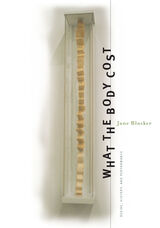 What The Body Cost: Desire, History, And Performance
Jane Blocker
University of Minnesota Press, 2004 Reexamines rebelliousness and desire in the history of performance art Because performance is by its very nature ephemeral, it elicits a desire for what is lost more than any other form of art making. But what is the nature of that desire, and on what models has it been structured? How has it affected the ways in which the history of performance art gets told? In What the Body Cost, Jane Blocker revisits key works in performance art by Carolee Schneemann, Vito Acconci, Hannah Wilke, Yves Klein, Ana Mendieta, and others to challenge earlier critiques that characterize performance, or body art, as a purely revolutionary art form and fail to recognize its reactionary—and sometimes damaging—effects. The scholarship to date on performance art has not, she finds, gone far enough in locating the body at the center of the performance, nor has it acknowledged the psychic, emotional, or social costs exacted on that body. Drawing on the work of critical theorists such as Roland Barthes and Catherine Belsey, as well as queer theory and feminism, What the Body Cost reads against patriarchal and heteronormative tendencies in art history while providing a corrective to the established view that performance art is necessarily transgressive. Instead, Blocker suggests that the historiography of performance art is a postmodern lovers’s discourse in which practitioners, historians, and critics alike fervently seek the body while doubting it can ever be found.
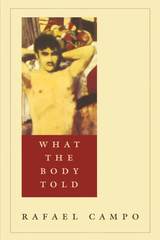 What the Body Told
Rafael Campo
Duke University Press, 1996 What the Body Told is the second book of poetry from Rafael Campo, a practicing physician, a gay Cuban American, and winner of the National Poetry Series 1993 Open Competition. Exploring the themes begun in his first book, The Other Man Was Me, Campo extends the search for identity into new realms of fantasy and physicality. He travels inwardly to the most intimate spaces of the imagination where sexuality and gender collide and where life crosses into death. Whether facing a frenetic hospital emergency room to assess a patient critically ill with AIDS, or breathing in the quiet of his mother’s closet, Campo proposes with these poems an alternative means of healing and exposes the extent to which words themselves may be the most vital working parts of our bodies. The secret truths in What the Body Told, as the title implies, are already within each of us; in these vivid and provocative poems, Rafael Campo gives them a voice. Lost in the Hospital
It’s not that I don’t like the hospital.
Those small bouquets of flowers, pert and brave.
The smell of antiseptic cleansers.
The ill, so wistful in their rooms, so true.
My friend, the one who’s dying, took me out
To where the patients go to smoke, IV’s
And oxygen tanks attached to them—
A tiny patio for skeletons. We shared
A cigaratte, which was delicious but
Too brief. I held his hand; it felt
Like someone’s keys. How beautiful it was,
The sunlight pointing down at us, as if
We were important, full of life, unbound.
I wandered for a moment where his ribs
Had made a space for me, and there, beside
The thundering waterfall of is heart,
I rubbed my eyes and thought “I’m lost.”
What the Bones Tell Us
Jeffrey H. Schwartz
University of Arizona Press, 1997 A physical anthropologist exposes the inner workings of archaeology and anthropology, illustrating what can be learned from fossils and fragments of ancient cultures and civilizations. Schwartz ranges from digs in the Negev Desert through Africa and Europe to the local coroner's office to explain how interpretations of the past are made.
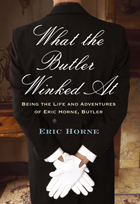 What the Butler Winked At: Being the Life and Adventures of Eric Horne, Butler
Eric Horne
Westholme Publishing, 2011 A Memoir of the Real Downton Abbey Experience
Eric Horne served as a butler in some of the great English country manors from the 1860s until just after World War I, when many of the families whose heirs died in battle were forced to sell off their homes. Born in Southampton, Horne came from a humble family who valued education. Horne excelled in school and wished to go to sea, but lacking his parents’ permission, he instead ended up as a footboy for a local household. Over the years, Horne moved up in the service of the aristocracy: his goal was to become butler to the king of England, a position he very nearly secured. He did end up in the service of several distinguished households for many decades, and upon his retirement in 1922, he decided to write his memoir. Horne is a unique voice; not only did he have intimate contact with his employers and the household staff, he also possessed literary talent, so that his account provides authentic detail as well as shrewd—and often witty—views of the aristocracy, the servants, and their activities. Horne is not sentimental though; he does not think that he used his life wisely, having never learned a true trade. He reveals the plight of the servant class, where once a butler lost his employment—particularly following the devastation of World War I—he was likely to end up in a poorhouse, because employers did not usually provide pensions and servants were rarely able to save enough money to survive on their own. What the Butler Winked At is a fascinating and essential account of life in a country house during the height of the Victorian and Edwardian eras.
 What The Negro Wants
Rayford W. Logan
University of Notre Dame Press, 2001 In 1944 Rayford Logan edited What The Negro Wants, outspoken essays by fifteen prominent African American intellectuals that collectively helped to set the agenda for the civil rights movement to come.
Kenneth R. Janken is Professor of African and Afro-American studies at the University of North Carolina, Chapel Hill. He is the author of Rayford R. Logan and The Dilemma of the African American Intellectual.
Reviews
"The essays which makeup the book vary widely in tone, in emotional attitude, and in specific details, but but taken together they offer a real cross-section of Negro opinion. I recommend this book most earnestly and congratulate both editor and publisher on the production of a book of true importance."
--Book Week, Chicago Sun
"...should be required reading for all Americans, white and Negro."
--Library Journal
"Rationalization and sublimation have been the means by which we have tried to solve the American race problem, and this ably written book is an outstanding example of the frontal approach."
--The New York Times Book Review
"The conspicious thing about the book is the spirit in which it is written, the absence of rancor and the small amount of bitterness, the reasonableness with which these men state their case, the patience with which they assume that the white man cannot forever live with his own hypocrisy."
--Weekly Book Review, New York Herald Tribune Books
--------------------------------------------------------------------------------
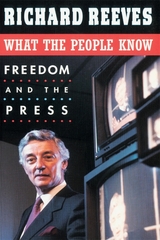 What the People Know: Freedom and the Press
Richard Reeves
Harvard University Press, 1998 The power and status of the press in America reached new heights after spectacular reporting triumphs in the segregated South, in Vietnam, and in Washington during the Watergate years. Then new technologies created instantaneous global reporting which left the government unable to control the flow of information to the nation. The press thus became a formidable rival in critical struggles to control what the people know and when they know it. But that was more power than the press could handle--and journalism crashed toward new lows in public esteem and public purpose.
The dazzling new technologies, profit-driven owners, and celebrated editors, reporters, and broadcasters made it possible to bypass older values and standards of journalism. Journalists reveled in lusty pursuit after the power of politics, the profits of entertainment and trespass into privacy. Richard Reeves was there at the rise and at the fall, beginning as a small-town editor, becoming the chief political correspondent of the New York Times and then a best-selling author and award-winning documentary filmmaker. He tells the story of a tribe that lost its way. From the Pony Express to the Internet, he chronicles what happened to the press as America accelerated into uncertainty, arguing that to survive, the press must go back to doing what it was hired to do long ago: stand as outsiders watching government and politics on behalf of a free people busy with their own affairs.
"What the Railroad Will Bring Us": The Legacy of the Transcontinental Railroad Corporations
Richard White
Utah State University Press, 2020 In volume 25 of the Arrington Lecture Series, Richard White discusses the transcontinental railroad’s impact on Utah’s environment, culture, and political atmosphere. In the 150 years since the completion of the Pacific Railroad, there have been lasting implications across the West, including for the early members of The Church of Jesus Christ of Latter-day Saints settlers.
The Arrington Lecture series, established by one of the twentieth-century West's most distinguished historians, Leonard Arrington, has become a leading forum for prominent historians to address topics related to Mormon history. Utah State University hosts the Leonard J. Arrington Mormon History Lecture Series through the Merrill-Cazier Library Special Collections and Archives department.
What the Right Hand Knows
Tom Healy
Four Way Books, 2009 Healy’s sensual, urgent debut collection moves from farmyard to cityscape as it depicts a teetering, asymmetric world. A speaker “deaf in one ear” ponders that “the Moon’s dark side / has no sound”; a mother and child finally “take the journey they’d talked about” but get only “a Sunday drive on Tuesday,” a near-miss “tracing circumferences.” Healy’s assured rhythms and measured stresses ballast the uncertainty of social relationships and bodily suffering. He seeks past the self for ways to act: “the task is to remember / the troubled blood of others, // and not remember // the bliss of deeper waters.” This book of “salt and work,” of surviving ourselves, our illnesses, and our language, tenderly explores the unsaid and under-the-surface of the separate lives we live together: “we sat // in the rocking chairs / of each other’s / moods.” An intimate, intelligent, and lively debut.
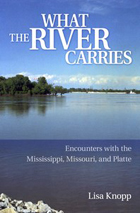 What the River Carries: Encounters with the Mississippi, Missouri, and Platte
Lisa Knopp
University of Missouri Press, 2012 In this informed and lyrical collection of interwoven essays, Lisa Knopp explores the physical and cultural geography of the Mississippi, Missouri, and Platte, rivers she has come to understand and cherish. At the same time, she contemplates how people experience landscape, identifying three primary roles of environmental perception: the insider, the outsider, and the outsider seeking to become an insider. Viewing the waterways through these approaches, she searches for knowledge and meaning.
Because Knopp was born and raised just a few blocks away, she considers the Mississippi from the perspective of a native resident, a “dweller in the land.” She revisits places she has long known: Nauvoo, Illinois, the site of two nineteenth-century utopias, one Mormon, one Icarian; Muscatine, Iowa, once the world’s largest manufacturer of pearl (mussel shell) buttons; and the mysterious prehistoric bird- and bear-shaped effigy mounds of northeastern Iowa. On a downriver trip between the Twin Cities and St. Louis, she meditates on what can be found in Mississippi river water—state lines, dissolved oxygen, smallmouth bass, corpses, family history, wrecked steamboats, mayfly nymphs, toxic perfluorinated chemicals, philosophies.
Knopp first encountered the Missouri as a tourist and became acquainted with it through literary and historical documents, as well as stories told by longtime residents. Her journey includes stops at Fort Bellefontaine, where Lewis and Clark first slept on their sojourn to the Pacific; Little Dixie, Missouri’s slaveholding, hemp-growing region, as revealed through the life of Jesse James’s mother; Fort Randall Dam and Lake Francis Case, the construction of which destroyed White Swan on the Yankton Sioux Reservation; and places that produced unique musical responses to the river, including Native American courting flutes, indie rock, Missouri River valley fiddling, Prohibition-era jazz jam sessions, and German folk music.
Knopp’s relationship with the Platte is marked by intentionality: she settled nearby and chose to develop deep and lasting connections over twenty years’ residence. On this adventure, she ponders the half-million sandhill cranes that pass through Nebraska each spring, the ancient varieties of Pawnee corn growing at the Great Platte River Road Archway Monument, a never-broken tract of tallgrass prairie, the sugar beet industry, and the changes in the river brought about by the demands of irrigation.
In the final essay, Knopp undertakes the science of river meanders, consecutive loops of water moving in opposite directions, which form around obstacles but also develop in the absence of them. What initiates the turning that results in a meander remains a mystery. Such is the subtle and interior process of knowing and loving a place. What the River Carries asks readers to consider their own relationships with landscape and how one can most meaningfully and responsibly dwell on the earth’s surface.
What the River Knows: An Angler in Midstream
Wayne Fields
University of Chicago Press, 1996 At the age of forty-two, Wayne Fields set upon a sort of pilgrimage when he waded the near twenty-mile stretch of a small river in northern Michigan with fly rod in hand. He emerged with a beautiful and poignant memoir, a meditation on families and aging, and a whimsical response to what time, and streams, and those we care about bring into our lives.
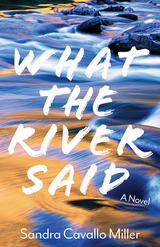 What the River Said: A Novel
sandra cavallo miller
University of Nevada Press, 2021 In her third book in the Dr. Abby Wilmore Series, Sandra Cavallo Miller weaves a new riveting tale of medical adventure and mystery, set amidst the splendor of the Grand Canyon
In this riveting third book of the Dr. Abby Wilmore series, Dr. Abby returns to her medical clinic in Grand Canyon National Park. Happy to be reunited with her staff and her partner, Dr. John Pepper, Abby is back treating park visitors and personnel as well as local residents. However, a wave of heart attacks among apparently healthy hikers creates a new puzzle, and soon there are rumors of people using performance-enhancing drugs. Abby’s situation deteriorates when a new female friend suddenly disappears, and Abby berates herself for missing the woman’s depression.
As Abby struggles with the disappearance of her friend, Dr. Pepper is preoccupied by a mysterious threat from his past and becomes badly
injured in an apparent fall. While he recuperates, Abby takes over much of the clinic work while they provide a home for Pepper’s troubled teenage niece and an adopted stray dog.
Abby soon discovers that there is something more sinister behind the recent troubling events. In this exhilarating follow-up to The Color of Rock and Where Light Comes and Goes, Abby must learn to confront her past in order to stand up for the ones she loves.
 What the Signs Say: Language, Gentrification, and Place-Making in Brooklyn
Shonna Trinch
Vanderbilt University Press Although we may not think we notice them, storefronts and their signage are meaningful, and the impact they have on people is significant. What the Signs Say argues that the public language of storefronts is a key component to the creation of the place known as Brooklyn, New York. Using a sample of more than two thousand storefronts and over a decade of ethnographic observation and interviews, the study charts two very different types of local Brooklyn retail signage. The unique and consistent features of many words, large lettering, and repetition that make up Old School signage both mark and produce an inclusive and open place. In contrast, the linguistic elements of New School signage, such as brevity and wordplay, signal not only the arrival of gentrification, but also the remaking of Brooklyn as distinctive and exclusive. Shonna Trinch and Edward Snajdr, a sociolinguist and an anthropologist respectively, show how the beliefs and ideas that people take as truths about language and its speakers are deployed in these different sign types. They also present in-depth ethnographic case studies that reveal how gentrification and corporate redevelopment in Brooklyn are intimately connected to public communication, literacy practices, the transformation of motherhood and gender roles, notions of historical preservation, urban planning, and systems of privilege. Far from peripheral or irrelevant, shop signs say loud and clear that language displayed in public always matters.
This book is the recipient of the 2021 Norman L. and Roselea J. Goldberg Prize from Vanderbilt University Press for the best book in the area of art or medicine.
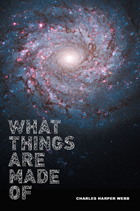 What Things Are Made Of
Charles Harper Webb
University of Pittsburgh Press, 2013
Charles Harper Webb is celebrated for his use of humor; yet even his funniest poems rise, as the best comedy must, out of deep human drives, sorrows, and needs. Powerful immersions in what it means to be human, these poems explore the spectrum of emotions from love to hate, tenderness to brutality. They can be withering and vulnerable in the same breath. Models of clarity and vividness, they are mysterious when they need to be, ranging from lyric to narrative, from realism to wild surreal flights, powered by a fierce, compassionate intelligence. Metaphors of startling aptness and originality, a voice at once endearing and provocative, high musicality, propulsive energy, wild imaginative leaps, as well as mastery of diction from lyricism to street-speak, create a reading experience of the first order. Uniformly fun to read, these poems go down easy, but pack a wallop. As Robert Frost said poetry should do, What Things Are Made Of "begins in delight and ends in wisdom."
 What Trouble I Have Seen: A History of Violence against Wives
David Peterson del Mar
Harvard University Press, 1996 It was 1869 and Sarah Moses, with "a very black eye," told her father: The world will never know what trouble I have seen. What she'd seen was violence at the hands of her husband. Does the world know any more of such things today than it did in Sarah's time?
Sarah, it so happens, lived in Oregon, that Edenic state on the Pacific Coast, and it is here that David Peterson del Mar centers his history of violence against wives. What causes such violence? Has it changed over time? How does it relate to the state of society as a whole? And how have women tried to stop it, resist it, escape it? These are the questions Peterson del Mar pursues, and the answers he finds are as fascinating as they are disturbing.
Thousands of thickly documented divorce cases from the Oregon circuit courts let us listen to voices who often go unheard. These are the people who didn't keep diaries or leave autobiographies, who sometimes could not write at all. Here they speak of a society that quietly condoned wife beating until the spread of an ethos of self-restraint in the late nineteenth century. And then, Peterson del Mar finds, the practice increased with a vengeance with the florescence of expressive individualism during the twentieth century.
What Trouble I Have Seen also traces a dramatic shift in wives' response to their husbands' violence. Settler and Native American women commonly fought abusive mates. Most wives of the late nineteenth century acted more cautiously and relied on others for protection. But twentieth-century privatism, Peterson del Mar discovers, often isolated modern wives from family and neighbors, casting abused women on the mercy of the police, women's shelters, and, most important, their own resources. Thus a new emphasis on self-determination, even as it stimulated violence among men, enhanced the ability of women to resist and escape violent husbands.
The first sustained history of violence toward wives, What Trouble I Have Seen offers remarkable testimony to the impact of social trends on the most private arrangements, and the resilience of women subject to a seemingly timeless crime.
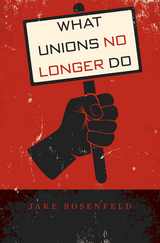 What Unions No Longer Do
Jake Rosenfeld
Harvard University Press, 2014 From workers’ wages to presidential elections, labor unions once exerted tremendous clout in American life. In the immediate post–World War II era, one in three workers belonged to a union. The fraction now is close to one in ten, and just one in twenty in the private sector—the lowest in a century. The only thing big about Big Labor today is the scope of its problems. While many studies have attempted to explain the causes of this decline, What Unions No Longer Do lays bare the broad repercussions of labor’s collapse for the American economy and polity.
Organized labor was not just a minor player during the “golden age” of welfare capitalism in the middle decades of the twentieth century, Jake Rosenfeld asserts. Rather, for generations it was the core institution fighting for economic and political equality in the United States. Unions leveraged their bargaining power to deliver tangible benefits to workers while shaping cultural understandings of fairness in the workplace. The labor movement helped sustain an unprecedented period of prosperity among America’s expanding, increasingly multiethnic middle class.
What Unions No Longer Do shows in detail the consequences of labor’s decline: curtailed advocacy for better working conditions, weakened support for immigrants’ economic assimilation, and ineffectiveness in addressing wage stagnation among African-Americans. In short, unions are no longer instrumental in combating inequality in our economy and our politics, and the result is a sharp decline in the prospects of American workers and their families.
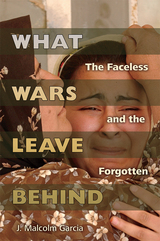 What Wars Leave Behind: The Faceless and the Forgotten
J. Malcolm Garcia
University of Missouri Press, 2014 They bear labels instead of names—noncombatant, unintended victim, collateral damage. Theirs are the blurred faces and forms seen in news footage shot from a moving vehicle. And when soldiers, media, and profiteers move on to the next conflict, they stay behind to cope amid the wreckage. They have stories to tell to anyone who will pause long enough to hear them. In What Wars Leave Behind, J. Malcolm Garcia reveals the people and pain behind the statistics. He writes about impoverished families scraping by in Cairo’s city of the dead, ordinary Syrians pretending all is well as shells explode around them, and others caught in conflicts that rage long after the cameramen have packed up and gone away. Garcia describes his travels in some of the world’s hotspots in Central Asia, the Middle East, and Africa. In a series of personal travel essays that read like short stories, he exposes the endless messiness of war and the failings of good intentions, and he traces their impact on the lives of natives in Afghanistan, Pakistan, Egypt, Kosovo, Chad, and Syria. He discovers amazing resilience among people who must struggle just to survive each day. Garcia gives readers the sort of gritty detail learned from immersing himself in other cultures. He eats the food, drinks the tea, and endures the oppressive heat. These are the stories of how a middle-class guy from the Midwest with a social work degree learned to experience and embrace the cultures of Third World countries in conflict—and lived to tell the tale.
 What Was African American Literature?
Kenneth W. Warren
Harvard University Press, 2012 African American literature is over. With this provocative claim Kenneth Warren sets out to identify a distinctly African American literature—and to change the terms with which we discuss it.
Rather than contest other definitions, Warren makes a clear and compelling case for understanding African American literature as creative and critical work written by black Americans within and against the strictures of Jim Crow America. Within these parameters, his book outlines protocols of reading that best make sense of the literary works produced by African American writers and critics over the first two-thirds of the twentieth century.
In Warren’s view, African American literature begged the question: what would happen to this literature if and when Jim Crow was finally overthrown? Thus, imagining a world without African American literature was essential to that literature. In support of this point, Warren focuses on three moments in the history of Phylon, an important journal of African American culture. In the dialogues Phylon documents, the question of whether race would disappear as an organizing literary category emerges as shared ground for critical and literary practice. Warren also points out that while scholarship by black Americans has always been the province of a petit bourgeois elite, the strictures of Jim Crow enlisted these writers in a politics that served the race as a whole.
Finally, Warren’s work sheds light on the current moment in which advocates of African American solidarity insist on a past that is more productively put behind us.
What Was Before
Martin Mosebach
Seagull Books, 2019 Martin Mosebach’s novel What Was Before opens with a young couple enjoying a moment of carefree intimacy. Then the young woman, turning slightly more serious, asks her lover that fateful question, one that sounds so innocent but carries toxic seeds of jealousy: What was your life like before you met me? The answer grows into an entire book, an elaborate house of cards, filled with intrigue, sex, betrayal, exotic birds, and far-flung locations.
Set against the backdrop of Frankfurt’s affluent suburbs, this elliptical tale of coincidence and necessity unfolds through a series of masterly constructed vignettes, which gradually come together to form a scintillating portrait of the funny, tender, and destructive guises that love between two people can assume and the effect it has on everyone around them. Hailed in Germany as the first great social novel of the twenty-first century, What Was Before is an Elective Affinities for our time.
 What Was Literary Impressionism?
Michael Fried
Harvard University Press, 2018 “My task which I am trying to achieve is, by the power of the written word, to make you hear, to make you feel—it is, before all, to make you see. That—and no more, and it is every-thing.” So wrote Joseph Conrad in the best-known account of literary impressionism, the late nineteenth- and early twentieth-century movement featuring narratives that paint pictures in readers’ minds. If literary impressionism is anything, it is the project to turn prose into vision.
But vision of what? Michael Fried demonstrates that the impressionists sought to compel readers not only to see what was described and narrated but also to see writing itself. Fried reads Conrad, Stephen Crane, Frank Norris, W. H. Hudson, Ford Madox Ford, H. G. Wells, Jack London, Rudyard Kipling, Erskine Childers, R. B. Cunninghame Graham, and Edgar Rice Burroughs as avatars of the scene of writing. The upward-facing page, pen and ink, the look of written script, and the act of inscription are central to their work. These authors confront us with the sheer materiality of writing, albeit disguised and displaced so as to allow their narratives to proceed to their ostensible ends.
What Was Literary Impressionism? radically reframes a large body of important writing. One of the major art historians and art critics of his generation, Fried turns to the novel and produces a rare work of insight and erudition that transforms our understanding of some of the most challenging fiction in the English language.
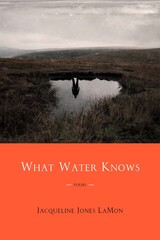 What Water Knows: Poems
Jacqueline Jones LaMon
Northwestern University Press, 2021 Jacqueline Jones LaMon delivers a stunning third collection that shows the elements of life that both unite us and create our greatest distances. What Water Knows transports the reader from drought to drowning, from the transatlantic Middle Passage to the breaking of water, from water wielded as a weapon to used as a reward. LaMon offers a labyrinth to understanding how we are all connected—through vibrant, searing images depicting the core of racism, betrayal, addiction, loss, climate change, and the ever-changing world in which we live.
LaMon’s skillful embodiment of character and her signature use of personae invite the reader to experience the unfathomable. Prepare to go over Niagara Falls in a barrel. Prepare to feel the force of a fire hose on your bare legs. Prepare to experience what happens when greed gets in the way of reason. What Water Knows is a canonical poetic achievement that will remind us of what it means to be human in a world that often forgets.
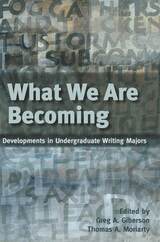 What We Are Becoming: Developments in Undergraduate Writing Majors
Greg Giberson and Thomas A. Moriarty
Utah State University Press, 2010 Greg Giberson and Tom Moriarty have collected a rich volume that offers a state-of-the-field look at the question of the undergraduate writing major, a vital issue for compositionists as the discipline continues to evolve. What We Are Becoming provides an indispensable resource for departments and WPAs who are building undergraduate majors.
Contributors to the volume address a range of vital questions for undergraduate programs, including such issues as the competition for majors within departments, the job market for undergraduates, varying focuses and curricula of such majors, and the formation of them in departments separate from English. Other chapters discuss the importance of flexibility, consider arguments for a rhetorical or civic discourse core for the writing major, address the relationship between rhetoric and composition majors, and review the role of multiliteracies in the major.
The field of composition has not come to a consensus on the shape, content, or focus of the undergradutate major. But as individual programs develop and refine their curricula, one thing has become clear: we must think about them in ways that go beyond our particular circumstances, theorize them in ways that secure their place on our campuses and in our discipline for years to come. What We Are Becoming is an effort to do just that.
What We Are Fighting For: A Radical Collective Manifesto
Edited by Federico Campagna and Emanuele Campiglio
Pluto Press, 2012 *Shortlisted for the Bread and Roses Prize, 2013*
From the pens of major figures of the anti-austerity movement, comes the first radical, collective manifesto of the new decade.
From participatory democracy to media reform, from direct action to communal living, What Are We Fighting For is a bold look at alternatives to the economic, social and political travesty of contemporary capitalism. Chapters from Owen Jones, David Graeber, John Holloway, Nina Power, Mark Fisher, Franco Berardi Bifo and Marina Sitrin show a multifaceted but collective desire for a better world.
Anarchists, communists, feminists and autonomists come together to inspire us to think beyond neoliberalism.
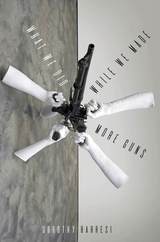 What We Did While We Made More Guns
Dorothy Barresi
University of Pittsburgh Press, 2018 The poems in What We Did While We Made More Guns investigate the place where economic failure meets a widening acculturation of violence—a kind of Great Acceleration of soul extinction set in this spectacularly uneasy moment in American history. Cutting, comic, sorrowful, at times terrified, at times resolute, the poems tilt along the high cliff’s edge of identity anxiety and American moral uncertainty, where each of us plays our part in the business of dispossession or resistance. Building themselves out of jazzed-up verbal velocities and wounded (in)sincerity, the poems counsel resilience against all forms of battery, mortal, spiritual, financial. They are pattern-makers in the dark. They talk back to God. They take into themselves what cannot be taken back: the news that forty-six million Americans have “slipped” below the poverty line; that guns discharge monstrously banal virility; that a black woman pulled over for a routine traffic violation dies by strangulation in her jail cell; that we buy and sell the myth of the American Dream as though our lives depended on it.
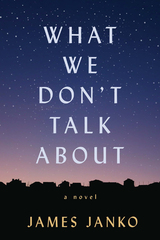 What We Don't Talk About
James Janko
University of Wisconsin Press, 2022 Orville, Illinois, is bucolic, charming, and almost Norman Rockwellesque—if you’re white. But like many midwestern cities in the 1960s, it is a “sundown” town—a place where Black Americans are prohibited from entering or remaining after dark.
The town’s most adventurous woman, Cassie Zeul, is an outcast because she has no husband and takes an occasional lover. Her son, Gus, guided by Sister Damien, aspires to be a priest, but he is increasingly overwhelmed by his infatuation with Pat Lemkey—who is herself drawn to Jenny Biel, considered by many to be the most beautiful girl in town. Gus’s best friend, Fenza Ryzchik Jr., a somewhat notorious bully desperate for his father’s attention, hates “colored people,” doesn’t think he knows any, and is certain he can convince Jenny to marry him one day—without realizing that her devout mother has been passing for white her entire life. Events come to a head when a visiting nun from the South brings an African American friend with her to Midnight Mass one Christmas Eve.
The dreams and desires of these characters collide and intersect as they navigate life and coming of age in the rural Midwest. In Janko’s masterful hands, the darkness—of prejudice, privilege, and power—that they don’t even recognize threatens to overwhelm their lives and their plans for the future. This novel forces us, as well as its characters, to acknowledge the cost of hiding our true selves, and of judging others based on the color of their skin or the longing of their hearts.
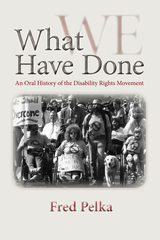 What We Have Done: An Oral History of the Disability Rights Movement
Fred Pelka
University of Massachusetts Press, 2012 Nothing about us without us has been a core principle of American disability rights activists for more than half a century. It represents a response by people with disabilities to being treated with scorn and abuse or as objects of pity, and to having the most fundamental decisions relating to their lives—where they would live; if and how they would be educated; if they would be allowed to marry or have families; indeed, if they would be permitted to live at all—made by those who were, in the parlance of the movement, "temporarily able-bodied."
In What We Have Done: An Oral History of the Disability Rights Movement, Fred Pelka takes that slogan at face value. He presents the voices of disability rights activists who, in the period from 1950 to 1990, transformed how society views people with disabilities, and recounts how the various streams of the movement came together to push through the Americans with Disabilities Act of 1990, the most sweeping civil rights legislation since passage of the Civil Rights Act of 1964. Beginning with the stories of those who grew up with disabilities in the 1940s and '50s, the book traces how disability came to be seen as a political issue, and how people with disabilities—often isolated, institutionalized, and marginalized—forged a movement analogous to the civil rights, women's rights, and gay rights movements, and fought for full and equal participation in American society.
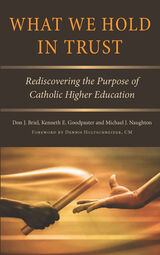 What We Hold in Trust: Rediscovering the Purpose of Catholic Higher Education
Don Briel
Catholic University of America Press, 2021 The specific concern in What We Hold in Trust comes to this: the Catholic university that sees its principal purpose in terms of the active life, of career, and of changing the world, undermines the contemplative and more deep-rooted purpose of the university. If a university adopts the language of technical and social change as its main and exclusive purpose, it will weaken the deeper roots of the university’s liberal arts and Catholic mission. The language of the activist, of changing the world through social justice, equality and inclusion, or of the technician through market-oriented incentives, plays an important role in university life. We need to change the world for the better and universities play an important role, but both the activist and technician will be co-opted by our age of hyper-activity and technocratic organizations if there is not first a contemplative outlook on the world that receives reality rather than constructs it.
To address this need for roots What We Hold in Trust unfolds in four chapters that will demonstrate how essential it is for the faculty, administrators, and trustees of Catholic universities to think philosophically and theologically (Chapter One), historically (Chapter Two) and institutionally (Chapters Three and Four). What we desperately need today are leaders in Catholic universities who understand the roots of the institutions they serve, who can wisely order the goods of the university, who know what is primary and what is secondary, and who can distinguish fads and slogans from authentic reform. We need leaders who are in touch with their history and have a love for tradition, and in particular for the Catholic tradition. Without this vision, our universities may grow in size, but shrink in purpose. They may be richer but not wiser.
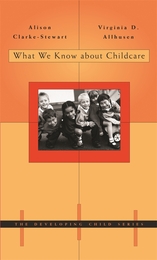 What We Know about Childcare
Alison Clarke-Stewart and Virginia D. Allhusen
Harvard University Press, 2005 Nearly three-quarters of American mothers work full- or part-time--usually out of financial necessity--and require regular child care. How do such arrangements affect children? If they are not at home with their mothers, will they be badly behaved, intellectually delayed, or emotionally stunted?
Backed by the best current research, Alison Clarke-Stewart and Virginia Allhusen bring a reassuring answer to parents' fears and offer guidance for making difficult decisions. Quality child care, they show, may be even more beneficial to children than staying at home. Although children who spend many hours in care may be unruly compared with children at home, those who attend quality programs tend to be cognitively ahead of their peers. They are just as attached to their mothers and reap the additional benefits of engaging with other children.
Ultimately, it's parents who matter most; what happens at home makes the difference in how children develop. And today's working mothers actually spend more time interacting with their children than stay-at-home mothers did a generation ago.
 What We Know, What We Wish: Maine Statehood, Historical Commemoration, and the Urgency of Public History
Edited by Liam Riordan and Richard W. Judd
University of Massachusetts Press, 2025 Cities, states, and nations are grappling with how best to commemorate historical events and anniversaries in ways that are fair, accurate, and open public dialogue about the often contested past. This volume springs from varied approaches to the historical commemoration of Maine’s state bicentennial in 2020 that involved academics, independent scholars, local and statewide cultural organizations, sovereign Wabanaki nations, and the state itself in the form of the Maine State Bicentennial Commission. While wide-ranging in their goals and values, all sought to take advantage of opportunities for collaboration to contribute to a dynamic and multi-faceted practice of public history. These new essays use Maine’s bicentennial as a focal point to put public history theory into action. Its diverse contributors share stories about the past that move beyond celebration to reflect crucial ways that the past shapes our understanding of the present and our aspirations for the future.
This volume’s core argument is that academics need to collaborate more fully with independent scholars, history-based cultural institutions, and the general public in order for public history to thrive and to improve the quality of civic life. What We Know, What We Wish does this through wide ranging essays that discuss the long statehood era in Maine from the 1770s to 1820s as well as its legacies in the state centennial commemoration of 1920 and museum exhibits from the 2020 bicentennial. The occupational and cultural diversity of the collection’s contributors together with the content of their essays offer a model for how to put public history principles into practice to foreground meaningful historical reflection that is urgently needed in divided communities around the world.
Contributors include the volume editors, as well as Maulian Bryant, Osihkiyol (Zeke) Crofton-Macdonald, Charles H. Lagerbom, Ryan LaRochelle, Stuart Kestenbaum, Michael McVaugh, Kevin D. Murphy, Micah A. Pawling, Jessica Skwire Routhier, Donald Soctomah, Laura Fecych Sprague, Alan Taylor, and Laurel Thatcher Ulrich.
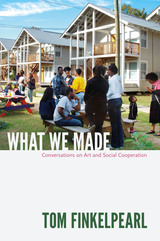 What We Made: Conversations on Art and Social Cooperation
Tom Finkelpearl
Duke University Press, 2013 In What We Made, Tom Finkelpearl examines the activist, participatory, coauthored aesthetic experiences being created in contemporary art. He suggests social cooperation as a meaningful way to think about this work and provides a framework for understanding its emergence and acceptance. In a series of fifteen conversations, artists comment on their experiences working cooperatively, joined at times by colleagues from related fields, including social policy, architecture, art history, urban planning, and new media. Issues discussed include the experiences of working in public and of working with museums and libraries, opportunities for social change, the lines between education and art, spirituality, collaborative opportunities made available by new media, and the elusive criteria for evaluating cooperative art. Finkelpearl engages the art historians Grant Kester and Claire Bishop in conversation on the challenges of writing critically about this work and the aesthetic status of the dialogical encounter. He also interviews the often overlooked co-creators of cooperative art, "expert participants" who have worked with artists. In his conclusion, Finkelpearl argues that pragmatism offers a useful critical platform for understanding the experiential nature of social cooperation, and he brings pragmatism to bear in a discussion of Houston's Project Row Houses. Interviewees. Naomi Beckwith, Claire Bishop, Tania Bruguera, Brett Cook, Teddy Cruz, Jay Dykeman, Wendy Ewald, Sondra Farganis, Harrell Fletcher, David Henry, Gregg Horowitz, Grant Kester, Mierle Laderman Ukeles, Pedro Lasch, Rick Lowe, Daniel Martinez, Lee Mingwei, Jonah Peretti, Ernesto Pujol, Evan Roth, Ethan Seltzer, and Mark Stern

What We Owe to Each Other
Scanlon T. M.
Harvard University Press, 1998 How do we judge whether an action is morally right or wrong? If an action is wrong, what reason does that give us not to do it? Why should we give such reasons priority over our other concerns and values? In this book, T. M. Scanlon offers new answers to these questions, as they apply to the central part of morality that concerns what we owe to each other. According to his contractualist view, thinking about right and wrong is thinking about what we do in terms that could be justified to others and that they could not reasonably reject. He shows how the special authority of conclusions about right and wrong arises from the value of being related to others in this way, and he shows how familiar moral ideas such as fairness and responsibility can be understood through their role in this process of mutual justification and criticism.
Scanlon bases his contractualism on a broader account of reasons, value, and individual well-being that challenges standard views about these crucial notions. He argues that desires do not provide us with reasons, that states of affairs are not the primary bearers of value, and that well-being is not as important for rational decision-making as it is commonly held to be. Scanlon is a pluralist about both moral and non-moral values. He argues that, taking this plurality of values into account, contractualism allows for most of the variability in moral requirements that relativists have claimed, while still accounting for the full force of our judgments of right and wrong.
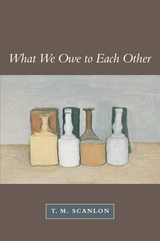 What We Owe to Each Other
T. M. Scanlon
Harvard University Press, 1998 “This magnificent book…opens up a novel, arresting position on matters that have been debated for thousands of years.” —Times Literary Supplement
How do we judge whether an action is morally right or wrong? If an action is wrong, what reason does that give us not to do it? Why should we give such reasons priority over our other concerns and values? In this book, T. M. Scanlon offers new answers to these questions, as they apply to the central part of morality that concerns what we owe to each other. According to his contractualist view, thinking about right and wrong is thinking about what we do in terms that could be justified to others and that they could not reasonably reject. He shows how the special authority of conclusions about right and wrong arises from the value of being related to others in this way, and he shows how familiar moral ideas such as fairness and responsibility can be understood through their role in this process of mutual justification and criticism.
Scanlon bases his contractualism on a broader account of reasons, value, and individual well-being that challenges standard views about these crucial notions. He argues that desires do not provide us with reasons, that states of affairs are not the primary bearers of value, and that well-being is not as important for rational decision-making as it is commonly held to be. Scanlon is a pluralist about both moral and non-moral values. He argues that, taking this plurality of values into account, contractualism allows for most of the variability in moral requirements that relativists have claimed, while still accounting for the full force of our judgments of right and wrong.
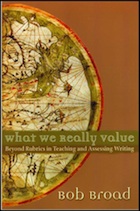 What We Really Value: Beyond Rubrics in Teaching and Assessing Writing
Bob Broad
Utah State University Press, 2003 What We Really Value traces the origins of traditional rubrics within the theoretical and historical circumstances out of which they emerged, then holds rubrics up for critical scrutiny in the context of contemporary developments in the field. As an alternative to the generic character and decontextualized function of scoring guides, he offers dynamic criteria mapping, a form of qualitative inquiry by which writing programs (as well as individual instructors) can portray their rhetorical values with more ethical integrity and more pedagogical utility than rubrics allow. To illustrate the complex and indispensable insights this method can provide, Broad details findings from his study of eighty-nine distinct and substantial criteria for evaluation at work in the introductory composition program at "City University." These chapters are filled with the voices of composition instructors debating and reflecting on the nature, interplay, and relative importance of the many criteria by which they judged students' texts. Broad concludes his book with specific strategies that can help writing instructors and programs to discover, negotiate, map, and express a more robust truth about what they value in their students' rhetorical performances.
 What We Teach When We Teach DH: Digital Humanities in the Classroom
Brian Croxall
University of Minnesota Press, 2023 Exploring how DH shapes and is in turn shaped by the classroom How has the field of digital humanities (DH) changed as it has moved from the corners of academic research into the classroom? And how has our DH praxis evolved through interactions with our students? This timely volume explores how DH is taught and what that reveals about the field of DH. While institutions are formally integrating DH into the curriculum and granting degrees, many instructors are still almost as new to DH as their students. As colleagues continue to ask what digital humanities is, we have the opportunity to answer them in terms of how we teach DH. The contributors to What We Teach When We Teach DH represent a wide range of disciplines, including literary and cultural studies, history, art history, philosophy, and library science. Their essays are organized around four critical topics at the heart of DH pedagogy: teachers, students, classrooms, and collaborations. This book highlights how DH can transform learning across a vast array of curricular structures, institutions, and education levels, from high schools and small liberal arts colleges to research-intensive institutions and postgraduate professional development programs. Contributors: Kathi Inman Berens, Portland State U; Jing Chen, Nanjing U; Lauren Coats, Louisiana State U; Scott Cohen, Stonehill College; Laquana Cooke, West Chester U; Rebecca Frost Davis, St. Edward’s U; Catherine DeRose; Quinn Dombrowski, Stanford U; Andrew Famiglietti, West Chester U; Jonathan D. Fitzgerald, Regis College; Emily Gilliland Grover, Notre Dame de Sion High School; Gabriel Hankins, Clemson U; Katherine D. Harris, San José State U; Jacob Heil, Davidson College; Elizabeth Hopwood, Loyola U Chicago; Hannah L. Jacobs, Duke U; Alix Keener, Stanford U; Alison Langmead, U of Pittsburgh; Sheila Liming, Champlain College; Emily McGinn, Princeton U; Nirmala Menon, Indian Institute of Technology; James O’Sullivan, U College Cork; Harvey Quamen, U of Alberta; Lisa Marie Rhody, CUNY Graduate Center; Kyle Roberts, Congregational Library and Archives; W. Russell Robinson, Alabama State U; Chelcie Juliet Rowell, Tufts U; Dibyadyuti Roy, U of Leeds; Asiel Sepúlveda, Simmons U; Andie Silva, York College, CUNY; Victoria Szabo, Duke U; Lik Hang Tsui, City U of Hong Kong; Annette Vee, U of Pittsburgh; Brandon Walsh, U of Virginia; Kalle Westerling, The British Library; Kathryn Wymer, North Carolina Central U; Claudia E. Zapata, UCLA; Benjun Zhu, Peking U. Retail e-book files for this title are screen-reader friendly.
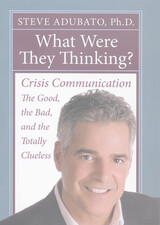 What Were They Thinking?: Crisis Communication: The Good, the Bad, and the Totally Clueless
Steve Adubato, Ph.D.
Rutgers University Press, 2008 Some corporations spend millions of dollars on so-called "crisis communication plans." Others offer lip service, avoiding the subject like the plague. They simply hope for the best, praying that they never face a crisis. Either way, as Steve Adubato says, "Wishful thinking is no substitute for a strategic plan." Nationally recognized communication coach and four-time Emmy Awardûwinning broadcaster Steve Adubato has been teaching, writing, and thinking about comm¡unication, leadership, and crisis communication for nearly two decades. In What Were They Thinking? Adubato examines twenty-two controversial and complex public relations and media mishaps, many of which were played out in public. Among cases and people discussed are: - The Johnson & Johnson Tylenol scare: Perhaps the best crisis management ever
- Don Imus: Sometimes saying "sorry" is too little too late
- Former Attorney General Alberto Gonzales: Authority does not put you above questioning
- Bill O'Reilly: Know when to stop defending yourself and save face
- Former EPA Administrator Christie Whitman: Proof that your written words can come back to haunt you
- Hurricane Katrina: A natural disaster that led to a larger governmental disaster
- The Catholic Church's pedophilia scandal: Denial won't get rid of the skeletons in your closet
Arranged in short chapters detailing each case individually, the book provides a brief history of the topics and answers the questions: Who got it right? Who got it wrong? What can the rest of us learn from them?
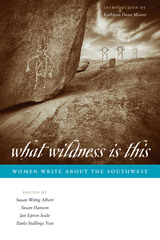 What Wildness Is This: Women Write about the Southwest
Edited by Susan Wittig Albert, Susan Hanson, Jan Epton Seale, and Paula Stallings Yost
University of Texas Press, 2007 Winner, WILLA Literary Award for Creative Nonfiction, 2008 How do women experience the vast, arid, rugged land of the American Southwest? The Story Circle Network, a national organization dedicated to helping women write about their lives, posed this question, and nearly three hundred women responded with original pieces of writing that told true and meaningful stories of their personal experiences of the land. From this deep reservoir of writing—as well as from previously published work by writers including Joy Harjo, Denise Chávez, Diane Ackerman, Naomi Shihab Nye, Leslie Marmon Silko, Gloria Anzaldua, Terry Tempest Williams, and Barbara Kingsolver—the editors of this book have drawn nearly a hundred pieces that witness both to the ever-changing, ever-mysterious life of the natural world and to the vivid, creative, evolving lives of women interacting with it. Through prose, poetry, creative nonfiction, and memoir, the women in this anthology explore both the outer landscape of the Southwest and their own inner landscapes as women living on the land—the congruence of where they are and who they are. The editors have grouped the writings around eight evocative themes: - The way we live on the land
- Our journeys through the land
- Nature in cities
- Nature at risk
- Nature that sustains us
- Our memories of the land
- Our kinship with the animal world
- What we leave on the land when we are gone
From the Gulf Coast of Texas to the Pacific Coast of California, and from the southern borderlands to the Great Plains and the Rocky Mountains, these intimate portraits of women's lives on the land powerfully demonstrate that nature writing is no longer the exclusive domain of men, that women bring unique and transformative perspectives to this genre.
What Women Want: Gender and Voting in Britain, Japan and the United States
Gill Steel
University of Michigan Press, 2022 What Women Want analyzes decades of voting preferences, values, and policy preferences to debunk some of the media and academic myths about gender gaps in voting and policy preferences. Findings show that no single theory explains when differences in women’s and men’s voting preferences emerge, when they do not, or when changes—or the lack thereof—occur over time. Steel extends existing theories to create a broader framework for thinking about gender and voting behavior to provide more analytical purchase in understanding gender and its varying effects on individual voters’ preferences. She incorporates the long-term effects of party identification and class politics on political decision-making, particularly in how they influence preferences on social provision and on expectations of the state. She also points to the importance of symbolic politics
 What Women Want: The Ideas of the Movement
Gayle Graham Yates
Harvard University Press, 1975 The women’s movement is perhaps the most baffling of the recent social reforms to sweep the United States. It is composed of numerous distinct groups, each with specific interests and goals, each with individual leaders and literature. What are the philosophies behind these groups? Who are their leaders and how have their ideas evolved? Do they have a vital connection with the women’s movement of the past? And where are feminist groups headed? In this study that brilliantly illuminates the literature and purposes of feminists, What Women Want: The Ideas of the Movement, Gayle Graham Yates has produced the first comprehensive history of feminist women’s groups.
Concentrating chiefly on the movement from 1959 to 1973, when it erupted in such activist groups as the National Organization for Women (NOW), the Women’s Equity Action League (WEAL), and the National Women’s Political Caucus (NWPC), the author analyzes in detail their literature, factions, and issues. Her survey encompasses virtually every major expression of the movement’s multiple facets, from The Feminine Mystique, Born Female, and Sexual Politics, to Sex and the Single Girl and Memoirs of an Ex-Prom Queen. In a significant breakthrough, the author discerns the pattern underlying this diversity, which should contribute to a fuller understanding of future developments in the women’s struggle. She accomplishes this by identifying three key attitudes informing the movement: the feminist, the women’s liberationist, and the androgynous or cooperative male–female relationship.
The author provides a sensitive, yet critical analysis of the chief spokeswomen in contemporary America, activists like Gloria Steinem, Shulamith Firestone, and Ti-Grace Atkinson. She treats each of the feminist ideologies with balance and respect, yet is refreshingly unafraid to criticize new developments. She bolsters her own conclusions in support of an androgynous or “equal sexual society” with a judicious spirit. Scholars and the general public alike will find Yates’s book not only an indispensable contribution to women’s studies, but also a strong and timely addition to contemporary American life and thought.
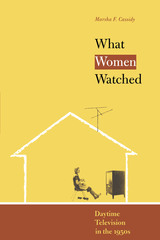 What Women Watched: Daytime Television in the 1950s
By Marsha F. Cassidy
University of Texas Press, 2005 In this pathfinding book, based on original archival research, Marsha F. Cassidy offers the first thorough analysis of daytime television's earliest and most significant women's genres, appraising from a feminist perspective what women watched before soap opera rose to prominence. After providing a comprehensive history of the early days of women's programming across the nation, Cassidy offers a critical discussion of the formats, programs, and celebrities that launched daytime TV in America—Kate Smith's variety show and the famed singer's unsuccessful transition from patriotic radio star to 1950s TV idol; the "charm boys" Garry Moore, Arthur Godfrey, and Art Linkletter, whose programs honored women's participation but in the process established the dominance of male hosts on TV; and the "misery shows" Strike It Rich and Glamour Girl and the controversy, both critical and legal, they stirred up. Cassidy then turns to NBC's Home show, starring the urbane Arlene Francis, who infused the homemaking format with Manhattan sophistication, and the ambitious daily anthology drama Matinee Theater, which strove to differentiate itself from soap opera and become a national theater of the air. She concludes with an analysis of four popular audience participation shows of the era—the runaway hit Queen for a Day; Ralph Edwards's daytime show of surprises, It Could Be You; Who Do You Trust?, starring a youthful Johnny Carson; and The Big Payoff, featuring Bess Myerson, the country's first Jewish Miss America. Cassidy's close feminist reading of these shows clearly demonstrates how daytime TV mirrored the cultural pressures, inconsistencies, and ambiguities of the postwar era.
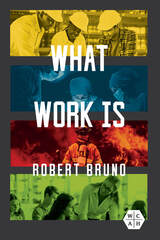 What Work Is
Robert Bruno
University of Illinois Press, 2024 A distinctive exploration of how workers see work For more than twenty years, Robert Bruno has taught labor history and labor studies to union members from a wide range of occupations and demographic groups. In the class, he asked his students to finish the question “Work is—?” in six words or less. The thousands of responses he collected provide some of the rich source material behind What Work Is. Bruno draws on the thoughts and feelings experienced by workers in the present day to analyze how we might design a future of work. He breaks down perceptions of work into five categories: work and time; the space workers occupy; the impact of work on our lives; the sense of purpose that motivates workers; and the people we work for, in all senses of the term. Far-seeing and sympathetic, What Work Is merges personal experiences with research, poetry, and other diverse sources to illuminate workers’ lives in the present and envision what work could be in the future.
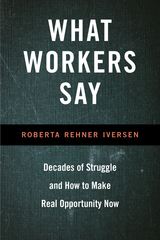 What Workers Say: Decades of Struggle and How to Make Real Opportunity Now
Roberta Rehner Iversen
Temple University Press, 2022 What have jobs really been like for the past 40 years and what do the workers themselves say about them? In What Workers Say, Roberta Iversen shows that for employees in labor market industries—like manufacturing, construction, printing—as well as those in service-producing jobs, like clerical work, healthcare, food service, retail, and automotive—jobs are often discriminatory, are sometimes dangerous and exploitive, and seldom utilize people’s full range of capabilities. Most importantly, they fail to provide any real opportunity for advancement. What Workers Say takes its cue from Studs Terkel’s Working, as Iversen interviewed more than 1,200 workers to present stories about their labor market jobs since 1980. She puts a human face on the experiences of a broad range of workers indicating what their jobs were and are truly like. Iversen reveals how transformations in the political economy of waged work have shrunk or eliminated opportunity for workers, families, communities, and productivity. What Workers Say also offers an innovative proposal for compensated civil labor that could enable workers, their communities, labor market organizations, and the national infrastructure to actually flourish.
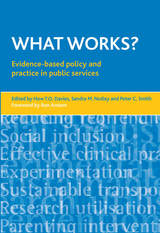 What Works?: Evidence-Based Policy and Practice in Public Services
Edited by Huw T. O. Davies, Sandra M. Nutley, and Peter C. Smith
Bristol University Press, 2000 What counts is what works - but how can we actually tell what works? And what can we do with such knowledge to influence policy and practice?
As all parts of the public sector embrace 'evidence' as a means of providing more effective and effcient public services, this book provides a timely and novel contribution to such debates.
The authors consider the role of evidence in specific public policy areas (healthcare, education, criminal justice, social care, welfare, housing, transport and urban renewal), using experts in each field to explore the creation, dissemination and use of evidence within each. They consider in particular:
•How is research evidence of service effectiveness created?
•How does such evidence shape policy and influence service delivery?
•What efforts are being made to encourage greater utilisation of evidence in policy and practice?
The rich cross-sectoral accounts of the many and diverse activities in each sector provide an insight into the ebb and flow of evidence as guidance to policy and practice. 'What works?' develops perceptive analyses of outstanding problems, and raises challenging agendas for service development and future research.
The authors conclude with the all-important question of the implementation of evidence-based practice and lead the way to the reinvigoration of innovative thinking.
With its relevance to both cutting-edge practice and research, this book is important reading for a wide range of managers and professionals in different sectors, as well as students and academics studying public policy, public administration, and social policy and management.
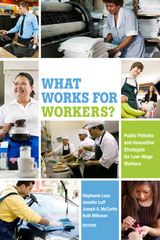 What Works for Workers?: Public Policies and Innovative Strategies for Low-Wage Workers
Stephanie Luce
Russell Sage Foundation, 2014 The majority of new jobs created in the United States today are low-wage jobs, and a fourth of the labor force earns no more than poverty-level wages. Policymakers and citizens alike agree that declining real wages and constrained spending among such a large segment of workers imperil economic prosperity and living standards for all Americans. Though many policies to assist low-wage workers have been proposed, there is little agreement across the political spectrum about which policies actually reduce poverty and raise income among the working poor. What Works for Workers provides a comprehensive analysis of policy measures designed to address the widening income gap in the United States. Featuring contributions from an eminent group of social scientists, What Works for Workers evaluates the most high-profile strategies for poverty reduction, including innovative “living wage” ordinances, education programs for African American youth, and better regulation of labor laws pertaining to immigrants. The contributors delve into an extensive body of scholarship on low-wage work to reveal a number of surprising findings. Richard Freeman suggests that labor unions, long assumed to be moribund, have a fighting chance to reclaim their historic redistributive role if they move beyond traditional collective bargaining and establish new ties with other community actors. John Schmitt predicts that the Affordable Care Act will substantially increase insurance coverage for low-wage workers, 38 percent of whom currently lack any kind of health insurance. Other contributors explore the shortcomings of popular solutions: Stephanie Luce shows that while living wage ordinances rarely lead to job losses, they have not yet covered most low-wage workers. And Jennifer Gordon corrects the notion that a path to legalization alone will fix the plight of immigrant workers. Without energetic regulatory enforcement, she argues, legalization may have limited impact on the exploitation of undocumented workers. Ruth Milkman and Eileen Appelbaum conclude with an analysis of California’s paid family leave program, a policy designed to benefit the working poor, who have few resources that allow them to take time off work to care for children or ill family members. Despite initial opposition, the paid leave program proved more acceptable than expected among employers and provided a much-needed system of wage replacement for low-income workers. In the wake of its success, the initiative has emerged as a useful blueprint for paid leave programs in other states. Alleviating the low-wage crisis will require a comprehensive set of programs rather than piecemeal interventions. With its rigorous analysis of what works and what doesn’t, What Works for Workers points the way toward effective reform. For social scientists, policymakers, and activists grappling with the practical realities of low-wage work, this book provides a valuable guide for narrowing the gap separating rich and poor.
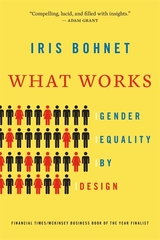 What Works: Gender Equality by Design
Iris Bohnet
Harvard University Press, 2016 Shortlisted for the Financial Times and McKinsey Business Book of the Year Award
A Financial Times Best Business Book of the Year
A Times Higher Education Book of the Week
Best Business Book of the Year, 800-CEO-READ
Gender equality is a moral and a business imperative. But unconscious bias holds us back, and de-biasing people’s minds has proven to be difficult and expensive. By de-biasing organizations instead of individuals, we can make smart changes that have big impacts. Presenting research-based solutions, Iris Bohnet hands us the tools we need to move the needle in classrooms and boardrooms, in hiring and promotion, benefiting businesses, governments, and the lives of millions.
“Bohnet assembles an impressive assortment of studies that demonstrate how organizations can achieve gender equity in practice…What Works is stuffed with good ideas, many equally simple to implement.”
—Carol Tavris, Wall Street Journal
“A practical guide for any employer seeking to offset the unconscious bias holding back women in organizations, from orchestras to internet companies.”
—Andrew Hill, Financial Times
What Would It Take to Make an Ed School Great?: Voices from an Unfinished Revolution
John Schwille
Michigan State University Press, 2023 This book brings new life to the long-standing debate in the United States over whether teacher education, K–12 teaching, and the role that universities play in this work can be revolutionized so that they are less subject to self-defeating conventions and orthodoxy, to the benefit of all the nation’s children. Author John Schwille reexamines the ambitious reform agenda that Michigan State University teacher education leaders brought to the national table in the 1980s and 1990s. This attempted revolution mobilized unprecedented resources to the struggle to transform teaching and learning of subject matter. Conveying this history through the words of the teachers and scholars responsible for it, Schwille shows that a great deal was achieved, but many of the lessons learned continue to be ignored.
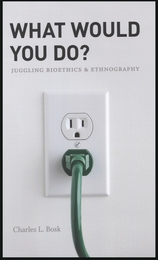 What Would You Do?: Juggling Bioethics and Ethnography
Charles L. Bosk
University of Chicago Press, 2008 In hospital rooms across the country, doctors, nurses, patients, and their families grapple with questions of life and death. Recently, they have been joined at the bedside by a new group of professional experts, bioethicists, whose presence raises a host of urgent questions. How has bioethics evolved into a legitimate specialty? When is such expertise necessary? How do bioethicists make their decisions? And whose interests do they serve?
Renowned sociologist Charles L. Bosk has been observing medical care for thirty-five years. In What Would You Do? he brings his extensive experience to bear on these questions while reflecting on the ethical dilemmas that his own ethnographic research among surgeons and genetic counselors has provoked. Bosk considers whether the consent given to ethnographers by their subjects can ever be fully voluntary and informed. He questions whether promises of confidentiality and anonymity can or should be made. And he wonders if social scientists overestimate the benefits of their work while downplaying the risks.
Vital for practitioners of both the newly prominent field of bioethics and the long-established craft of ethnography, What Would You Do? will also engross anyone concerned with how our society addresses difficult health care issues.
What You Are Now Enjoying
Sarah Gerkensmeyer
Autumn House Press, 2013 In this first story collection, Gerkensmeyer crafts broken fairy tales that reimagine the life of women.
What You See in the Dark: A Novel
Manuel Muñoz and Charles Taylor
Northwestern University Press, 2025 A doomed love story unfolds alongside the production of Psycho in 1950s Bakersfield, California Muñoz’s debut novel tells the story of Teresa, an aspiring singer too far away from Los Angeles to share the city’s glamour. In Dan Watson, the most desirable man in town, she believes she has found someone to help her realize those dreams. But when a famous actress arrives from Hollywood with a legendary director in tow, local gossip about Teresa and Dan turns to speculation about the celebrity visitors there to work on what will become an iconic, groundbreaking film of madness and murder at a roadside motel: Alfred Hitchcock’s Psycho. Framed by a foreword from film critic Charles Taylor, Muñoz’s haunting tale reflects “the slow winding down of everything that once seemed certain.”
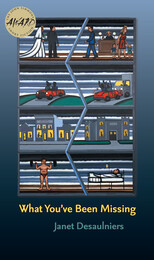 What You've Been Missing
Janet Desaulniers
University of Iowa Press, 2004 Populated by characters as frank as their midwestern settings, What You’ve Been Missing, Janet Desaulniers’s debut collection, explores the unsettling moments when ordinary life ceases to exist. Parents, confused by their five-year-old’s refusal to sit up in her chair, lift her blouse to find she’s been beaten. A woman returns from a shopping trip just in time to see her husband kissing a young co-worker. A young husband constructs an elaborate and romanticized version of his new marriage and then ruins it in one gesture. These singular moments propel each person on a journey beyond the realm of everyday existence.
Vividly portraying the possible horrors and detours that can mark anyone’s life, Desaulniers beautifully captures the vast and often conflicting emotions that humans endure at times of loss and sorrow—loneliness, pain, desperation, desire. Yet this balletic push and pull of emotions will challenge, wound, and ultimately enlighten her characters, transporting them to a place beyond individual sorrow.
At times unbearably heartbreaking, What You’ve Been Missing is not just another set of stories about bad things happening to good people. At its heart, this award-winning collection is about people continuing to talk—rather than shutting down—as bad things happen to them. As the recently divorced Liza thinks in “The Good Fight”: “Words do ease us. They comfort us. Maybe they protect us in a way, rescue us from the agony of what our bodies feel.”
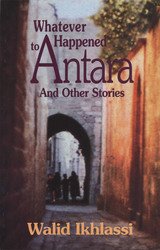 Whatever Happened to Antara?: And Other Stories
By Walid Ikhlassi
University of Texas Press, 2004 Walid Ikhlassi evokes the individual's struggle for dignity and significance in the Syrian city of Aleppo during the French mandate of the forties and fifties. His characters' seeking of personal fulfillment parallels the struggle of the nation for self-definition. The changing political and cultural landscape of Syria challenges individuals in their attempts to live lives of integrity, as Ikhlassi provides analytical insights into the civil society of Syria, the axis of his writing. From the boy Antara who personifies the Arab legend of a half-African slave warrior/hero to everyday middle-aged lovers, Ikhlassi's characters fight colonial oppression and corruption from the newly formed government. Foreign and internal forces challenge the evolution of a modern nation rooted in traditional Arab values. Its strong and determined men and women refuse to accept victimhood. The introduction by author and critic Elizabeth Warnock Fernea places the stories in their historical and literary context. An avowed experimentalist, Ikhlassi portrays the modern human situation through techniques as widely divergent as realism, surrealism, interior monologue, and stream-of-consciousness. Selections of his work have been translated into English, Russian, French, German, Dutch, Armenian, and other languages.
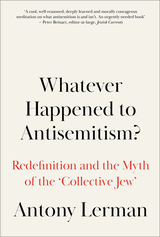 Whatever Happened to Antisemitism?: Redefinition and the Myth of the 'Collective Jew'
Antony Lerman
Pluto Press, 2020 'This elegantly written, erudite book is essential reading for all of us, whatever our identifications' - Lynne Segal
Antisemitism is one of the most controversial topics of our time. The public, academics, journalists, activists and Jewish people themselves are divided over its meaning. Antony Lerman shows that this is a result of a 30-year process of redefinition of the phenomenon, casting Israel, problematically defined as the 'persecuted collective Jew', as one of its main targets.
This political project has taken the notion of the 'new antisemitism' and codified it in the flawed International Holocaust Remembrance Alliance's 'working definition' of antisemitism. This text is the glue holding together an international network comprising the Israeli government, pro-Israel advocacy groups, Zionist organizations, Jewish communal defence bodies and sympathetic governments fighting a war against those who would criticize Israel.
The consequences of this redefinition have been alarming, supressing free speech on Palestine/Israel, legitimizing Islamophobic right-wing forces, and politicizing principled opposition to antisemitism.
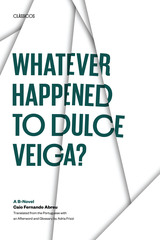 Whatever Happened to Dulce Veiga?: A B-Novel
By Caio Fernando Abreu
University of Texas Press, 2001 A forty-year-old Brazilian journalist reduced to living in a dilapidated building inhabited by a bizarre human fauna—fortune-tellers, transvestites, tango-loving Argentinean hustlers—is called upon to track down and write the story of Dulce Veiga, a famous singer who disappeared twenty years earlier on the eve of her first big show. Thus begins a mad race through an underground, nocturnal São Paulo among rock bands with eccentric names, feline reincarnations of Vita Sackville-West, ex-revolutionaries turned junkies, gay Pietas, echoes of Afro-Brazilian religions, and intimations of AIDS . . . Constructed like a mystery, the novel unravels over a week, evoking a decadent and contaminated atmosphere in which the journalist's own search for meaning finds its expression in the elusive Dulce Veiga, who constantly appears to him as if in a dream, her arm pointing heavenward. Whatever Happened to Dulce Veiga? is a descent into the underworld of contemporary megalopolises where, like the inside of a huge TV, life intermingles with bits of music, film clips, and soap opera characters in a crazy and macabre dance, moving toward a possible catharsis.
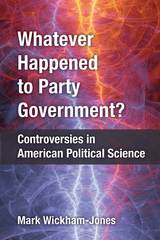 Whatever Happened to Party Government?: Controversies in American Political Science
Mark Wickham-Jones
University of Michigan Press, 2018 In 1950, the Committee on Political Parties of the American Political Science Association (APSA) published its much-anticipated report, Toward a More Responsible Two-Party System. Highly critical of the existing state of affairs, the report became extremely controversial: before publication, scholars attacked the committee’s draft and suggested it should be suppressed. When released it received a barrage of criticisms. Most academics concluded it was an ill-conceived and mistaken initiative.
Mark Wickham-Jones provides the first full, archival-based assessment of the arguments within APSA about political parties and the 1950 report. He details the report’s failure to generate wider discussion between media, politicians, and the White House. He examines whether it was dominated by a dogmatic attachment to “party government,” and charts the relationship between behavioralists and institutionalists. He also discusses the political dimension to research during the McCarthyite years, and reflects on the nature of American political science in the years after 1945, the period in which behavioralism (which privileges the influence of individuals over institutions) became dominant.
Detailing APSA’s most direct and significant intervention in the political process, Wickham-Jones makes an important contribution to debates that remain in the forefront of discussions about American politics.
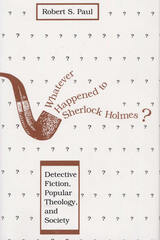 Whatever Happened to Sherlock Holmes?: Detective Fiction, Popular Theology, and Society
Robert S. Paul
Southern Illinois University Press, 1991 Robert S. Paul suggests that the reason detective fiction has won legions of readers may be that "the writer of detective fiction, without conscious intent, appeals directly to those moral and spiritual roots of society unconsciously affirmed and endorsed by the readers." Because detective stories deal with crime and punishment they cannot help dealing implicitly with theological issues, such as the reality of good and evil, the recognition that humankind has the potential for both, the nature of evidence (truth and error), the significance of our existence in a rational order and hence the reality of truth, and the value of the individual in a civilized society. Paul argues that the genre traces its true beginning to the Enlightenment and documents two related but different reactions to the theological issues involved: first, a line of writers who are generally positive in relation to their cultural setting, such as Edgar Allan Poe, Wilkie Collins, Conan Doyle; and second, a reactionary strain, critical of the prevailing culture, that begins in William Godwin’s Caleb Williams and continues through the anti-heroic writers like Arsène Lupin to Raymond Chandler, Dashiell Hammett, and John MacDonald.
What's a Coal Miner to Do?: The Mechanization of Coal Mining
Keith Dix
University of Pittsburgh Press, 1988 For more than one hundred years, until the 1920s, coal production involved blasting a seam of coal and loading it by had into a mine car. In the late 1920s, operators introduced machines into the mines, including the coal loader. In this book, Keith Dix explores the impact of technology on miners and operators during a crucial period in industrial history. Dix reconstructs the social, political, technical and economic environment of the “hand-loading” era and then views the evolution of mechanical coal technology, including the inventions of Joseph Joy. He also examines the rise of the United Mine Workers under John L. Lewis, and the expanded role of the state under New Deal legislation and regulations.
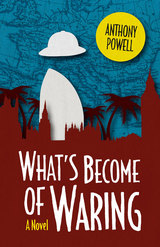 What's Become of Waring: A Novel
Anthony Powell
University of Chicago Press, 2014 Unsavory artists, titled boobs, and charlatans with an affinity for Freud—such are the oddballs whose antics animate the early novels of the late British master Anthony Powell. A genius of social satire delivered with a very dry wit, Powell builds his comedies on the foibles of British high society between the wars, delving into subjects as various as psychoanalysis, the film industry, publishing, and (of course) sex. More explorations of relationships and vanity than plot-driven narratives, these slim novels reveal the early stirrings of the unequaled style, ear for dialogue, and eye for irony that would reach their caustic peak in Powell’s epic A Dance to the Music of Time.
In What’s Become of Waring, Powell lampoons a world with which he was intimately acquainted: the inner workings of a small London publisher. But even as Powell eviscerates the publishers’ less than scrupulous plotting in his tale of wild coincidences, mistaken identity, and romance, he never strays to the far side of farce.
Written from a vantage point both high and necessarily narrow, Powell’s early novels nevertheless deal in the universal themes that would become a substantial part of his oeuvre: pride, greed, and what makes people behave as they do. Filled with eccentric characters and piercing insights, Powell’s work is achingly hilarious, human, and true.
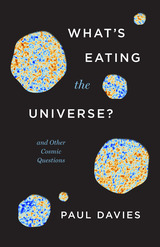 What's Eating the Universe?: And Other Cosmic Questions
Paul Davies
University of Chicago Press, 2021 Combining the latest scientific advances with storytelling skills unmatched in the cosmos, an award-winning astrophysicist and popular writer leads us on a tour of some of the greatest mysteries of our universe.
In the constellation of Eridanus, there lurks a cosmic mystery: It’s as if something has taken a huge bite out of the universe. But what is the culprit? The hole in the universe is just one of many puzzles keeping cosmologists busy. Supermassive black holes, bubbles of nothingness gobbling up space, monster universes swallowing others—these and many other bizarre ideas are being pursued by scientists. Due to breathtaking progress in astronomy, the history of our universe is now better understood than the history of our own planet. But these advances have uncovered some startling riddles. In this electrifying new book, renowned cosmologist and author Paul Davies lucidly explains what we know about the cosmos and its enigmas, exploring the tantalizing—and sometimes terrifying—possibilities that lie before us.
As Davies guides us through the audacious research offering mind-bending solutions to these and other mysteries, he leads us up to the greatest outstanding conundrum of all: Why does the universe even exist in the first place? And how did a system of mindless, purposeless particles manage to bring forth conscious, thinking beings? Filled with wit and wonder, What’s Eating the Universe? is a dazzling tour of cosmic questions, sure to entertain, enchant, and inspire us all.
|
|
